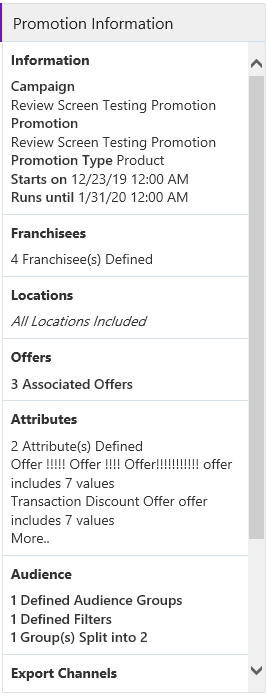5 Promotions
Overview
In Customer Engagement, a Promotion defines an offer, within a Campaign, that is intended to provide some purchase incentive to Customers. These offers may be made available to all Customers, or they may be offered only to a specified subsets of Customers. These offers may provide price incentives on a specific item, they may provide coupons to be redeemed during a purchase, they may be messages notifying Customers of special events or pricing, or they may provide tender certificates that a Customer can use at a later date.
Promotion Search
To search for a promotion use the following steps:
-
Click the Menu icon.
-
Click the Campaign Task.
-
Click the Promotion Search Task.
Figure 5-1 Promotion Search

-
Enter any or all of the following information to conduct a search. The Search pane contains the following filters:
-
Promotion ID – Returns the exact ID match of the Promotion. No partial IDs or wild cards may be used.
-
Campaign – Filters the list by the name of the Promotion. The default filter is all.
-
Status – Filters the List by the current Promotion Status. This filter has the following options:
-
All - [DEFAULT] Do not filter by Status; display all Statuses
-
Approved - Display only Approved Promotions.
-
Clear - Display only Promotions that have been cleared.
-
Conflict - Display only Promotions with conflicts.
-
Saved - Display only Saved Promotions.
-
Terminated - Display only Terminated Promotions.
-
-
Type – Filters the List by the Type of Promotion. This filter has the following options:
-
All - [DEFAULT] Do not filter by Type; display all Promotion Types.
-
Award - Display only Award Promotions.
-
Coupon - Display only Coupon Promotions.
-
Message - Display only Message Promotions.
-
Points - Display only Points Promotions.
-
Points for Marketing Engagements - Display only Points for Marketing Engagements only.
-
Points for Purchase - Display only Points for Purchase Promotions.
-
Product - Display only Product Promotions.
-
-
Loyalty Bounceback Type - Filter the list by the type of Loyalty Bounceback.
Note: This filter is activated when the types Coupon or Product are selected. See Loyalty Bounceback for information on how to use this filter.
-
None [DEFAULT]
-
Bonus Points
-
Entitlements
-
-
Exported – Filter the List by whether the promotion definition or data has been exported. This filter has the following options:
-
All - [DEFAULT] Do not filter by Export status; display both exported and unexported Promotions
- Yes - Display only exported Promotions
- No - Display only Promotions that have not been exported
-
-
Attribute Type – The type of attribute.
-
Attribute Value – This is a dynamic field based on the attribute previously entered.
-
Franchisee ID – This Text Field searches for Promotions by the Franchisee associated with the Promotion. The Franchisee ID criteria is only visible if the
EnableFranchiseSupportconfiguration is enabled. Only Franchisees associated with the user is displayed. This will default to All. -
Coupon Code – Coupon code associated with the Promotion.
-
Created By – List Box with list of associates who created available Promotions. This will default to Everyone.
-
Generated – Indicates whether the target data for the promotion has been generated.
-
All [DEFAULT]
-
Yes
-
No
-
-
-
Click Search -
Note:
Reset clears all fields and returns the list values to the default selections.
Figure 5-2 Promotion Search Results
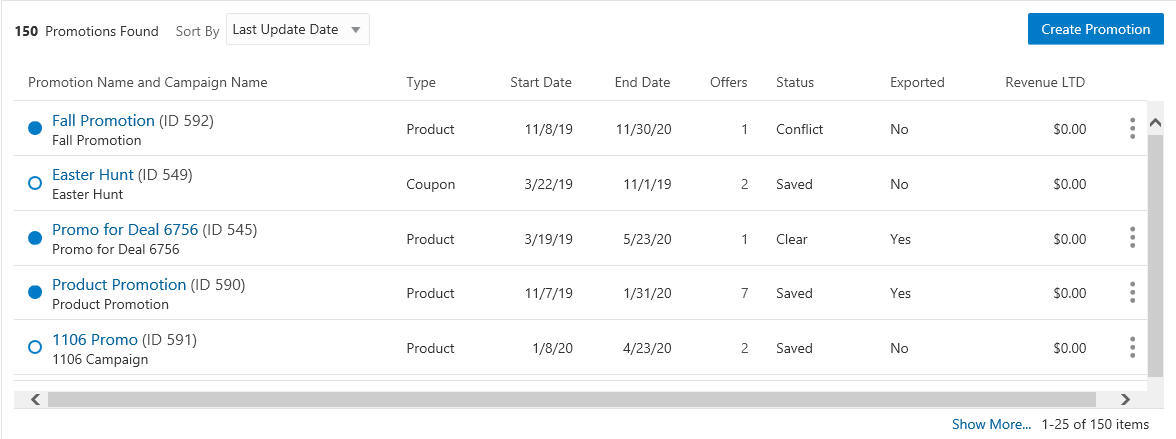
Loyalty Bounceback
The Loyalty Bounceback filter appears when a Coupon type or Product type filter is selected. This enables you to view coupon promotions and or product promotions that include a loyalty bounceback.
Figure 5-3 Loyalty Bounceback Type
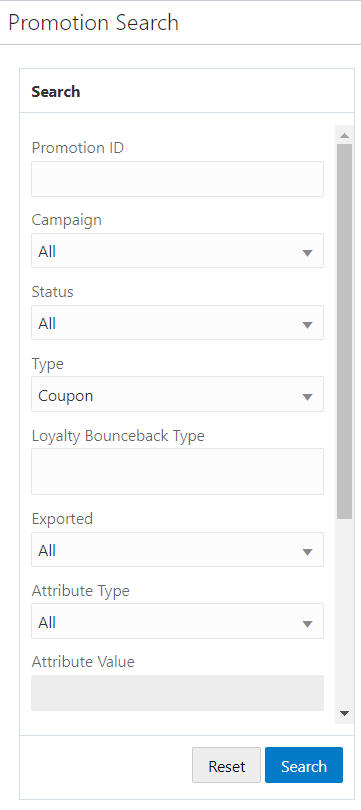
The Loyalty Bounceback filter is a multi-select box. Choose one or more filter options as shown in Figures Figure 5-4, Figure 5-5, Figure 5-6, and Figure 5-7. Click X in any selected filter to remove that option.
Figure 5-4 Loyalty Bounceback Type Filter Options

Figure 5-5 Multi-Select Options - Single Option
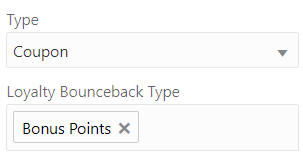
Figure 5-6 Multi-Select - Adding Additional Options
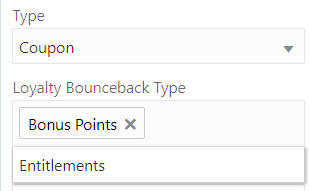
Figure 5-7 Multi-Select - All Options Selected

Working with Promotion Results
The results will indicate the number of promotions found displayed in a table. Fields include:
-
Promotion Name and Campaign Name – The promotion and campaign name. Click the name to view the Promotion Scorecard for the promotion.
-
Type – The type of promotion.
-
Start Date – The start date of the promotion.
-
End Date – The end date of the promotion.
-
Offers – The number of offers associated with the promotion.
-
Status – The status of the promotion.
-
Exported – Whether or not the promotion was exported.
-
Revenue LTD – Revenue Lifetime to Date (LTD) of the promotion.
You can sort by:
-
Last Update Date
-
Promotion Name
-
Promotion ID
-
Campaign Name
-
Type
-
Status
-
Exported
-
Revenue LTD
Promotion results can be sorted ascending or descending.
Note:
The results pane shows the first 25 results. Click the Show More… link to see the next 25 results.
Viewing a Promotion
There are three places that a user can find the View option in order to view a Promotion:
Figure 5-8 Overflow Menu

-
Select View under the Action Menu (also known as the Overflow Menu) icon for each individual Promotion on the Promotion Advanced Search window.
-
Select View in the Overflow Menu on each individual Promotion on the Promotion List window (which displays in the Promotion Home menu).
-
Select View in the Overflow Menu for the individual Promotion on the Promotion Scorecard.
The View Promotion window displays:
Figure 5-9 VIew Promotion
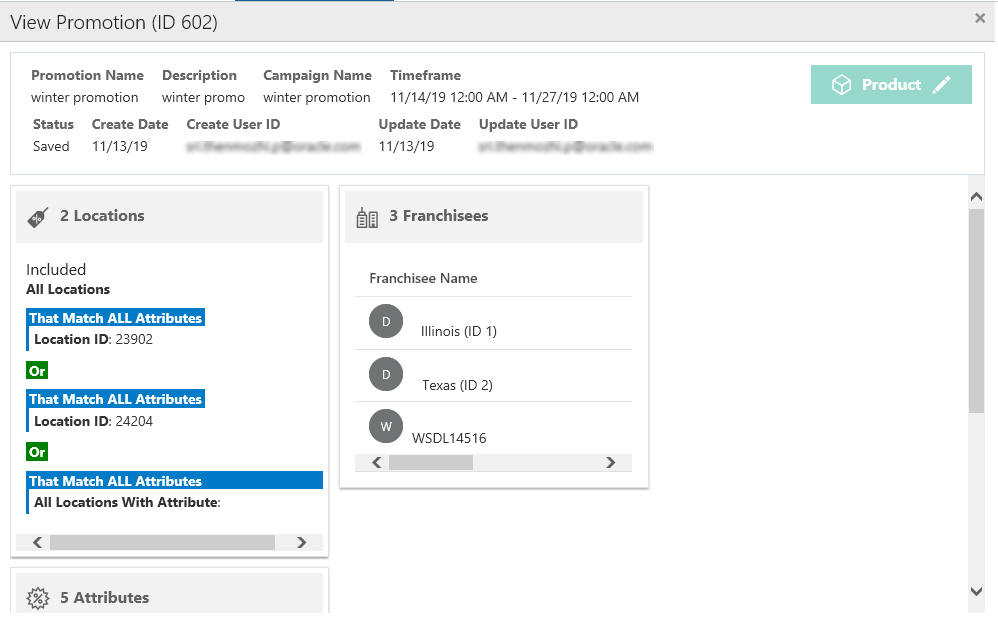
The information displayed will depend upon the configuration for a Promotion.
-
Display Bar
-
Promotion Name
-
POS Name
-
Description
-
Campaign Name
-
Timeframe
-
Promotion Type
-
Status
-
Create Date
-
Create User ID
-
Update Date
-
Update User ID
-
-
Cards - In the Review panel, the individual sections are called "Cards", which display details added to some of the tabs during Promotion setup. Some of those cards may be:
-
Locations
-
Attributes
-
Franchisees
-
Offers
-
Audience
-
Budget
-
Loyalty Program Levels and Loyalty Cards
-
Note:
At any time click the Pencil icon to go into the edit mode, see Editing a Promotion for more information. You can also click the X icon to close the promotion.
Viewing Promotions - Marketing Engagements
Once a Marketing Event is created, it needs to be activated. The following message appears on Marketing Engagements to assist the user setting the event. The message reads: To trigger this event, use the Promotion ID, Offer ID and postEngagementAction service. Refer to the Web Services Guide for more information.
Figure 5-10 Trigger Event Information

Creating a Coupon Promotion
There are a few choices available to start the process of creating a promotion. The Create Promotion button is available in both the Promotion Home window as well as the Promotion Search window.
Note:
You will need the Promotion Home role to access the Promotion Home window.
-
Click Create Promotion, which opens up the Promotion wizard to the Information tab.
Figure 5-11 Information Tab - Coupon
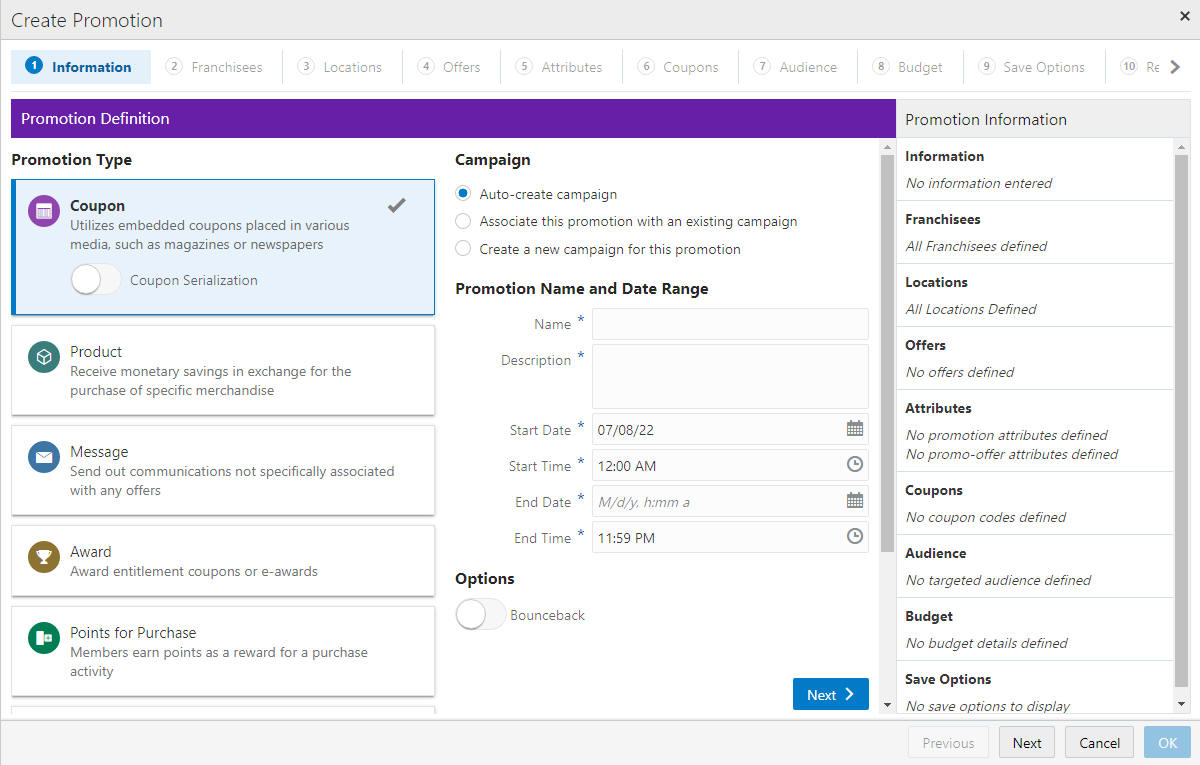
-
Select the Promotion Type: Coupon
Note:
Contact your administrator if you do not see the Promotion Types needed for your promotion
-
There are two options for a Coupon Promotion - Serialized and Non-Serialized. The selection you make will display different options on the Coupon tab. A Serialized Coupon promotion will generate coupons, each with a unique serial number, generally for a one-time use. A Non-Serialized Coupon promotion will generate a unique coupon code for the promotion, for example, a SHOE20 may represent a code a customer can use, multiple times, to receive 20% off a shoe purchase. If you wish to create a Serialized Coupon promotion, use the Coupon Serialization switch in the Coupon type box to activate that option. This Switch is only available if the Serialized Coupon Enabled Flag configuration is set to Yes. See the Oracle Retail Customer Engagement Cloud Service Implementation Guide for more information about the Serialized Coupon Enabled Flag configuration.
-
Select one of the choices for the Campaign.
-
Auto-create Campaign – The campaign is automatically created and will use the same name and description from the promotion name and description.
-
Associate this promotion with an existing campaign – Uses existing campaigns in the system.
-
Click the list arrow and select an existing campaign.
Note:
The Start Date and End Date display underneath the Existing Campaign list.
-
-
Create a new campaign for this promotion – A new campaign is created with this promotion being the first added.
-
-
Enter the following information:
-
Enter a Campaign Name (for new Campaigns only).
-
Enter a Description (for new Campaigns only).
-
Enter a Name.
-
Enter a Description.
-
Select a Start Date.
-
Select a Start Time.
-
Select an End Date.
-
Select an End Time.
-
-
Optional - Slide the Loyalty Bounceback toggle to ON to activate.
Figure 5-12 Loyalty Bounceback - Activated
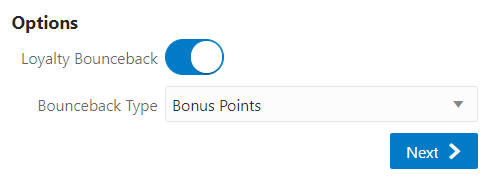
-
Select a Bounceback Type.
-
Bonus Points
-
Entitlements
-
Note:
Loyalty Bounceback configuration occurs in Step 12, the Offers tab.
-
-
When finished entering the Campaign and Promotion information, click Next to continue to the Franchisees tab.
Note:
This tab will only display if the
EnableFranchiseSupportconfiguration is enabled, and Franchisees have been created. -
By default, all franchisees are assigned to the promotion. To make changes to those assignments, do the following:
Figure 5-13 Franchisees Tab

Assigning a Franchisee
-
Click the Actions Menu, then, click Assign, or click the Add (+) icon. This opens the Add Franchisee window.
Figure 5-14 Assign Franchisee
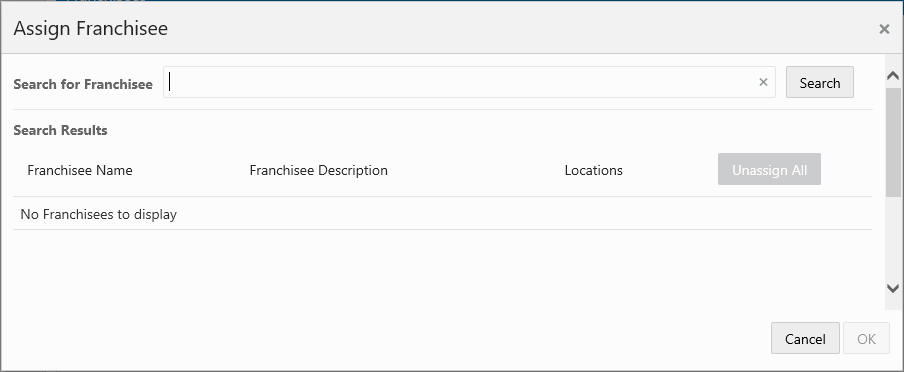
-
In the Search for franchisee search box, enter part or all of the Name, ID, or Description, then click Search.
Note:
You can also leave blank and click Search to return all Franchisees.
-
To change the assignment from ALL (which is defaulted) click Assign on just the specific franchisees you wish to assign for this promotion. Only Franchisees associated with the user are displayed in the list.
-
Click OK to accept the changes or Cancel to close the window without saving.
Figure 5-15 Confirmation Notification

Note:
A confirmation notification appears to confirm the franchisee has been assigned.
Deleting a Franchisee
-
In the included Franchisees window, highlight the desired row.
-
Click the Action Menu, and click Delete, or click the X icon.
Note:
A confirmation notification appears to confirm the franchisee has been deleted.
-
-
When finished entering the Franchisees information, click Next to continue to the Locations tab.
-
Enter the following for the Locations tab:
Figure 5-16 Locations Tab
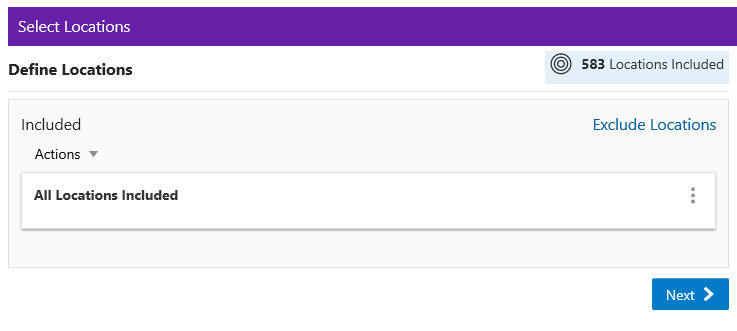
Define Locations
Note:
By default, ALL locations are added to the promotion. You can select the Overflow Menu to edit the list of locations to include.
-
Included
-
If you wish to change the Locations assigned to this Promotion, click the Overflow Menu, then click Edit. This opens the Edit Location Rule window.
Figure 5-17 Edit Location Rule (Include)
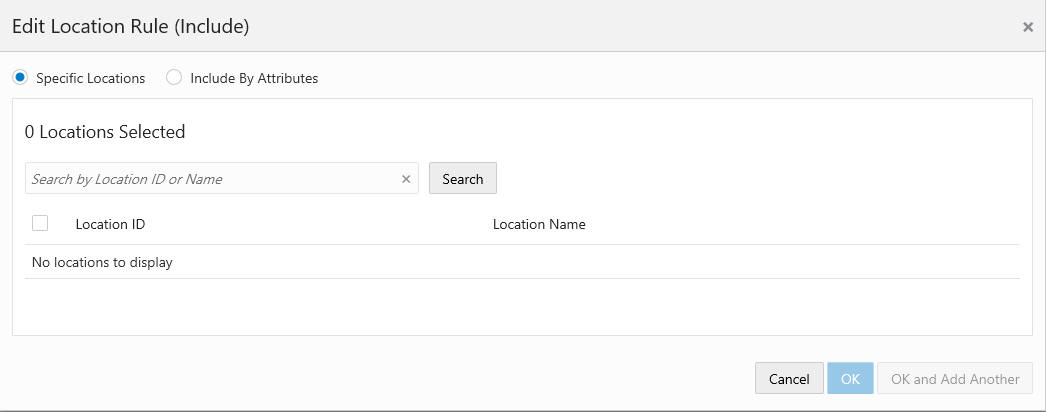
Specific Locations
-
Click the Specific Location option.
Figure 5-18 Edit Location Rule (Include) - Specific Locations

Note:
The Location ID check box at the top of the list enables you to deselect or select all locations. If you deselect all the locations, then you can scroll through the list or search for a specific location.
-
Enter part or all of a Location ID or Name.
-
Click Search.
-
Click Add to select a location.
-
Click Add for another location means you are using the condition AND. Both conditions must be met.
-
Click OK and Add Another to keep you in the same search results and use the condition OR. One or more of the conditions must be met when you click Add for another location.
-
Click Ok to close the window, or click Cancel to close the window without saving.
Include by Attributes
-
Click the Include by Attributes option.
Figure 5-19 Edit Location Rule (Include) - Include by Attributes

Note:
A list of attributes enables you to add one more attributes in order to create a query to select only the locations that fit the requirements.
-
Click Add to select an attribute. Some Location Attributes can be collapsed or expanded. They will default to collapsed to allow you to scroll thru the list easier and expand the attributes they you to add.
-
Click Add for another attribute means you are using the condition AND. Both conditions must be met.
-
Click OK and Add Another to keep you in the same window and use the condition OR. One or more of the conditions must be met when you click the Add button for another attribute.
-
Click OK to close the window, or click Cancel to close the window without saving.
-
-
Excluded Locations - This option allows you to select specific locations to exclude from the promotion.
-
Click the Exclude Locations link.
Figure 5-20 Select Locations

Specific Locations
Figure 5-21 Edit Location Rule (Exclude) - Specific Locations
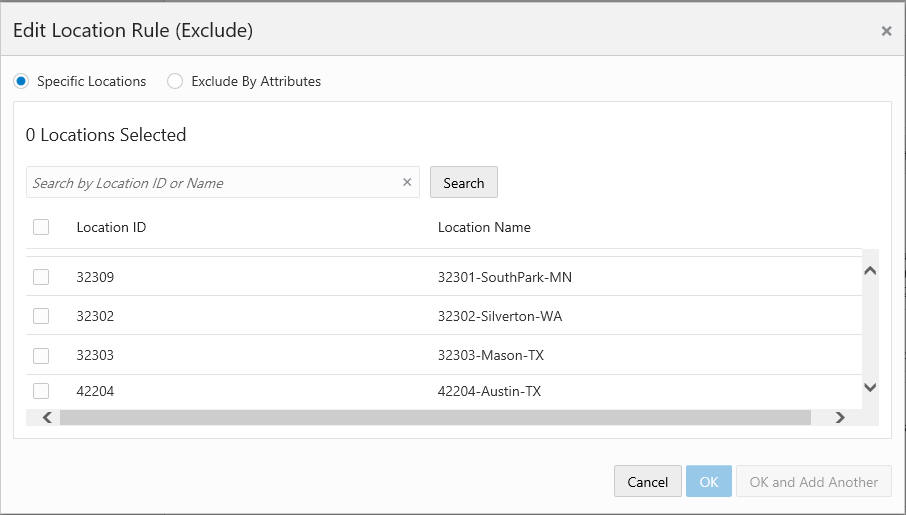
-
Click the Specific Location option.
Note:
The Location ID check box at the top of the list enables you to deselect or select all locations. If you deselect all the locations, then you can scroll through the list or search for a specific location.
-
Enter part or all of a Location ID or Name.
-
Click Search.
-
Click Add to select a location.
-
Click Add for another location means you are using the condition AND. Both conditions must be met.
-
Click OK and Add Another to keep you in the same search results and use the condition OR. One or more of the conditions must be met when you click Add for another location.
-
Click OK to close the window, or click Cancel to close the window without saving.
Exclude by Attributes
-
Click the Exclude by Attributes option.
Figure 5-22 Edit Location Rule (Exclude) - Exclude By Attributes
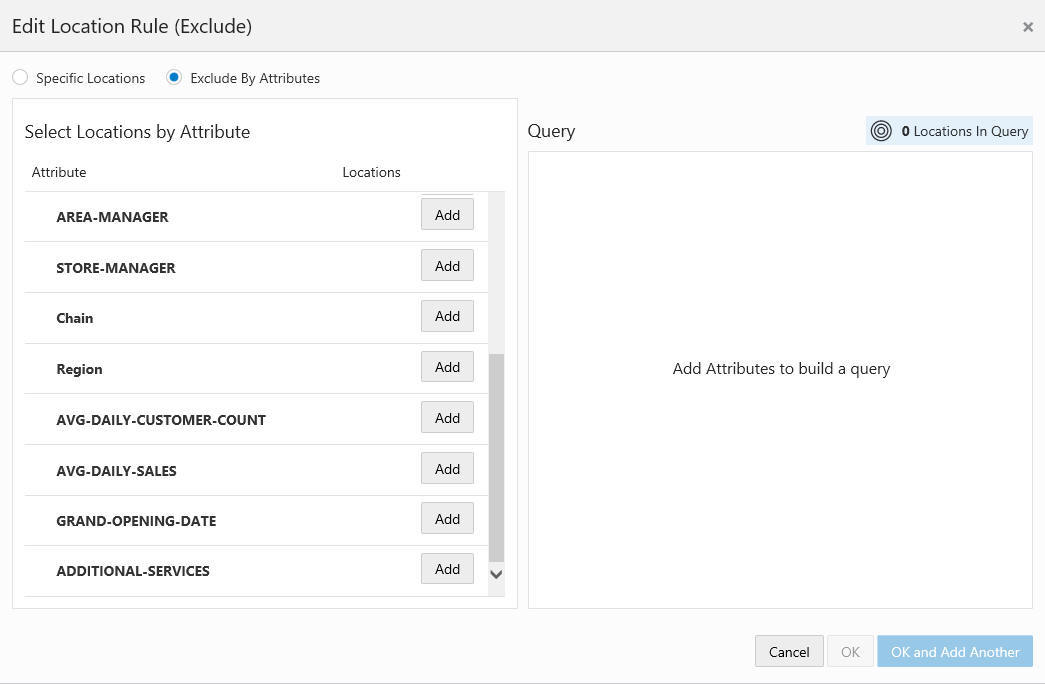
-
Click Add to select an attribute. Some Location Attributes can be collapsed or expanded. They will default to collapsed to allow you to scroll thru the list easier and expand the attributes they you to add.
-
Click Add for another attribute means you are using the condition AND. Both conditions must be met.
-
Click OK and Add Another to keep you in the same window and use the condition OR. One or more of the conditions must be met when you click Add for another attribute.
-
Click OK to close the window, or click Cancel to close the window without saving.
-
-
When finished entering Locations for the Promotion, click Next to continue to the Offers tab.
-
To begin the Offers tab, take the following actions:
There are two methods to add offers, either:
-
Select the Quick Add option to search for a known Offer ID.
-
Click +Add Offers for an Advanced Offer Search.
Figure 5-23 Offers Tab
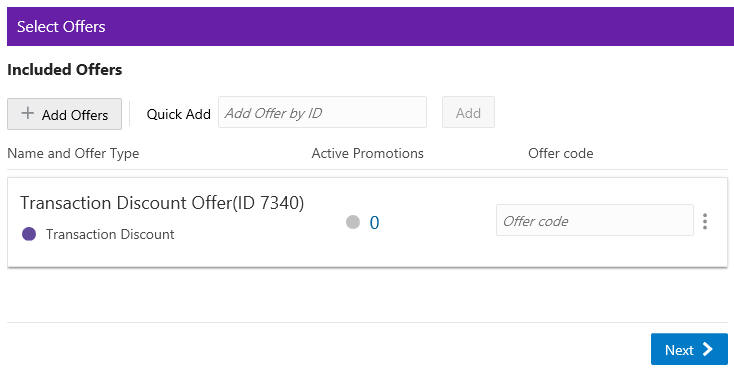
Note:
Refer to Figure 5-23 to enter the Offer Code field. A retailer can use it to qualify or track a particular offer.
-
Click + Add Offers. The Add Offers window enables you to search for offers to include in the promotion. Once you receive the results of the search you can sort the results, if desired for easier selection, before adding them to the promotion. Those offers appear in the Included Offers panel.
Figure 5-24 Add Offers
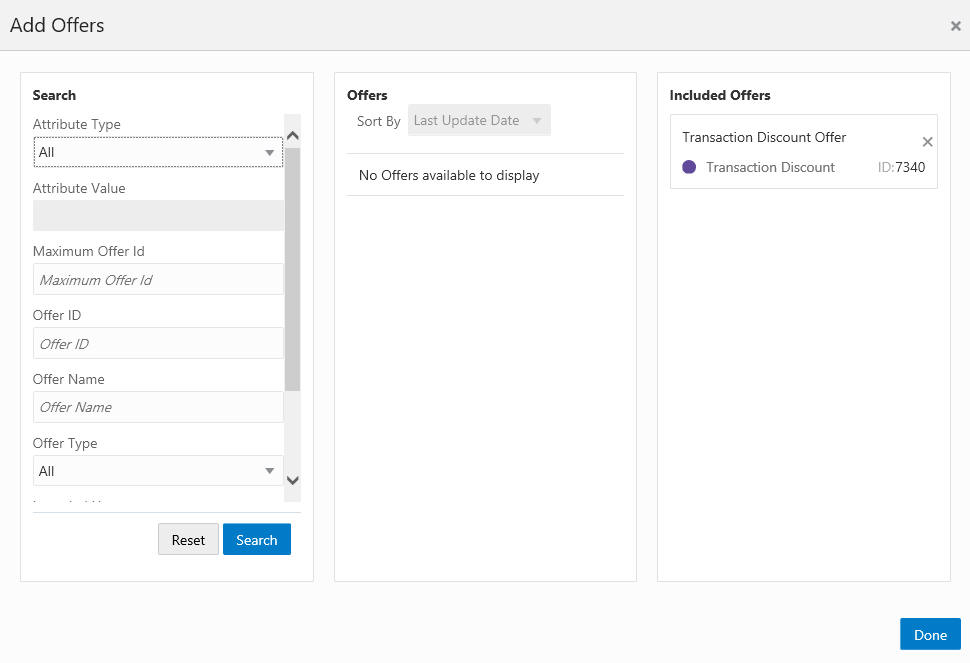
-
In the Search section, enter any or all of the following information:
-
Attribute Type – Search for an Offer by the Attribute assigned to the Offer. The default is ALL.
-
Attributes Value - Type-ahead search according to the Attribute Type selected.
-
Maximum Offer ID – Highest Offer ID number you wish to limit the search to. This will return that offer ID and all others with a lower number.
-
Offer ID – This Text Field searches all the Offers currently present in the application. The default is an empty field.
-
Offer Name – Name of the Offer.
-
Offer Type – Search the Offer by Offer Type (Single Select). Depending on the Parameter value set in System Configuration (Offer Types), the value is populated in the list of options. The following list shows the Possible Offer Types:
All (Default)
Buy X Get X
Buy X Get Y
Fixed Quantity/Price
Gift with Purchase
Kit
Line Item Discount
Tiered Discount
Transaction Discount
-
Intended Use – The type of Promotion associated with the Offer you are searching for.
-
-
Click Search.
Note:
Note: To retrieve all the offers in the system, select Search without entering any search criteria. All offers are returned to the Offers results section. From there, you can scroll through the list to choose which offers to add.
To clear the search fields and restore default selections in the search page, click Reset.
-
Upon selecting Search, the results display in the Offers section. Use the Sort by list to sort by the following options:
-
Last Update Date
-
Offer Name
-
Offer Type
-
Intended Use
-
Offer ID
-
-
In the Add Offers window, you can select any of the offers in the Include Offers section and remove them by selecting the X in the top right corner of the Offer. Click Add to include the offers in the promotion.
-
When finished selecting offers to add to the Promotion, select Done, which returns you to the Select Offers window.
-
On the Select Offers window, you can select the Remove option from the Overflow Menu to remove an offer from the promotion.
-
Enter the Offer ID in the Quick Add field and then click Add to also add offers to a promotion.
Figure 5-25 Select Offers Quick Add

Note:
The following two configuration options only appear when Loyalty Bounceback is activated in the Information tab.
Bonus Points - Points Bounceback options appear when Bonus Points is selected in the Information tab. From the Points Bounceback drop-down list, select one of the following options:
Figure 5-26 Points Bounceback - Fixed

-
Fixed - Identifies the amount awarded as loyalty incentive points to the user's account upon meeting the promotion requirements. Define the amount of points added by entering a value or using the up and down arrows to increase/decrease the number of points awarded.
Figure 5-27 Points Bounceback - Multiplier

-
Multiplier - Multiplies the number provided by the user by the dollar amount of the item to award the correct Loyalty Bounceback point amount upon meeting the promotion requirements.
-
None - No bonus points are assigned.
Entitlements - Entitlement configuration options appear when Entitlements is selected in the Information tab.
Figure 5-28 Offers Tab - Assigning Entitlements

-
Click the + Assign Entitlement Bounceback Offer button.
-
Assign an Entitlement Offer in the same way you assigned an Offer as shown within in this step.
Note:
The available Intended Use type for an Entitlement Bounceback is Entitlement. All other Intended Uses are disabled.
Figure 5-29 Expiration Types (Optional)

Optional: Configure the Offer Expires options. Click the Expires slider shown in Figure 5-29 to activate the following expiration types:
-
Expiration Type: Relative (default)
-
Enter a Value or click the Up/Down arrows to increase/decrease the value in the Expires After field.
-
Click the drop-down list to indicate Days, Months (default), or Years.
-
-
Expiration Type: Fixed
-
Click the Start Date field to use the Date Editor (required).
-
Click the End Date field to use the Date Editor (required).
-
-
The Overflow Menu for Entitlement Bounceback Offers include the following options:
-
Copy Bounceback Entitlement to all other Offers - Copies the expirations rules to all other entitlement bounceback offers selected. They will take the exact same rules from the selected entitlement bounceback. Doing this will overwrite any existing bounceback details selected.
-
Remove - Removes the offer and the bounceback entitlement offer.
-
Remove the Bounceback Entitlement - Removes the bounceback entitlement offer only. The offer remains available to add an entitlement bounceback offer.
-
-
-
When finished entering Offers for the Promotion, click Next to continue to the Attributes tab.
-
Enter the following for the Attributes tab.
Figure 5-30 Select Attributes
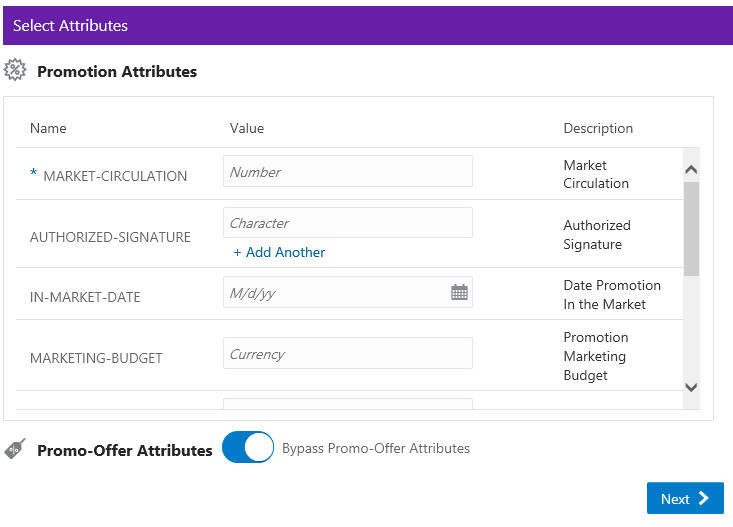
Complete values for any Promotion Attributes and Promo-Offer Attributes you want added to the promotion. Fields marked with an asterisk are required.
-
Promo-Offer Attributes Switch – Determines whether Promo-Offer attributes are used for this Promotion event:
-
On – The Promo-Offer Attributes switch defaults to ON, which means the step is bypassed and values for any defined Promo-Offer Attributes will not be required or added to the Promotion.
-
Off – When the Promo-Offer Attributes switch is set to OFF, it means that values for Promo-Offer Attributes will need to be defined and added to the Promotion.
-
-
-
When finished adding Attributes for the Promotion, click Next.
-
If the Promotion Type is Coupon, go to Step 16 to continue to the Coupons tab.
-
If the Promotion Type is Product, go to Step 21 to continue to the Audience tab.
-
If the Promotion Type is Message, go to Step 21 to continue to the Audience tab.
-
If the Promotion Type is Award, go to Step 33 to continue to the Budget tab.
-
-
Enter the following for the Coupons Tab.
-
If you did not select the Serialized Coupon switch in Step 3, proceed to Step 17.
-
If you did select the Serialized Coupon switch in Step 3, proceed to Step 19.
Coupon Serialization - Disabled
The following graphic depicts the options when Coupon Serialization is Disabled:
Figure 5-31 Coupon Codes Tab: Serialization - OFF

-
-
For each Offer that was added to the Promotion, as separate section will appear to complete these fields listed below.
-
Coupon Code - Enter a 6 digit code to be used for the coupon.
Note:
Values may be generated systematically, provided the PromoCouponCodeManagement configuration is enabled. Contact your system administrator regarding configurations.
-
Media Description – Description of the Media for the Coupon
-
Estimated Distribution – Estimated Distribution specified for Media for the Coupon
-
Click + Add Coupon Code to add another coupon to the Offer for Promotion.
-
To delete Coupons from an Offer, click X for that row.
-
-
When finished adding Coupon information for the Promotion, click Next to continue to the Audience tab. Proceed to Step 21.
Coupon Serialization - Enabled
Figure 5-32 depicts the options when Coupon Serialization is Enabled.
Figure 5-32 Coupon Codes Tab: Coupon Serialization - ON

-
For each Offer that was added to the Promotion, as separate section will appear to complete these fields listed below.
-
Coupon Prefix - Enter a 6 digit prefix to be used for the coupon.
Note:
Values may be generated systematically, provided the PromoCouponCodeManagement configuration is enabled. Contact your system administrator regarding configurations.
-
Media Description – Description of the Media for the Coupon
-
Click + Add Coupon Code to add another coupon to the Offer for Promotion.
-
To delete Coupons from an Offer, click X for that row.
-
-
When finished adding Coupon information for the Promotion, click Next to continue to the Audience tab.
-
Take the following actions for the Audience tab.
Figure 5-33 Audience Tab
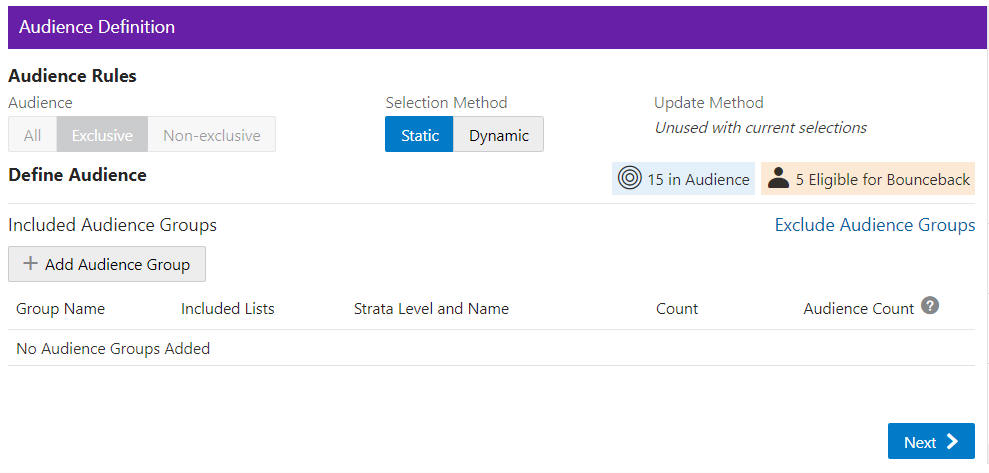
Audience Rules – Select All, Exclusive, or Non-Exclusive to define the audience.
-
If you select ALL, it means this promotion is open to anyone who responds to the sale – everyone who buys items on the promotion get the Offer.
-
The category All is defaulted when you open the Audience Window. Make no changes and advance to the next tab to add all customers to be targeted for this promotion.
Exclusive Targeting - If you create an exclusive targeted promotion, this means that only the customers you've identified in your target group are eligible to receive the promotion at the point of sale.
Non-Exclusive Targeting - If you create a non-exclusive targeted promotion, all customers are eligible for the promotion.
-
The Exclusive and Non-Exclusive options operate the same - the difference is only if the Promotion is exclusive to just those customers or non-exclusive for the groups selected. The Static and Dynamic selections apply to both.
-
Static – Only customers defined at this time are considered eligible for the promotion.
-
Dynamic – Dynamic can not only add customers but also remove customers that no longer apply. When Dynamic is selected, Update Method is available.
New audience members will be added – When the Dynamic Promotions job runs, any new customers found that meet the criteria, are added to the audience. All customers currently in the audience will remain in the audience.
Audience members can be added and removed – When the Dynamic Promotions job runs, any new customers found that meet the criteria, are added to the audience. Additionally, only the customers that meet the criteria will be included in the audience. If the customer is in the audience before the job runs, but no longer meets the criteria, the customer will be removed from the audience.
-
Define Audience - Included Audience Groups
-
Click + Add Audience Group.
Figure 5-34 Add Audience Group (Include)

-
Select an Available List type
All - Default
Stratified - The Customers within a Stratified list are divided into levels.
Unstratified - Customers maintained by the user.
Personal - Customers maintained by the user.
-
In the Search field, enter some or all of the List Name, ID, or Strata Name.
-
Click Search. The results can be sorted by using the Sort by list menu with the following options:
Last Updated
Name
Customer Count
-
Enter a Group Name.
When lists are added from the Available Lists area, they appear in the Audience Groups section of the window. The Audience Group section Group Name automatically defaults to the name of the first list added. You can change the Group Name to something more meaningful to describe the group of customers, if desired.
Figure 5-35 Add Audience Group (Include)

-
Click Add to add the selection Assigned Audience Lists.
-
Click Add for another list means you are using the condition AND. Both conditions must be met.
-
Click OK and Add Another to keep you in the same window and use the condition OR. One or more of the conditions must be met when you click Add for another Audience Group.
Figure 5-36 Audience Definition

As shown in Figure 5-36 the Count is shown for each audience group. In the Audience Rules section the Audience Count is provided on the right hand side.
Columns include the following details:
-
Group Name
-
Included Lists
-
Strata Name and Level (if applicable)
-
Count
-
Audience Count
Each Group Name has an Overflow Menu Icon where you can Edit or Remove the Audience Group from the list.
The Included Lists column displays a link on that list (also known as a segment) and that link will open to the Audience List Details window.
In this window, the following sections may display, depending on the type of list and which of the options were selected when the list was created:
-
List Options section
-
Criteria section
-
Trend Results section
-
Strata Levels section
-
Attributes section
-
Franchisees section
-
Message section
-
Scheduled Jobs section
Figure 5-37 List Details
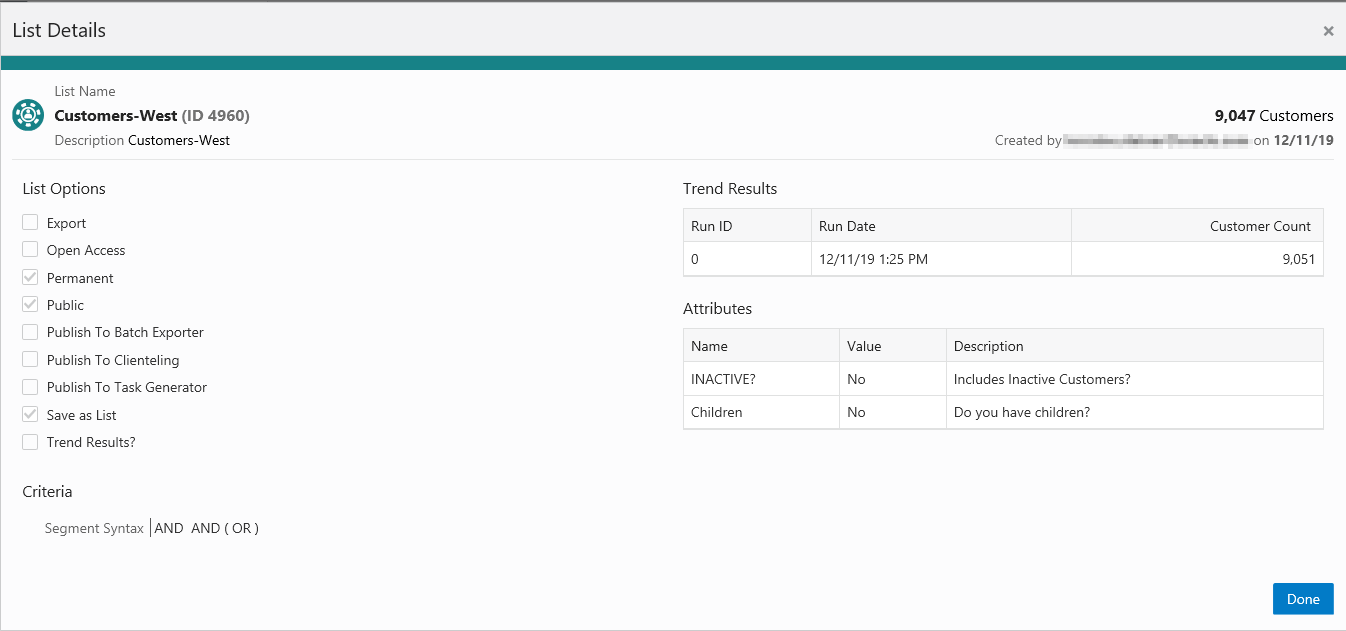
The checked List Options vary by the selections made when the list was created, and may include the following fields:
-
Export – Indicates whether the Segment list is automatically exported after the Segment Query is run.
-
Open Access – Indicates whether the Segment has Open Access.
-
Permanent – Indicates whether the Segment is kept in the system, even if it meets the criteria for deletion by the housekeeping job.
-
Public – Indicates whether the Segment is Public.
-
Publish to Batch Exporter – Indicates whether the Segment has been made available for export to a Marketing system.
-
Publish to Clienteling – Indicates whether the Segment has been made available to the Clienteling module.
-
Publish to Task Generator – Indicates whether the Segment has been made available to the Task Generator Job.
-
Save as List – Indicates whether a list of matching Customer IDs is created when the Segment is created.
-
Trend Results – Indicates whether the results of the Segment run are kept to provide trend information about the Segment.
Figure 5-38 displays the Trend Results in a chart. A user can scroll down to see a table as shown in Figure 5-39, which for this segment shows the Strata Levels Against Customer Age and displays the strata that are shown in the graph.
Figure 5-38 List Details Trend Results - Chart
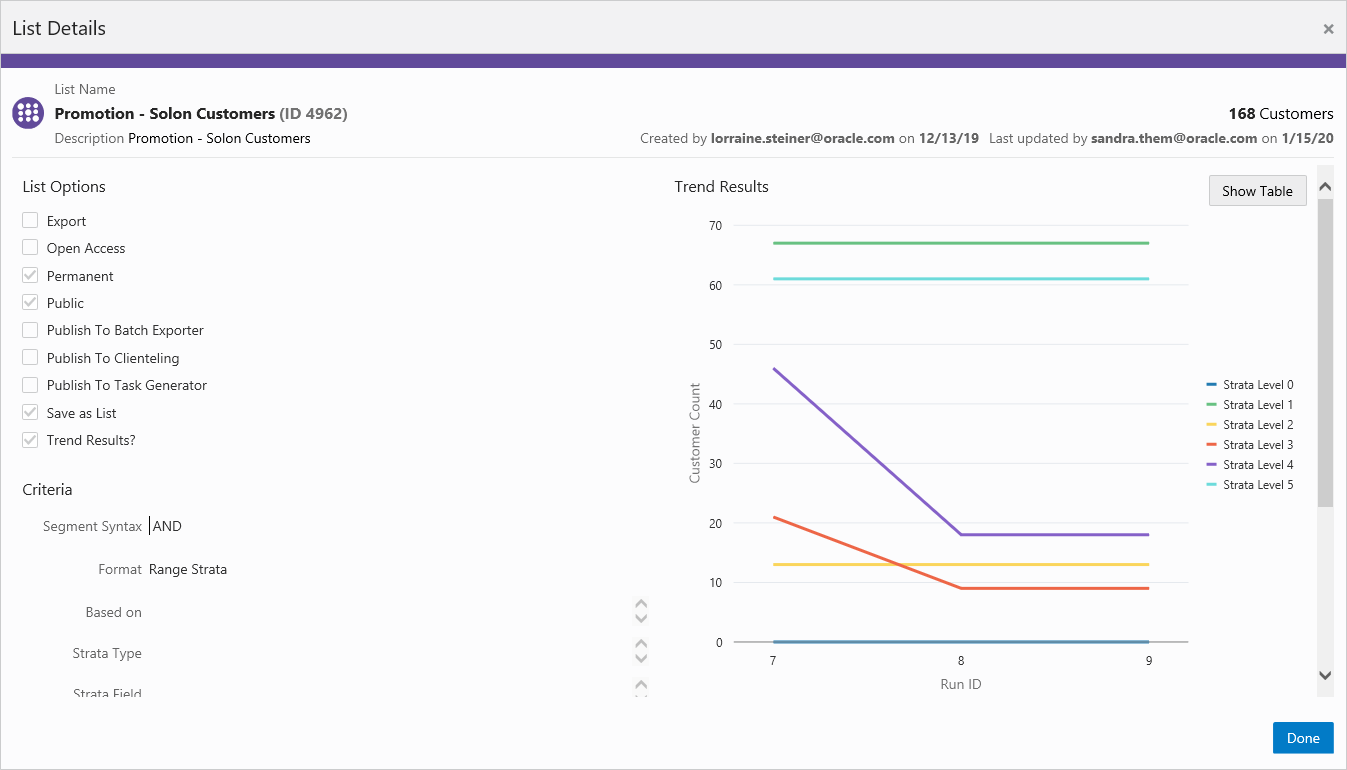
Figure 5-39 Trend Results Graph - Table

Figure 5-40 List Details Trend Results - Table
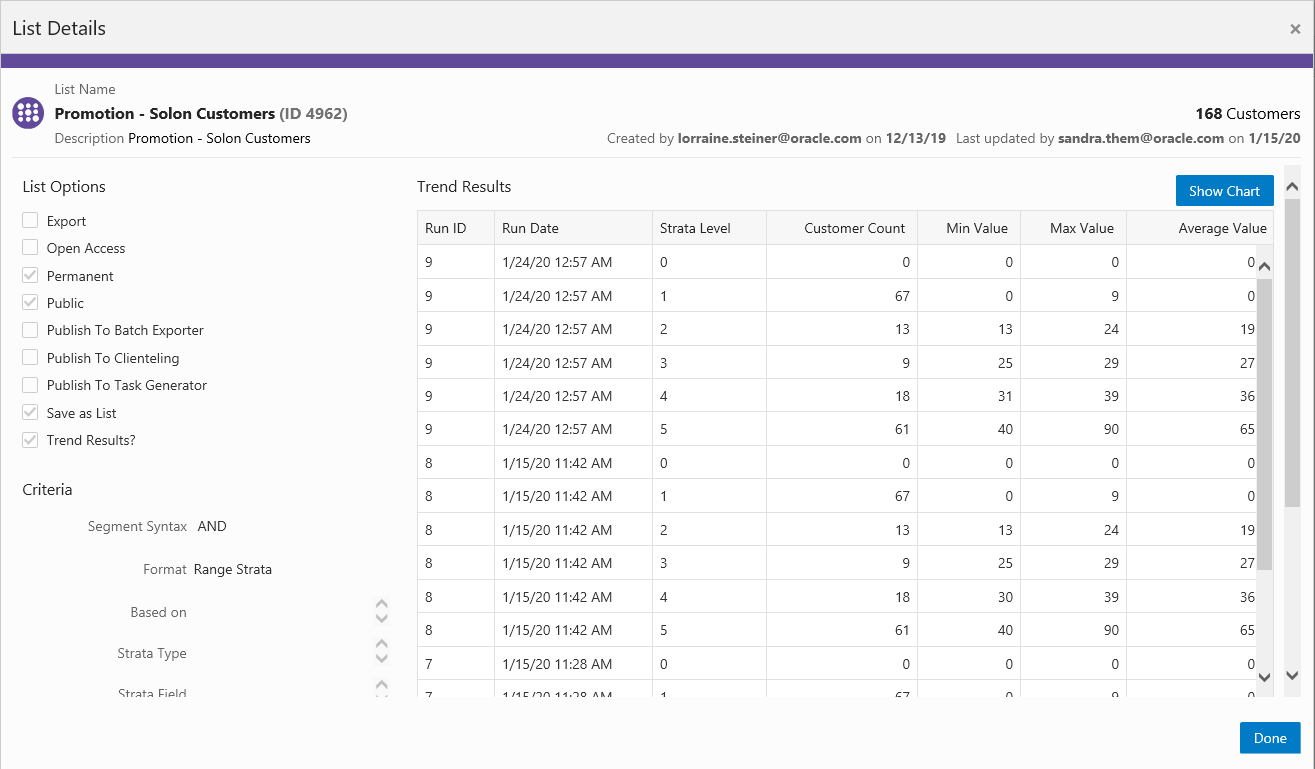
-
Click Done to close the Audience List Details window.
Figure 5-41 Audience Definition - Exclude Audience Groups
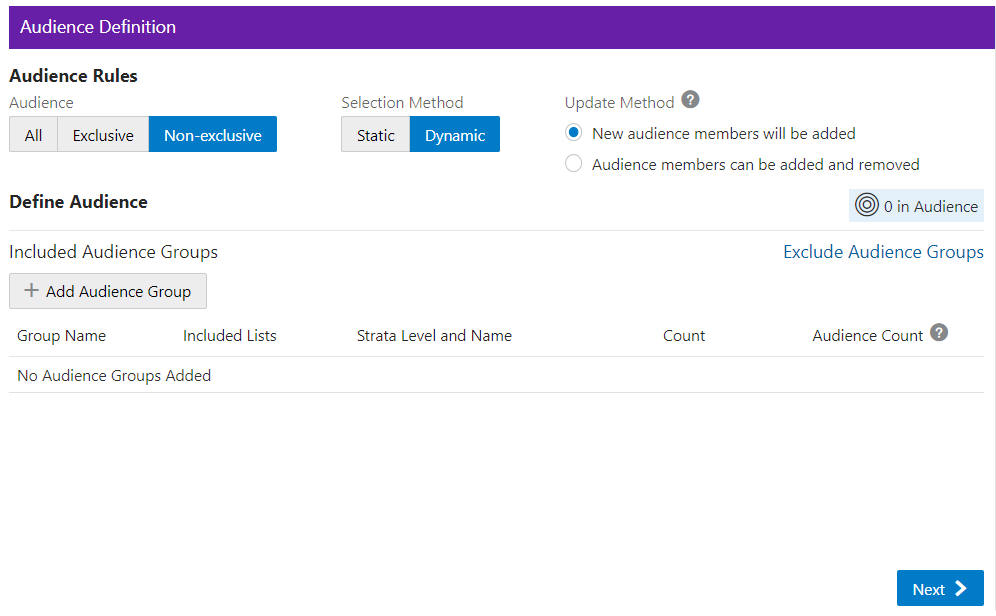
Exclude Audience Groups - If you wish to exclude certain groups of customers that may also be a part of the Included Group, you can do that by selecting the Exclude Audience Groups link, which opens a new section in the Audience Definition window
-
Select the Exclude Audience Groups link.
-
Click + Add Audience Group.
-
Select an Available List type.
-
-
All – Default group listing.
-
Stratified – The Customers within a Stratified list are divided into levels.
-
Unstratified – The Customers within an Unstratified list are not differentiated into separate groups.
-
Personal – User created groups.
-
-
In the Search field, enter some or all of the List Name, ID, or Strata Name.
-
Click Search.
-
The results can be sorted by using the Sort by list menu with the following options:
-
Last Updated
-
Name
-
Customer Count
-
-
Enter a Group Name.
-
Click Add to add the selection Assigned Audience Lists.
-
Click Add for another list means you are using the condition AND. Both conditions must be met.
-
Click OK and Add Another to keep you in the same window and use the condition OR. One or more of the conditions must be met when you click Add for another Audience Group.
-
-
When finished entering all Audience Groups for the Promotion, click Next.
-
Enter the following for the Filtering Audience tab.
Figure 5-42 Filtering Audience Tab
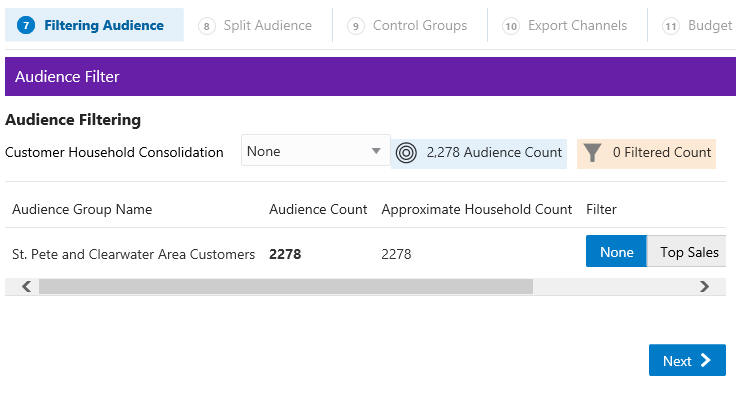
Use the Customer Household Consolidation Selection Menu to indicate whether the Promotion will use household consolidation, and the rule for determining the Customer who is the head of household.
-
None – Do not perform household filtering.
-
LT Sales – Select head of household based on amount purchased over the lifetime of their account.
-
LT Transaction Count – Select head of household based on lifetime number of transactions.
-
Last Transaction Date – Select head of household based on the Customer who performed the most recent transaction.
-
Customer Attributes – Select head of household based on the Customer's numeric attributes.
Select the Filter Type for each Audience:
Figure 5-43 Select Desired Filtering
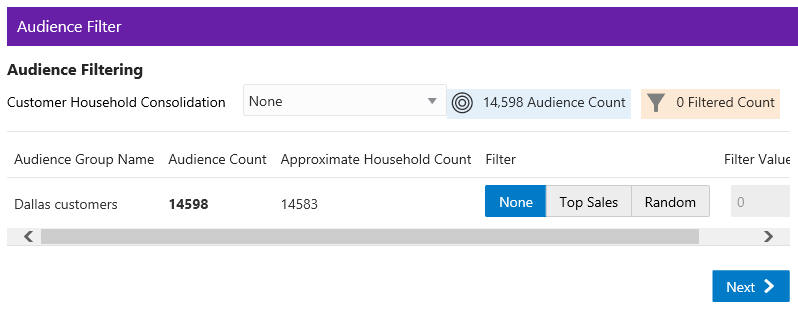
-
None - [DEFAULT] All Customers in the Audience Group are eligible.
-
Top Sales - Customers from the Audience Group will be chosen for eligibility by the greatest total amount of purchases.
-
Random - Customers from the Audience Group will be chosen randomly for eligibility.
Enter a filter value to indicate the number of customers eligible for the promotion.
-
-
When finished entering any household filtering for the Audience Groups for the Promotion, click Next to continue to the Split Audience tab.
-
In the Split Audience tab, filtered audiences can, optionally, be split into smaller, separate audiences. If desired, create splits for the filtered audiences on the promotion.
-
Click Split.
Figure 5-44 Split Audience Groups
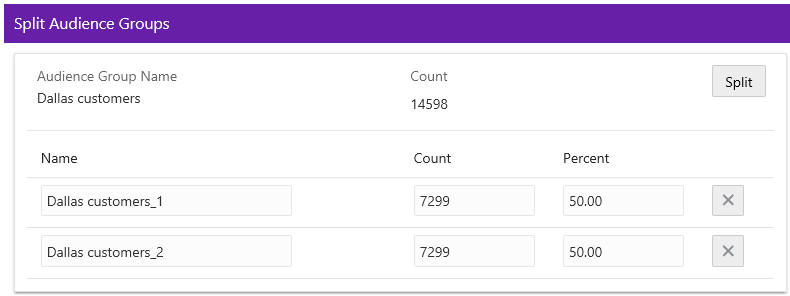
-
The Split Name field is automatically populated from the name of the Audience Group Name. If desired, you can change the name of the splits in this step.
-
Select Split to automatically divide the Audience Group into equal portions and percentages. If you desire different portions or percentages for the splits, enter either a count or a percentage, and the corresponding field will update.
-
-
When finished entering any Audience Group splits for the Promotion, click Next to continue to the Control Groups tab.
-
Enter the following information for the Control Groups tab.
Figure 5-45 Define Control Groups

The control group is a statistically identical group that doesn't receive the offer. Following the promotional period, the results of the two groups are compared and you can determine if the offer generated incremental revenue. Options include:
-
None – No Control Group
-
By Promotion – Enter either a New Count or Percent. The corresponding field will update automatically to determine the size of the control group.
-
By Audience Group – Enter either a Control Group count or percentage for each split created earlier. The corresponding field will update automatically.
-
-
When finished entering any Control Groups for the Promotion, click Next to continue to the Export Channels tab.
-
Enter the following information for the Export Channels tab. The options include:
Figure 5-46 Export Channels Tab
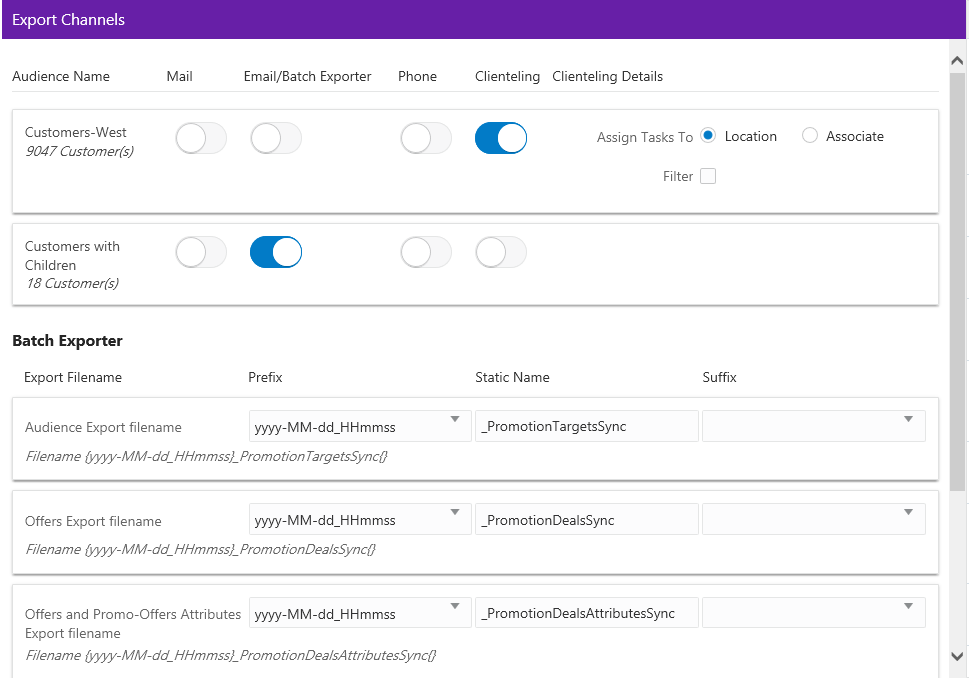
Mail - Determines whether the Customers in the Split/Control Group will be contacted by Mail.
EMail / Batch Exporter - Determines whether the Customers in the Split/Control Group will be contacted by Email.
Note:
The system configuration setting SupportedBatchExporters determines if the Batch Exporter section is displayed.
-
Export Filename – Name of the file.
-
Prefix – Indicates the format of the datetime stamp used as a prefix the filename. Optional. Possible settings are yyyyMMdd_HHmmss, yyyy-MMdd_HHmmss, or none.
-
Static Name – The identifying filename.
-
Suffix – Indicates the format of the datetime stamp used as a suffix the filename. Optional. Possible settings are yyyyMMdd_HHmmss, yyyy-MMdd_HHmmss, or none.
-
Filename – Displays an example of the export file name with the prefix and suffix format, if any.
Phone - Determines whether the Customers are contacted by phone.
Clienteling – When the Clienteling switch is turned on, tasks will be created based on the assigned associates or locations for the defined target audience when the promotion is generated.
Figure 5-47 Clienteling Details
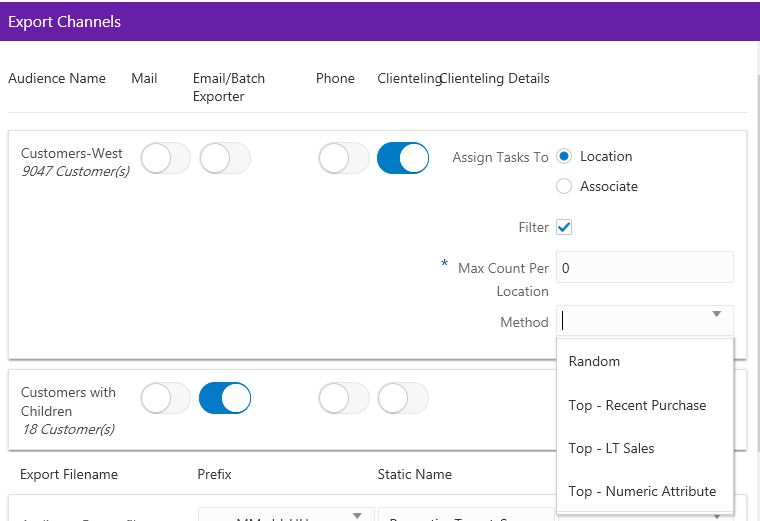
Assign Tasks to:
-
Location Channel – Tasks are assigned to a Location.
-
Associate Channel – Tasks are assigned to an associate in a location.
The following fields are enabled if the Filter option is selected:
-
Max Count Per <type> - Determines the maximum number of target Customers that will be contacted through the channel.
-
Method - Method used to select the Customers contacted. Options include:
-
Random - Select Customers Randomly (Default).
-
Top - Recent Purchase - Filter the Customers based on the most recent purchases.
-
Top - LT Sales - Filter the Customers based on the largest amount purchased over the lifetime of their account.
-
Top - Numeric Attribute - Filter the Customers based on the highest attribute value for a selected numeric attribute. If this option is selected, an additional Channel Filter option, Attribute, displays. Attribute is the numeric attribute used to determine the customers contacted
-
-
-
When finished entering any Export Channels for the Promotion, click Next to continue to the Event Definition tab.
-
Enter the following information on the Event Definition tab.
Note:
The Event Definition Tab displays only when the Promotion uses the Clienteling Channel.
Figure 5-48 Event Definitions Tab

Enter a description of the Event in the Event Description field (required).
Select the Edit option to add an image to the Event.
-
Perform one of the following actions:
Click Drop a new image here or click to upload to add the image and continue to Step 31.b.
Enter a URL in Or Via URL and click Upload and continue to Step 31.b.
Click Remove Image to remove the image and continue to Step 31.b.
-
Click Done to save the changes and close the window, or click Cancel to close the window without saving any changes.
Event Task Escalation – This option will flag an Event Task for the promotion as high priority on the Day Planner Task panel based on the number days before the end date of the promotion event task.
Event Documents – Click the Action Menu, and click Add, or click the Add icon (+) to open the Add Event Documents window.
Figure 5-49 Add Event Documents

-
Use the Drop a file here or click to upload area to add an event document.
-
Click OK to save the changes and close the window, or click Cancel to close the window without saving any changes.
-
-
When finished entering any Event Definitions for the Promotion, click Next to continue to the Budget tab.
-
Enter the following information on the Budget tab.
Figure 5-50 Budget Tab

-
Click Add to enter the Promotion Costs. Enter values in any field is optional.
-
Enter a Description of the cost item.
-
Enter the budgeted amount for the Promotion in the Budget Amount field.
-
Enter the actual amount for the Promotion in the Actual Amount field.
-
Click Add if you wish to enter another budget line for the promotion, then follow steps a-d to complete the fields.
If Export Channels were selected for the audience group, the Audience Groups Costs section appears. Entering values in any field is optional.
Figure 5-51 Audience Group Costs
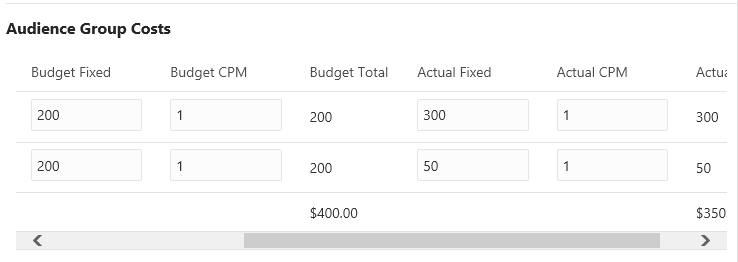
-
In the Budget-Fixed field, enter the fixed cost budgeted for the audience.
-
In the Budget-CPM field, enter the cost budgeted for the Channel for each 1,000 Customers.
-
In the Actual-Fixed field, enter the actual fixed cost of the Channel.
-
In the Actual-CPM field, enter the actual cost of the Channel for each 1,000 Customers.
-
Repeat steps f-i for each Target Channel in the Promotion.
-
-
When finished entering any Budget Costs for the Promotion, click Next to continue to the Save Options tab.
-
Enter the following information in the Save Options tab. You can enter more than one choice.
Figure 5-52 Options After Save Tab

-
Generate – Start a job to generate promotion audience data.
-
Approve – Set this promotion's status to Approved.
-
Export – Start a job to create files for exporting this promotion to an external/POS/batch system. This option automatically approves the Promotion.
-
Apply Offers Immediately – Indicates that offers should be applied immediately to downstream systems. This option is configurable.
-
Dynamic Promotion Options – Select one of the two export options for processing when using the Dynamic selection method on the Audience tab.
Note:
Depending on the type of promotion that you created, different Options After Save are available.
-
-
When finished entering any Save Options for the Promotion, click Next.
-
If the Promotion Type is Coupon go to Step 37 to continue to the Coupon Type Promotion Review tab.
-
If the Promotion Type is Product, go to Step 7 to continue in the Creating a Product Promotion Review tab.
-
If the Promotion Type is Message, go to Step 6 to continue in the Creating a Message Promotion Review tab.
-
If the Promotion Type is Award, go to Step 8 to continue in the Creating an Award Promotion Review tab.
-
-
The Review tab displays the key elements in the Promotion Setup.
Figure 5-53 Review Tab

Figure 5-54 Review Tab - Loyalty Bounceback

-
Click OK to save the Promotion, or click Cancel to close the promotion without saving. Click Previous or any Tab to return to any point of the Create Promotion process.
Working with Coupon Promotions
Creating Additional Coupons
Users have the ability to create additional coupons for a Coupon Promotion with Serialized Coupons, so that you are not limited to only the coupons generated at the time of saving the promotion. To create an additional coupon do the following steps:
-
View a Coupon Promotion (for more information on how to view a promotion see Viewing a Promotion).
-
Click the Overflow Menu.
-
Click Create Coupons.
Note:
Some Coupon Promotions cannot be edited once saved.
Figure 5-55 Create Coupons

-
Enter the number of Additional Coupons.
-
Click Create Coupons to create additional coupons, or click Cancel to return to the View Promotion window without saving any changes.
Creating a Product Promotion
There are a few choices available to start the process of creating a promotion. The Create Promotion button is available in both the Promotion Home window as well as the Promotion Search window.
Note:
You will need the Promotion Home role to access the Promotion Home window.
Figure 5-56 Promotion Search

-
Click Create Promotion, which opens up the Promotion wizard to the Information tab.
Figure 5-57 Information Tab - Product

-
Select the Promotion Type: Product
Note:
Contact your administrator if you do not see the Promotion Types needed for your promotion.
-
Select one of the choices for the Campaign.
-
Auto-create Campaign – The campaign is automatically created and will use the same name and description from the promotion name and description.
-
Associate this promotion with an existing campaign – Uses existing campaigns in the system.
-
Click the list arrow and select an existing campaign.
Note:
The Start Date and End Date display underneath the Existing Campaign list.
-
-
Create a new campaign for this promotion – A new campaign will be created with this promotion being the first added.
-
-
Enter the following information:
-
Enter a Campaign Name (for new Campaigns only).
-
Enter a Description (for new Campaigns only).
-
Enter a Name.
-
Enter a Description.
-
Select a Start Date.
-
Select a Start Time.
-
Select an End Date.
-
Select an End Time.
-
-
Optional - Slide the Loyalty Bounceback toggle to ON to activate.
Figure 5-58 Loyalty Bounceback - Activated

-
Select a Bounceback Type.
-
Bonus Points
-
Entitlements
-
Note:
Loyalty Bounceback configuration occurs in Step 12, the Offers tab in Creating a Coupon Promotion.
-
-
When finished entering the Campaign and Promotion information, click Next to continue to the Figure 5-13, see step 8 in Creating a Coupon Promotion
-
The Review tab displays the key elements in the Promotion Setup.
Figure 5-59 Review Tab

Figure 5-60 Review Tab - Loyalty Bounceback

-
Click OK to save the Promotion, or click Cancel to close the promotion without saving. Click Previous or any Tab to return to any point of the Create Promotion process.
Creating a Message Promotion
There are a few choices available to start the process of creating a promotion. The Create Promotion button is available in both the Promotion Home window as well as the Promotion Search window.
Note:
You will need the Promotion Home role to access the Promotion Home window.
Figure 5-61 Promotion Search

-
Click Create Promotion, which opens up the Promotion wizard to the Information tab.
Figure 5-62 Information Tab - Message
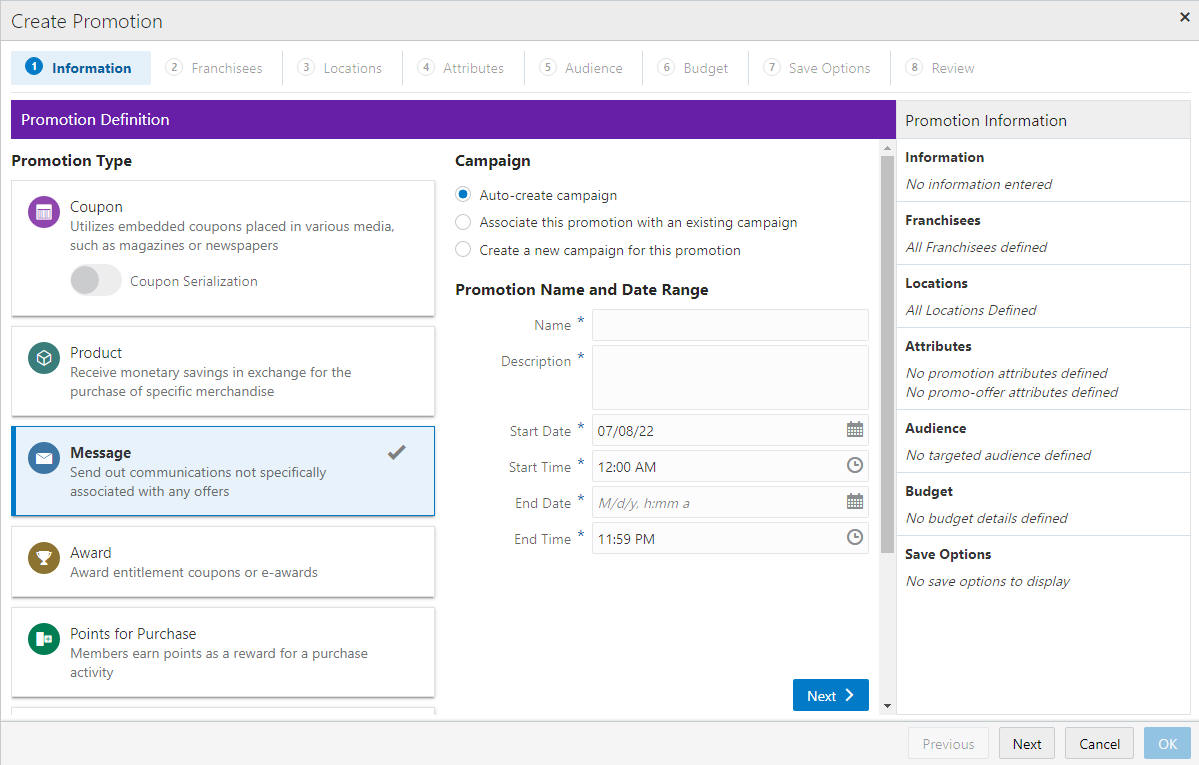
-
Select the Promotion Type: Message
Note:
Contact your administrator if you do not see the Promotion Types needed for your promotion.
-
Select one of the choices for the Campaign.
-
Auto-create Campaign – The campaign is automatically created and will use the same name and description from the promotion name and description.
-
Associate this promotion with an existing campaign – Uses existing campaigns in the system.
-
Click the list arrow and select an existing campaign.
Note:
The Start Date and End Date display underneath the Existing Campaign list.
-
-
Create a new campaign for this promotion – A new campaign will be created with this promotion being the first added.
-
-
Enter the following information:
-
Enter a Campaign Name (for new Campaigns only).
-
Enter a Description (for new Campaigns only).
-
Enter a Name.
-
Enter a Description.
-
Select a Start Date.
-
Select a Start Time.
-
Select an End Date.
-
Select an End Time.
-
-
When finished entering the Campaign and Promotion information, click Next to continue to theFigure 5-13, see step 8 in Creating a Coupon Promotion
-
The Review tab displays the key elements in the Promotion Setup.
Figure 5-63 Review Tab
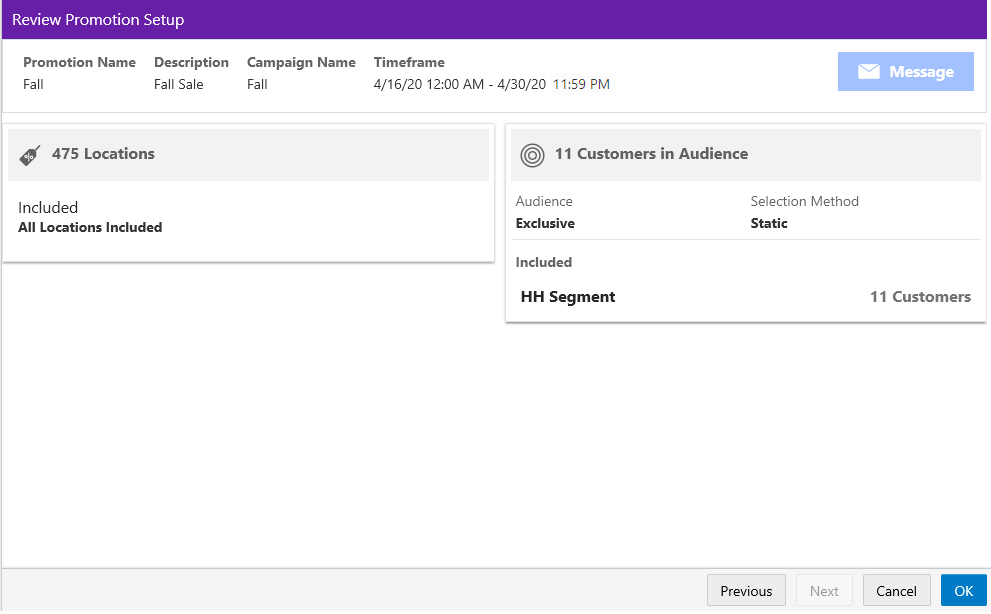
-
Click OK to save the Promotion, or click Cancel to close the promotion without saving. Click Previous or any Tab to return to any point of the Create Promotion process.
Creating an Award Promotion
There are a few choices available to start the process of creating a promotion. The Create Promotion button is available in both the Promotion Home window as well as the Promotion Search window.
Note:
You will need the Promotion Home role to access the Promotion Home window.
Figure 5-64 Promotion Search

-
Click Create Promotion, which opens up the Promotion wizard to the Information tab.
Figure 5-65 Information Tab - Award
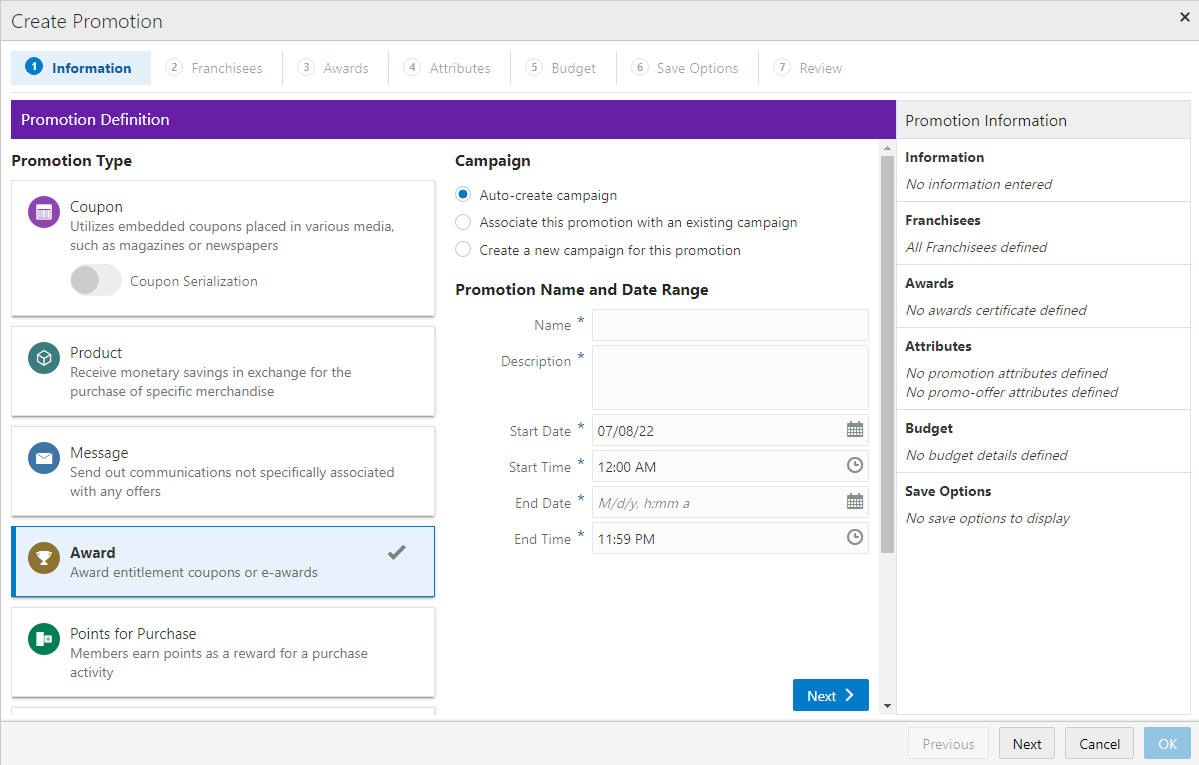
-
Select the Promotion Type: Award
Note:
Contact your administrator if you do not see the Promotion Types needed for your promotion.
-
Select one of the choices for the Campaign.
-
Auto-create Campaign – The campaign is automatically created and will use the same name and description from the promotion name and description.
-
Associate this promotion with an existing campaign – Uses existing campaigns in the system.
-
Click the list arrow and select an existing campaign.
Note:
The Start Date and End Date display underneath the Existing Campaign list.
-
-
Create a new campaign for this promotion – A new campaign will be created with this promotion being the first added.
-
-
Enter the following information:
-
Enter a Campaign Name (for new Campaigns only).
-
Enter a Description (for new Campaigns only).
-
Enter a Name.
-
Enter a Description.
-
Select a Start Date.
-
Select a Start Time.
-
Select an End Date.
-
Select an End Time.
-
-
When finished entering the Campaign and Promotion information, click Next to continue to theFigure 5-13, see step 8 in Creating a Coupon Promotion
-
To assign awards for the Awards tab, do the following:
Award promotions are based on award card definitions. Awards (EAwards or Entitlement Offer awards) are issued when the Promotion is generated. If the Promotion is defined as Issue to registered cards only, the awards will be created for cards within the selected program that are associated to a customer when the promotion is generated. This type of promotion is considered exclusively targeted to the customers with those cards. The targeting step will be available to define filters and/or control groups if desired.
A segment can be added to filter the number of awards created. For example, an Award Program has 1,000 customers associated to cards, but this Promotion is only for those customers that live in Ohio. A segment can be defined for Ohio customers within that card program and added to the Promotion as Included Targets. In this case, only the customers that live in Ohio are included. An alternative is to add an Excluded Target segment, which could exclude all customers that live in New York. The promotion target can also be defined as Dynamic Targeting. If Dynamic Targeting is selected, any new customers that are associated to cards are dynamically added to the promotion target, and awards are issued when the Dynamic Promotion job is run.
If the promotion is defined to Issue Coupons Dynamically, the awards are created for activated cards within the selected program when the promotion is generated. The card does not need to be associated to a customer. This type of promotion is considered non targeted, since a customer association is not required. The promotion targeting step is skipped. This type of promotion is automatically considered a Dynamic Promotion. For a Dynamic Promotion, any new cards within the selected program that are activated will have an award issued when the Dynamic Promotion job runs.
Figure 5-66 Select Award Tab
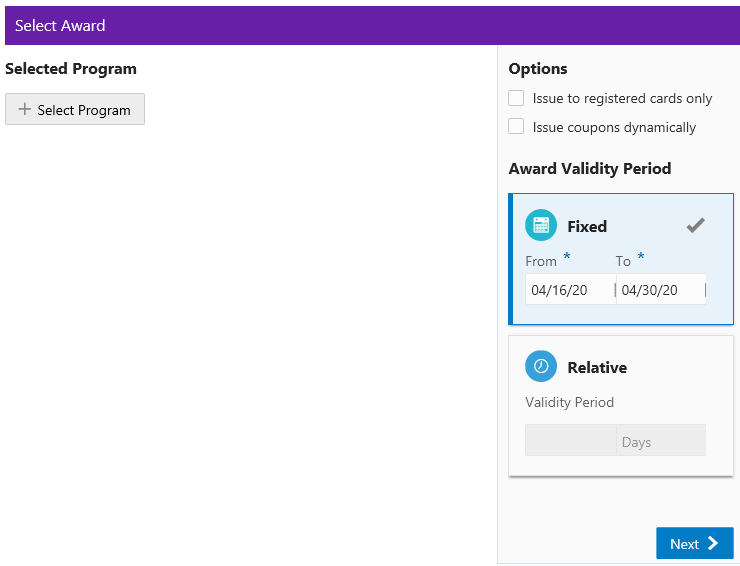
Click +Select Program, which retrieves all available Award Programs for selection.
Figure 5-67 Select Award Program
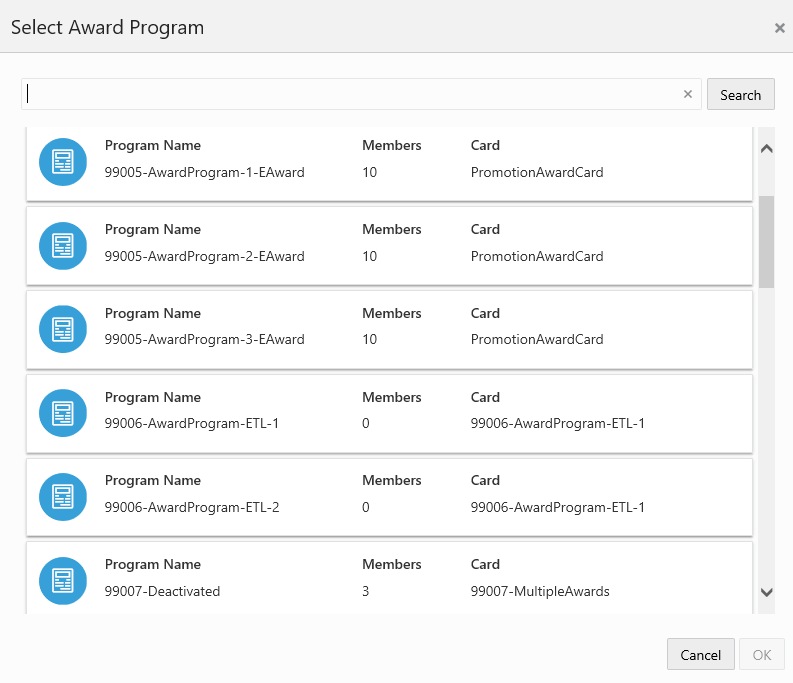
-
If the list is too long, you may enter some or all of the Program Name or Card Name in the Search for Award field to refine the results.
-
Click Search.
-
Click the row of the desired Award Program.
Note:
Only one program can be selected at a time.
-
Click OK.
Note:
Once the Program details display, if you wish to change the Award Program, you can click Change, which re-opens the Select Award Program window where you can select a different program for your promotion.
Certificate Options
Do the following to select a Certificate Type:
Figure 5-68 Award Program Certificate Options
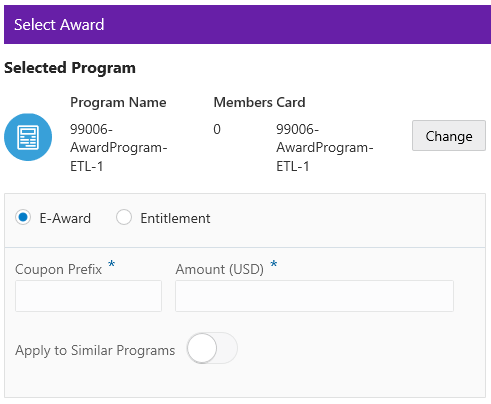
Figure 5-69 Award Program Certificate Options - E-Award

Select the Certificate Type: E-Award
-
Enter a Coupon Prefix. The value must be 10 or fewer characters.
-
Enter the Amount for the award certificate.
Figure 5-70 Award Program Certificate Options - Entitlement
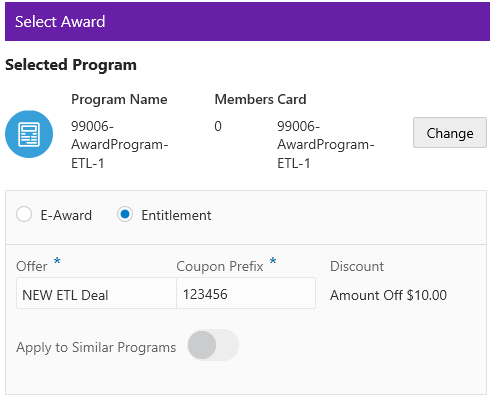
Select the Certificate Type: Entitlement.
-
Click inside the Offer field to see the list of Entitlement Offers associated to the Award Program. If there is more than one, you can choose which one to select. The Offer you choose will then display the value of the discount associated with that Offer (in the Discount field).
-
Enter a Coupon Prefix. The value must be 10 or fewer characters.
-
Discount - this field will automatically populate with the discount for the Offer.
Options
Figure 5-71 Select Award Certificate Options
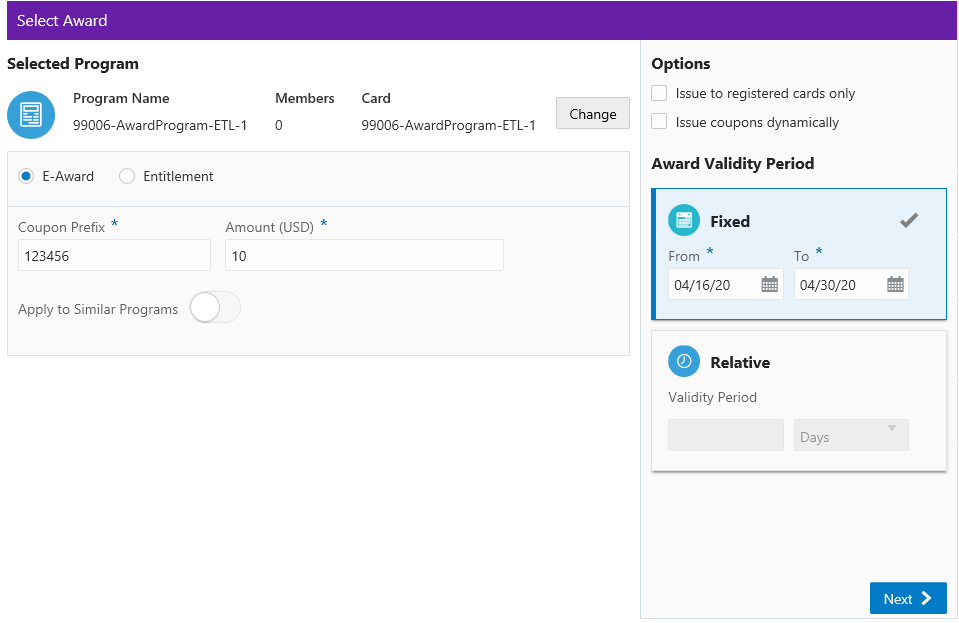
-
Select Issue to registered cards only if the promotion should be restricted to cards that are registered to customers. If this option is not selected, coupons will be issued to all active accounts for the selected Award Program, and the option to target the promotion will not be available.
-
Select Issue coupons dynamically to have the option to issue coupons dynamically. If this option is selected, coupons will be issued to all accounts that are activated when the program is generated.
Award Validity Period - Only one of the options will be available for the Award certificate.
-
Fixed – The award certificate is valid between specific dates.
-
Start Date – The date on which the award certificate is first valid.
-
End Date – The last date on which the award certificate is valid.
-
-
Relative – The award certificate is valid for a period of time after it is issued.
-
Validity Period – Period during which the award certificate is valid. The type of period is determined by the Period Type configuration.
-
Period Type – Units of time used to determine the validity period. Currently, this list can only be set to Days.
-
-
Apply to Similar Programs is activated when similar programs are available.
Figure 5-72 Apply to Similar Programs
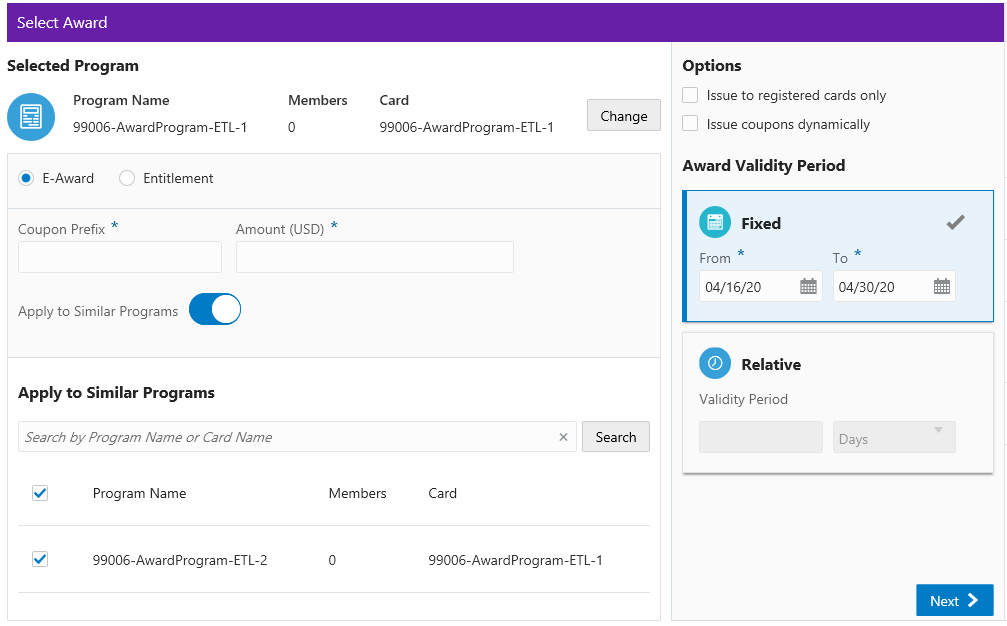
-
All Similar Programs meeting the criteria will display, but if you wish to filter the results you may enter some or all of the Program Name or Card Name in the Search field and click Search.
-
Click the check box for the rows of the desired Award Programs you wish to add.
-
Click OK.
-
-
-
When finished entering Awards for the Promotion, click Next. To continue to the Figure 5-30 tab, see Step 14 in Creating a Coupon Promotion.
-
The Review tab displays the key elements in the Promotion Setup.
Figure 5-73 Review Tab
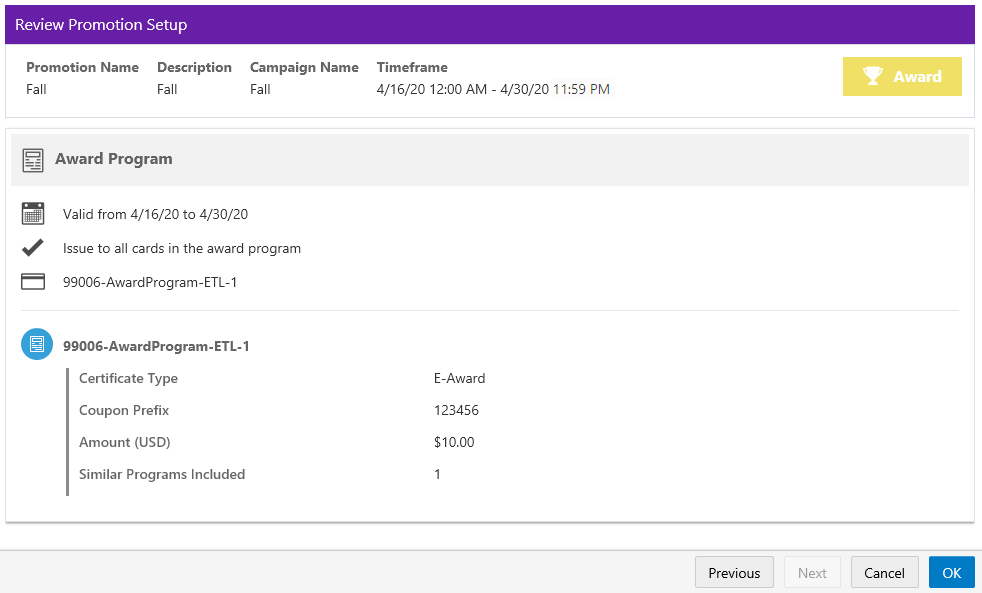
-
Click OK to save the Promotion, or click Cancel to close the promotion without saving. Click Previous or any Tab to return to any point of the Create Promotion process.
Creating a Points for Purchase Promotion
There are a few choices available to start the process of creating a promotion. The Create Promotion button is available in both the Promotion Home window as well as the Promotion Search window.
Note:
You will need the Promotion Home role to access the Promotion Home window.
-
Click Create Promotion, which opens up the Promotion wizard to the Information tab.
Figure 5-74 Information Tab - Points for Purchase
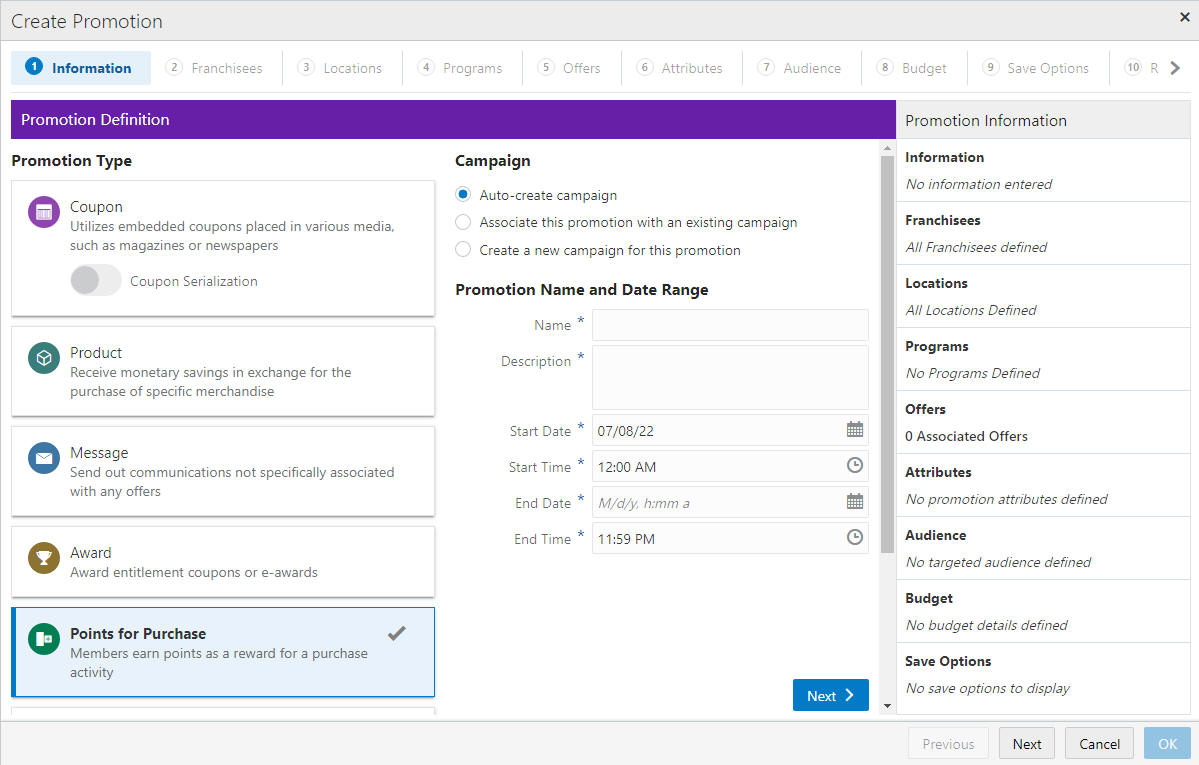
-
Select the Promotion Type: Points for Purchase
Note:
Contact your administrator if you do not see the Promotion Types needed for your promotion
-
Select one of the choices for the Campaign.
-
Auto-create Campaign – The campaign is automatically created and will use the same name and description from the promotion name and description.
-
Associate this promotion with an existing campaign – Uses existing campaigns in the system.
-
Click the list arrow and select an existing campaign.
Note:
The Start Date and End Date display underneath the Existing Campaign list.
-
-
Create a new campaign for this promotion – A new campaign is created with this promotion being the first added.
-
-
Enter the following information:
-
Enter a Campaign Name (for new Campaigns only).
-
Enter a Description (for new Campaigns only).
-
Enter a Name.
-
Enter a Description.
-
Select a Start Date.
-
Select a Start Time.
-
Select an End Date.
-
Select an End Time.
-
-
When finished entering the Campaign and Promotion information, click Next to continue to the Franchisees tab.
Note:
This tab will only display if the
EnableFranchiseSupportconfiguration is enabled, and Franchisees have been created. -
By default, all franchisees are assigned to the promotion. To make changes to those assignments, do the following:
Figure 5-75 Franchisees Tab

Assigning a Franchisee
-
Click the Actions Menu, then, click Assign, or click the Add (+) icon. This opens the Add Franchisee window.
Figure 5-76 Assign Franchisee

-
In the Search for franchisee search box, enter part or all of the Name, ID, or Description, then click Search.
Note:
You can also leave blank and click Search to return all Franchisees.
-
To change the assignment from ALL (which is defaulted) click Assign on just the specific franchisees you wish to assign for this promotion. Only Franchisees associated with the user are displayed in the list.
-
Click OK to accept the changes or Cancel to close the window without saving.
Figure 5-77 Confirmation Notification

Note:
A confirmation notification appears to confirm the franchisee has been assigned.
Deleting a Franchisee
-
In the included Franchisees window, highlight the desired row.
-
Click the Action Menu, and click Delete, or click the X icon.
Note:
A confirmation notification appears to confirm the franchisee has been deleted.
-
-
When finished entering the Franchisees information, click Next to continue to the Locations tab.
-
Enter the following for the Locations tab:
Figure 5-78 Locations Tab

Define Locations
Note:
By default, ALL locations are added to the promotion. You can select the Overflow Menu to edit the list of locations to include.
-
Included
-
If you wish to change the Locations assigned to this Promotion, click the Overflow Menu, then click Edit. This opens the Edit Location Rule window.
Figure 5-79 Edit Location Rule (Include)

Specific Locations
-
Click the Specific Location option.
Figure 5-80 Edit Location Rule (Include) - Specific Locations

Note:
The Location ID check box at the top of the list enables you to deselect or select all locations. If you deselect all the locations, then you can scroll through the list or search for a specific location.
-
Enter part or all of a Location ID or Name.
-
Click Search.
-
Click Add to select a location.
-
Click Add for another location means you are using the condition AND. Both conditions must be met.
-
Click OK and Add Another to keep you in the same search results and use the condition OR. One or more of the conditions must be met when you click Add for another location.
-
Click Ok to close the window, or click Cancel to close the window without saving.
Include by Attributes
-
Click the Include by Attributes option.
Figure 5-81 Edit Location Rule (Include) - Include by Attributes

Note:
A list of attributes enables you to add one more attributes in order to create a query to select only the locations that fit the requirements.
-
Click Add to select an attribute. Some Location Attributes can be collapsed or expanded. They will default to collapsed to allow you to scroll thru the list easier and expand the attributes they you to add.
-
Click Add for another attribute means you are using the condition AND. Both conditions must be met.
-
Click OK and Add Another to keep you in the same window and use the condition OR. One or more of the conditions must be met when you click the Add button for another attribute.
-
Click OK to close the window, or click Cancel to close the window without saving.
-
-
Excluded Locations - This option allows you to select specific locations to exclude from the promotion.
-
Click the Exclude Locations link.
Figure 5-82 Select Locations

Specific Locations
Figure 5-83 Edit Location Rule (Exclude) - Specific Locations

-
Click the Specific Location option.
Note:
The Location ID check box at the top of the list enables you to deselect or select all locations. If you deselect all the locations, then you can scroll through the list or search for a specific location.
-
Enter part or all of a Location ID or Name.
-
Click Search.
-
Click Add to select a location.
-
Click Add for another location means you are using the condition AND. Both conditions must be met.
-
Click OK and Add Another to keep you in the same search results and use the condition OR. One or more of the conditions must be met when you click Add for another location.
-
Click OK to close the window, or click Cancel to close the window without saving.
Exclude by Attributes
-
Click the Exclude by Attributes option.
Figure 5-84 Edit Location Rule (Exclude) - Exclude By Attributes

-
Click Add to select an attribute. Some Location Attributes can be collapsed or expanded. They will default to collapsed to allow you to scroll thru the list easier and expand the attributes they you to add.
-
Click Add for another attribute means you are using the condition AND. Both conditions must be met.
-
Click OK and Add Another to keep you in the same window and use the condition OR. One or more of the conditions must be met when you click Add for another attribute.
-
Click OK to close the window, or click Cancel to close the window without saving.
-
-
When finished entering Locations for the Promotion, click Next to continue to the Programs tab.
Figure 5-85 Programs Tab - Points for Purchase

-
To begin the Programs tab, take the following actions:
-
Select a Card.
A list of cards display all active cards for the user to select from. If there is only one card to select from, the card appears by default and the list arrow is unavailable for selection.
Note:
The Select Program Levels section title will contain the name of the card selected.
-
In the Filter for Select Programs Levels on field, enter all or part of the Program Name, Level Name, or Level Description of the specific loyalty program you want to search for.
Figure 5-86 Filter Results

-
Select one or more Loyalty Programs. The Deselect All Displayed Levels button clears all selections.
-
-
When finished selecting Loyalty Programs for the Promotion, click Next to continue to the Offers tab.
-
To begin the Offers tab, take the following actions:
There are two methods to add offers, either:
-
Select the Quick Add option to search for a known Offer ID.
-
Click +Add Offers for an Advanced Offer Search.
Figure 5-87 Offers Tab

Note:
Refer to Figure 5-87 to enter the Offer Code field. A retailer can use it to qualify or track a particular offer.
-
Click + Add Offers. The Add Offers window enables you to search for offers to include in the promotion. Once you receive the results of the search you can sort the results, if desired for easier selection, before adding them to the promotion. Those offers appear in the Included Offers panel.
Figure 5-88 Add Offers - Points for Purchase
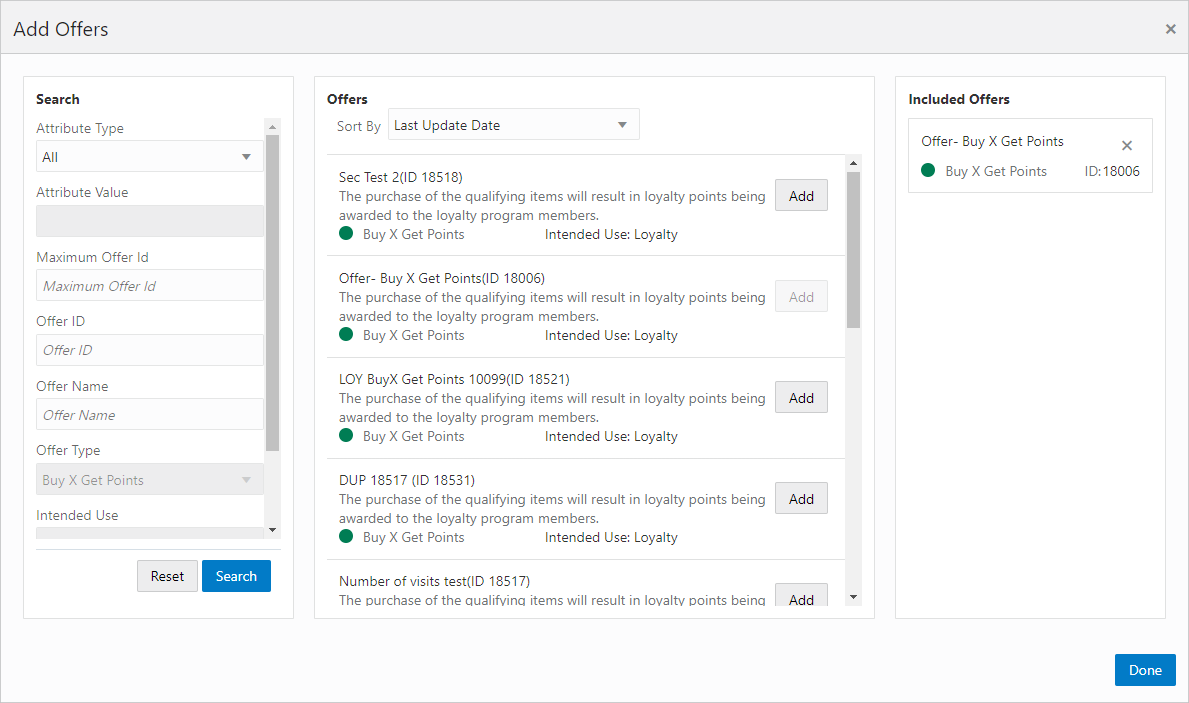
-
In the Search section, enter any or all of the following information:
-
Attribute Type – Search for an Offer by the Attribute assigned to the Offer. The default is ALL.
-
Attributes Value - Type-ahead search according to the Attribute Type selected.
-
Maximum Offer ID – Highest Offer ID number you wish to limit the search to. This will return that offer ID and all others with a lower number.
-
Offer ID – This Text Field searches all the Offers currently present in the application. The default is an empty field.
-
Offer Name – Name of the Offer.
-
Offer Type – Search the Offer by Offer Type (Single Select). The value Buy X Get Points is populated in the list of options.
-
Intended Use – The type of Promotion associated with the Offer you are searching for. The value Loyalty is populated in the list of actions.
-
-
Click Search.
Note:
To retrieve all the offers in the system, select Search without entering any search criteria. All offers are returned to the Offers results section. From there, you can scroll through the list to choose which offers to add.
To clear the search fields and restore default selections in the search page, click Reset.
-
Upon selecting Search, the results display in the Offers section. Use the Sort by list to sort by the following options:
-
Last Update Date
-
Offer Name
-
Offer Type
-
Intended Use
-
Offer ID
-
-
In the Add Offers window, you can select any of the offers in the Include Offers section and remove them by selecting the X in the top right corner of the Offer. Click Add to include the offers in the promotion.
-
When finished selecting offers to add to the Promotion, select Done, which returns you to the Select Offers window.
-
On the Select Offers window, you can select the Remove option from the Overflow Menu to remove an offer from the promotion.
-
Enter the Offer ID in the Quick Add field and then click Add to also add offers to a promotion.
Figure 5-89 Select Offers Quick Add

-
-
When finished entering Offers for the Promotion, click Next to continue to the Attributes tab.
-
Enter the following for the Attributes tab.
Figure 5-90 Promotion Attributes
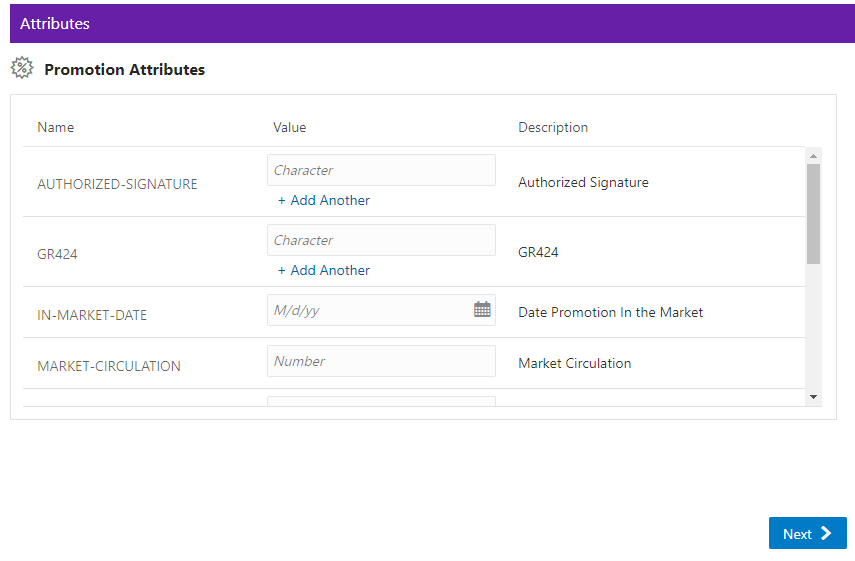
-
Complete values for any Promotion Attributes you want added to the promotion. Fields marked with an asterisk are required.
-
-
When finished adding Attributes for the Promotion, click Next to continue to the Audience tab.
-
Enter the following for the Audience tab.
Figure 5-91 Audience Tab

Audience Rules – Exclusive is only used here to define the audience.
Exclusive Targeting - If you create an exclusive targeted promotion, this means that only the customers you've identified in your target group are eligible to receive the promotion at the point of sale.
-
Selection Method
-
Static – Only customers defined at this time are considered eligible for the promotion.
-
Dynamic – Dynamic can not only add customers but also remove customers that no longer apply. When Dynamic is selected, Update Method is available.
New audience members will be added – When the Dynamic Promotions job runs, any new customers found that meet the criteria, are added to the audience. All customers currently in the audience will remain in the audience.
Audience members can be added and removed – When the Dynamic Promotions job runs, any new customers found that meet the criteria, are added to the audience. Additionally, only the customers that meet the criteria will be included in the audience. If the customer is in the audience before the job runs, but no longer meets the criteria, the customer will be removed from the audience.
-
Define Audience - Included Audience Groups
-
Click + Add Audience Group.
Figure 5-92 Add Audience Group (Include)

-
Select an Available List type
All - Default
Stratified - The Customers within a Stratified list are divided into levels.
Unstratified - The Customers within an Unstratified list are not differentiated into separate groups.
Personal - Customers maintained by the user.
-
In the Search field, enter some or all of the List Name, ID, or Strata Name.
-
Click Search. The results can be sorted by using the Sort by list menu with the following options:
Last Updated
Name
Customer Count
-
Enter a Group Name.
When lists are added from the Available Lists area, they appear in the Audience Groups section of the window. The Audience Group section Group Name automatically defaults to the name of the first list added. You can change the Group Name to something more meaningful to describe the group of customers, if desired.
Figure 5-93 Add Audience Group (Include)

-
Click Add to add the selection Assigned Audience Lists.
-
Click Add for another list means you are using the condition AND. Both conditions must be met.
-
Click OK and Add Another to keep you in the same window and use the condition OR. One or more of the conditions must be met when you click Add for another Audience Group.
Figure 5-94 Audience Definition
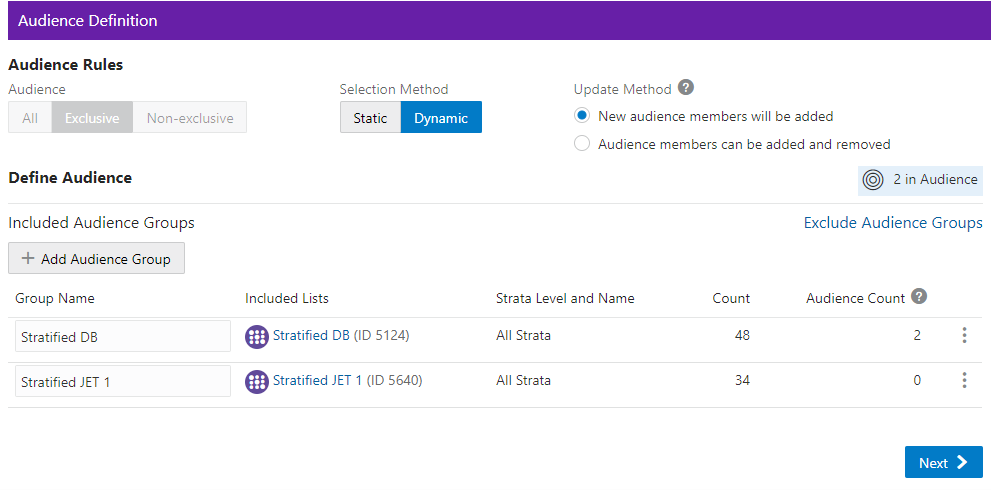
As shown in Figure 5-94 the Group Count is shown for each audience group. In the Audience Rules section the total count is provided on the right hand side.
Columns include the following details:
-
Group Name
-
Included Lists
-
Strata Level and Name
-
Count
-
Audience Count
Each Group Name has an Overflow Menu Icon where you can Edit or Remove the Audience Group from the list.
The Included Lists column displays a link on that list (also known as a segment) and that link will open to the Audience List Details window.
In this window, the following sections may display, depending on the type of list and which of the options were selected when the list was created:
-
List Options section
-
Criteria section
-
Trend Results section
-
Strata Levels section
-
Attributes section
-
Franchisees section
-
Message section
-
Scheduled Jobs section
Figure 5-95 List Details

The checked List Options vary by the selections made when the list was created, and may include the following fields:
-
Export – Indicates whether the Segment list is automatically exported after the Segment Query is run.
-
Open Access – Indicates whether the Segment has Open Access.
-
Permanent – Indicates whether the Segment is kept in the system, even if it meets the criteria for deletion by the housekeeping job.
-
Public – Indicates whether the Segment is Public.
-
Publish to Batch Exporter – Indicates whether the Segment has been made available for export to a Marketing system.
-
Publish to Clienteling – Indicates whether the Segment has been made available to the Clienteling module.
-
Publish to Task Generator – Indicates whether the Segment has been made available to the Task Generator Job.
-
Save as List – Indicates whether a list of matching Customer IDs is created when the Segment is created.
-
Trend Results – Indicates whether the results of the Segment run are kept to provide trend information about the Segment.
Figure 5-96 displays the Trend Results in a chart. A user can scroll down to see a table as shown in Figure 5-97, which for this segment shows the Strata Levels Against Customer Age and displays the strata that are shown in the graph.
Figure 5-96 List Details Trend Results - Chart

Figure 5-97 Trend Results Graph - Table

Figure 5-98 List Details Trend Results - Table

-
Click Done to close the Audience List Details window.
Figure 5-99 Audience Definition - Exclude Audience Groups
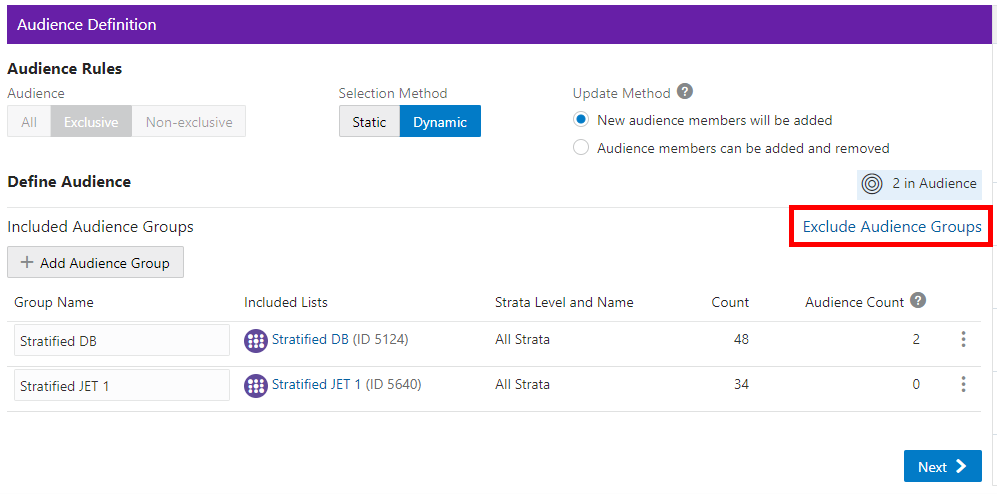
Exclude Audience Groups - If you wish to exclude certain groups of customers that may also be a part of the Included Group, you can do that by selecting the Exclude Audience Groups link, which opens a new section in the Audience Definition window
-
Select the Exclude Audience Groups link.
-
Click + Add Audience Group.
-
Select an Available List type.
-
-
All – Default group listing.
-
Stratified – The Customers within a Stratified list are divided into levels.
-
Unstratified – The Customers within an Unstratified list are not differentiated into separate groups.
-
Personal – User created groups.
-
-
In the Search field, enter some or all of the List Name, ID, or Strata Name.
-
Click Search.
-
The results can be sorted by using the Sort by list menu with the following options:
-
Last Updated
-
Name
-
Customer Count
-
-
Enter a Group Name.
-
Click Add to add the selection Assigned Audience Lists.
-
Click Add for another list means you are using the condition AND. Both conditions must be met.
-
Click OK and Add Another to keep you in the same window and use the condition OR. One or more of the conditions must be met when you click Add for another Audience Group.
-
-
When finished entering all Audience Groups for the Promotion, click Next.
-
Enter the following for the Filtering Audience tab.
Figure 5-100 Filtering Audience Tab

Use the Customer Household Consolidation Selection Menu to indicate whether the Promotion will use household consolidation, and the rule for determining the Customer who is the head of household.
-
None – Do not perform household filtering.
-
LT Sales – Select head of household based on amount purchased over the lifetime of their account.
-
LT Transaction Count – Select head of household based on lifetime number of transactions.
-
Last Transaction Date – Select head of household based on the Customer who performed the most recent transaction.
-
Customer Attributes – Select head of household based on the Customer's numeric attributes.
Select the Filter Type for each Audience:
Figure 5-101 Select Desired Filtering

-
None - [DEFAULT] All Customers in the Audience Group are eligible.
-
Top Sales - Customers from the Audience Group will be chosen for eligibility by the greatest total amount of purchases.
-
Random - Customers from the Audience Group will be chosen randomly for eligibility.
Enter a filter value to indicate the number of customers eligible for the promotion.
-
-
When finished entering any household filtering for the Audience Groups for the Promotion, click Next to continue to the Split Audience tab.
-
In the Split Audience tab, filtered audiences can, optionally, be split into smaller, separate audiences. If desired, create splits for the filtered audiences on the promotion.
-
Click Split.
Figure 5-102 Split Audience Groups

-
The Split Name field is automatically populated from the name of the Audience Group Name. If desired, you can change the name of the splits in this step.
-
Select Split to automatically divide the Audience Group into equal portions and percentages. If you desire different portions or percentages for the splits, enter either a count or a percentage, and the corresponding field will update.
-
-
When finished entering any Audience Group splits for the Promotion, click Next to continue to the Control Groups tab.
-
Enter the following information for the Control Groups tab.
Figure 5-103 Define Control Groups

The control group is a statistically identical group that doesn't receive the offer. Following the promotional period, the results of the two groups are compared and you can determine if the offer generated incremental revenue. Options include:
-
None – No Control Group
-
By Promotion – Enter either a New Count or Percent. The corresponding field will update automatically to determine the size of the control group.
-
By Audience Group – Enter either a Control Group count or percentage for each split created earlier. The corresponding field will update automatically.
-
-
When finished entering any Control Groups for the Promotion, click Next to continue to the Export Channels tab.
-
Enter the following information for the Export Channels tab. The options include:
Figure 5-104 Export Channels Tab

Mail - Determines whether the Customers in the Split/Control Group will be contacted by Mail.
EMail / Batch Exporter - Determines whether the Customers in the Split/Control Group will be contacted by Email.
Note:
The system configuration setting SupportedBatchExporters determines if the Batch Exporter section is displayed.
-
Export Filename – Name of the file.
-
Prefix – Indicates the format of the datetime stamp used as a prefix the filename. Optional. Possible settings are yyyyMMdd_HHmmss, yyyy-MMdd_HHmmss, or none.
-
Static Name – The identifying filename.
-
Suffix – Indicates the format of the datetime stamp used as a suffix the filename. Optional. Possible settings are yyyyMMdd_HHmmss, yyyy-MMdd_HHmmss, or none.
-
Filename – Displays an example of the export file name with the prefix and suffix format, if any.
Phone - Determines whether the Customers are contacted by phone.
Clienteling – When the Clienteling switch is turned on, tasks will be created based on the assigned associates or locations for the defined target audience when the promotion is generated.
Figure 5-105 Clienteling Details

Assign Tasks to:
-
Location Channel – Tasks are assigned to a Location.
-
Associate Channel – Tasks are assigned to an associate in a location.
The following fields are enabled if the Filter option is selected:
-
Max Count Per <type> - Determines the maximum number of target Customers that will be contacted through the channel.
-
Method - Method used to select the Customers contacted. Options include:
-
Random - Select Customers Randomly (Default).
-
Top - Recent Purchase - Filter the Customers based on the most recent purchases.
-
Top - LT Sales - Filter the Customers based on the largest amount purchased over the lifetime of their account.
-
Top - Numeric Attribute - Filter the Customers based on the highest attribute value for a selected numeric attribute. If this option is selected, an additional Channel Filter option, Attribute, displays. Attribute is the numeric attribute used to determine the customers contacted
-
-
-
When finished entering any Export Channels for the Promotion, click Next to continue to the Budget tab.
-
Enter the following information on the Budget tab.
Figure 5-106 Budget Tab

-
Click Add to enter the Promotion Costs. Enter values in any field is optional.
-
Enter a Description of the cost item.
-
Enter the budgeted amount for the Promotion in the Budget Amount field.
-
Enter the actual amount for the Promotion in the Actual Amount field.
-
Click Add if you wish to enter another budget line for the promotion, then follow steps a-d to complete the fields.
If Export Channels were selected for the audience group, the Audience Groups Costs section appears. Entering values in any field is optional.
Figure 5-107 Audience Group Costs

-
In the Budget-Fixed field, enter the fixed cost budgeted for the audience.
-
In the Budget-CPM field, enter the cost budgeted for the Channel for each 1,000 Customers.
-
In the Actual-Fixed field, enter the actual fixed cost of the Channel.
-
In the Actual-CPM field, enter the actual cost of the Channel for each 1,000 Customers.
-
Repeat steps f-i for each Target Channel in the Promotion.
-
-
When finished entering any Budget Costs for the Promotion, click Next to continue to the Save Options tab.
-
Enter the following information in the Save Options tab. You can enter more than one choice.
Figure 5-108 Options After Save Tab
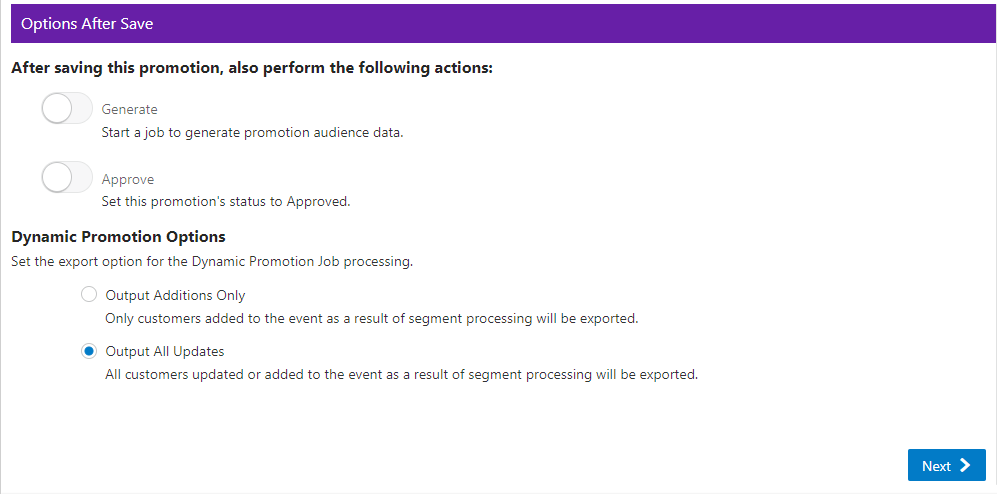
-
Generate – Start a job to generate promotion audience data.
-
Approve – Set this promotion's status to Approved.
-
Dynamic Promotion Options – Select one of the two export options for processing when using the Dynamic selection method on the Audience tab.
Note:
Depending on the type of promotion that you created, different Options After Save are available.
-
-
When finished entering any Save Options for the Promotion, click Next.
-
The Review tab displays the key elements in the Promotion Setup.
Figure 5-109 Review Tab
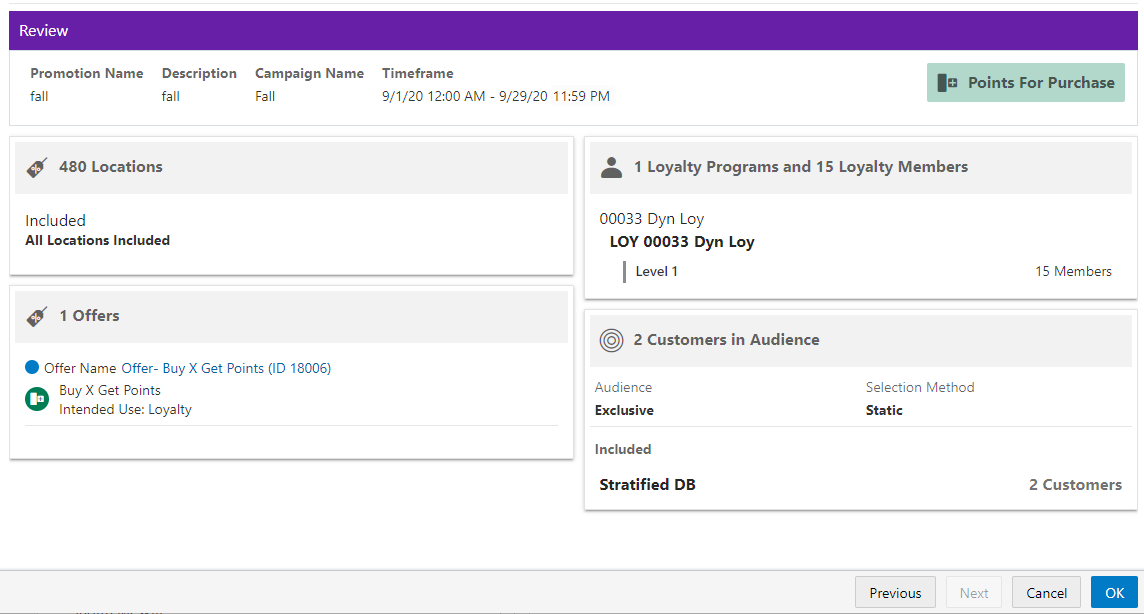
-
Click OK to save the Promotion, or click Cancel to close the promotion without saving. Click Previous or any Tab to return to any point of the Create Promotion process.
Creating a Points for Marketing Engagements Promotion
There are a few choices available to start the process of creating a promotion. The Create Promotion button is available in both the Promotion Home window as well as the Promotion Search window.
Note:
You will need the Promotion Home role to access the Promotion Home window.
-
Click Create Promotion, which opens up the Promotion wizard to the Information tab.
Figure 5-110 Information Tab - Points for Marketing
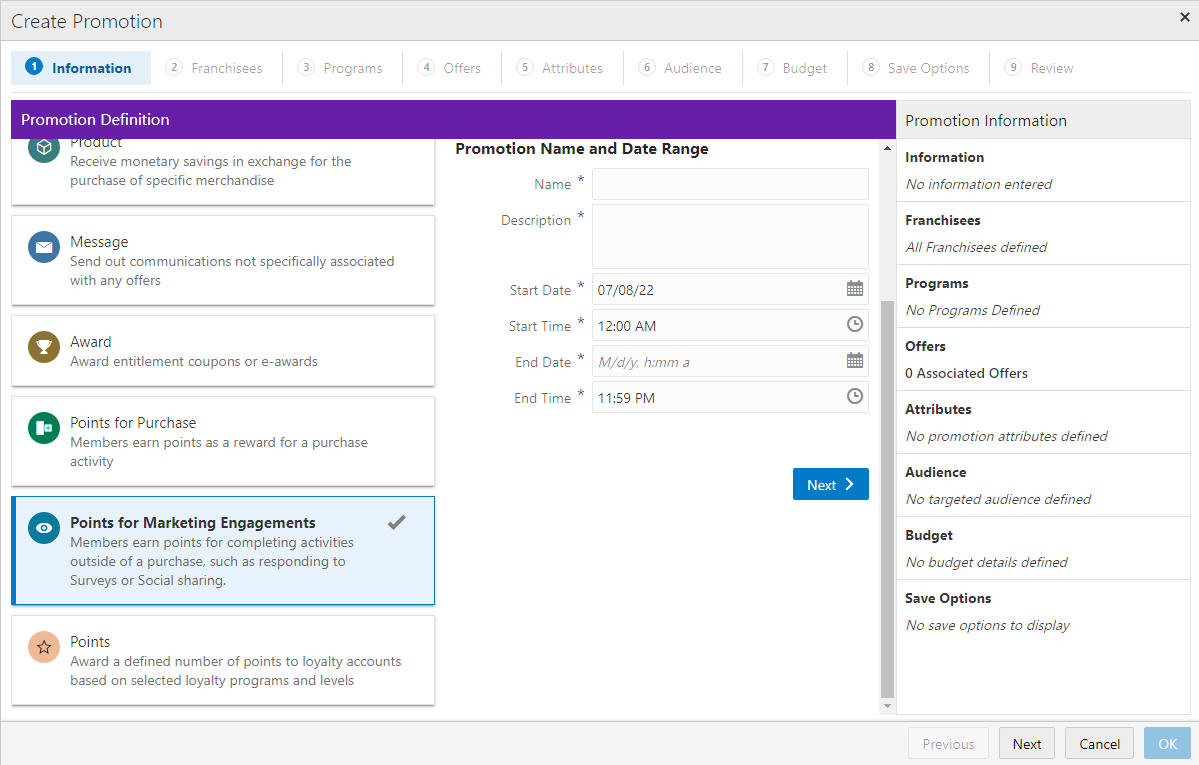
-
Select the Promotion Type: Points for Marketing Engagements.
Note:
Contact your administrator if you do not see the Promotion Types needed for your promotion
-
Select one of the choices for the Campaign.
-
Auto-create Campaign – The campaign is automatically created and will use the same name and description from the promotion name and description.
-
Associate this promotion with an existing campaign – Uses existing campaigns in the system.
-
Click the list arrow and select an existing campaign.
Note:
The Start Date and End Date display underneath the Existing Campaign list.
-
-
Create a new campaign for this promotion – A new campaign is created with this promotion being the first added.
-
-
Enter the following information:
-
Enter a Campaign Name (for new Campaigns only).
-
Enter a Description (for new Campaigns only).
-
Enter a Name.
-
Enter a Description.
-
Select a Start Date.
-
Select a Start Time.
-
Select an End Date.
-
Select an End Time.
-
-
When finished entering the Campaign and Promotion information, click Next to continue to the Franchisees tab.
Note:
This tab will only display if the
EnableFranchiseSupportconfiguration is enabled, and Franchisees have been created. -
By default, all franchisees are assigned to the promotion. To make changes to those assignments, do the following:
Figure 5-111 Franchisees Tab

Assigning a Franchisee
-
Click the Actions Menu, then, click Assign, or click the Add (+) icon. This opens the Add Franchisee window.
Figure 5-112 Assign Franchisee

-
In the Search for franchisee search box, enter part or all of the Name, ID, or Description, then click Search.
Note:
You can also leave blank and click Search to return all Franchisees.
-
To change the assignment from ALL (which is defaulted) click Assign on just the specific franchisees you wish to assign for this promotion. Only Franchisees associated with the user are displayed in the list.
-
Click OK to accept the changes or Cancel to close the window without saving.
Figure 5-113 Confirmation Notification

Note:
A confirmation notification appears to confirm the franchisee has been assigned.
Deleting a Franchisee
-
In the included Franchisees window, highlight the desired row.
-
Click the Action Menu, and click Delete, or click the X icon.
Note:
A confirmation notification appears to confirm the franchisee has been deleted.
-
-
When finished entering the Franchisees information, click Next to continue to the Programs tab.
Figure 5-114 Programs Tab

-
To begin the Programs tab, take the following actions:
-
Select a Card.
A list of cards display all active cards for the user to select from. If there is only one card to select from, the card appears by default and the list arrow is unavailable for selection.
Note:
The Select Program Levels section title will contain the name of the card selected.
-
In the Filter for Select Programs Levels on field, enter all or part of the Program Name, Level Name, or Level Description of the specific loyalty program you want to search for.
Figure 5-115 Filter Results

-
Select one or more Loyalty Programs. The Deselect All Displayed Levels button clears all selections.
-
-
When finished selecting Loyalty Programs for the Promotion, click Next to continue to the Offers tab.
-
To begin the Offers tab, take the following actions:
There are two methods to add offers, either:
-
Select the Quick Add option to search for a known Offer ID.
-
Click +Add Offers for an Advanced Offer Search.
Figure 5-116 Offers Tab

Note:
Refer to Figure 5-116 to enter the Offer Code field. A retailer can use it to qualify or track a particular offer.
-
Click + Add Offers. The Add Offers window enables you to search for offers to include in the promotion. Once you receive the results of the search you can sort the results, if desired for easier selection, before adding them to the promotion. Those offers appear in the Included Offers panel.
Figure 5-117 Add Offers - Marketing Engagements

-
In the Search section, enter any or all of the following information:
-
Attribute Type – Search for an Offer by the Attribute assigned to the Offer. The default is ALL.
-
Attributes Value - Type-ahead search according to the Attribute Type selected.
-
Maximum Offer ID – Highest Offer ID number you wish to limit the search to. This will return that offer ID and all others with a lower number.
-
Offer ID – This Text Field searches all the Offers currently present in the application. The default is an empty field.
-
Offer Name – Name of the Offer.
-
Offer Type – Search the Offer by Offer Type (Single Select). The value Marketing Engagements is populated in the list of options.
-
Intended Use – The type of Promotion associated with the Offer you are searching for. The value Loyalty Marketing Engagement is populated.
-
-
Click Search.
Note:
To retrieve all the offers in the system, select Search without entering any search criteria. All offers are returned to the Offers results section. From there, you can scroll through the list to choose which offers to add.
To clear the search fields and restore default selections in the search page, click Reset.
-
Upon selecting Search, the results display in the Offers section. Use the Sort by list to sort by the following options:
-
Last Update Date
-
Offer Name
-
Offer Type
-
Intended Use
-
Offer ID
-
-
In the Add Offers window, you can select any of the offers in the Include Offers section and remove them by selecting the X in the top right corner of the Offer. Click Add to include the offers in the promotion.
-
When finished selecting offers to add to the Promotion, select Done, which returns you to the Select Offers window.
-
On the Select Offers window, you can select the Remove option from the Overflow Menu to remove an offer from the promotion.
-
Enter the Offer ID in the Quick Add field and then click Add to also add offers to a promotion.
Figure 5-118 Select Offers Quick Add

-
-
When finished entering Offers for the Promotion, click Next to continue to the Attributes tab.
-
Enter the following for the Attributes tab.
Figure 5-119 Promotion Attributes

-
Complete values for any Promotion Attributes you want added to the promotion. Fields marked with an asterisk are required.
-
-
When finished adding Attributes for the Promotion, click Next to continue to the Audience tab.
-
Enter the following for the Audience tab.
Figure 5-120 Audience Tab

Audience Rules – Exclusive is only used here to define the audience.
Exclusive Targeting - If you create an exclusive targeted promotion, this means that only the customers you've identified in your target group are eligible to receive the promotion at the point of sale.
-
Selection Method
-
Static – Only customers defined at this time are considered eligible for the promotion.
-
Dynamic – Dynamic can not only add customers but also remove customers that no longer apply. When Dynamic is selected, Update Method is available.
New audience members will be added – When the Dynamic Promotions job runs, any new customers found that meet the criteria, are added to the audience. All customers currently in the audience will remain in the audience.
Audience members can be added and removed – When the Dynamic Promotions job runs, any new customers found that meet the criteria, are added to the audience. Additionally, only the customers that meet the criteria will be included in the audience. If the customer is in the audience before the job runs, but no longer meets the criteria, the customer will be removed from the audience.
-
Define Audience - Included Audience Groups
-
Click + Add Audience Group.
Figure 5-121 Add Audience Group (Include)

-
Select an Available List type
All - Default
Stratified - The Customers within a Stratified list are divided into levels.
Unstratified - Customers maintained by the user.
Personal - Customers maintained by the user.
-
In the Search field, enter some or all of the List Name, ID, or Strata Name.
-
Click Search. The results can be sorted by using the Sort by list menu with the following options:
Last Updated
Name
Customer Count
-
Enter a Group Name.
When lists are added from the Available Lists area, they appear in the Audience Groups section of the window. The Audience Group section Group Name automatically defaults to the name of the first list added. You can change the Group Name to something more meaningful to describe the group of customers, if desired.
Figure 5-122 Add Audience Group (Include)

-
Click Add to add the selection Assigned Audience Lists.
-
Click Add for another list means you are using the condition AND. Both conditions must be met.
-
Click OK and Add Another to keep you in the same window and use the condition OR. One or more of the conditions must be met when you click Add for another Audience Group.
Figure 5-123 Audience Definition

As shown in Figure 5-123 the Audience Count is shown for each audience group. In the Audience Rules section the Audience count is provided on the right hand side.
Columns include the following details:
-
Group Name
-
Included Lists
-
Strata Level and Name
-
Count
-
Audience Count
Each Group Name has an Overflow Menu Icon where you can Edit or Remove the Audience Group from the list.
The Included Lists column displays a link on that list (also known as a segment) and that link will open to the Audience List Details window.
In this window, the following sections may display, depending on the type of list and which of the options were selected when the list was created:
-
List Options section
-
Criteria section
-
Trend Results section
-
Strata Levels section
-
Attributes section
-
Franchisees section
-
Message section
-
Scheduled Jobs section
Figure 5-124 List Details

The checked List Options vary by the selections made when the list was created, and may include the following fields:
-
Export – Indicates whether the Segment list is automatically exported after the Segment Query is run.
-
Open Access – Indicates whether the Segment has Open Access.
-
Permanent – Indicates whether the Segment is kept in the system, even if it meets the criteria for deletion by the housekeeping job.
-
Public – Indicates whether the Segment is Public.
-
Publish to Batch Exporter – Indicates whether the Segment has been made available for export to a Marketing system.
-
Publish to Clienteling – Indicates whether the Segment has been made available to the Clienteling module.
-
Publish to Task Generator – Indicates whether the Segment has been made available to the Task Generator Job.
-
Save as List – Indicates whether a list of matching Customer IDs is created when the Segment is created.
-
Trend Results – Indicates whether the results of the Segment run are kept to provide trend information about the Segment.
Figure 5-125 displays the Trend Results in a chart. A user can scroll down to see a table as shown in Figure 5-125, which for this segment shows the Strata Levels Against Customer Age and displays the strata that are shown in the graph.
Figure 5-125 List Details Trend Results - Chart

Figure 5-126 Trend Results Graph - Table

Figure 5-127 List Details Trend Results - Table

-
Click Done to close the Audience List Details window.
Figure 5-128 Audience Definition - Exclude Audience Groups

Exclude Audience Groups - If you wish to exclude certain groups of customers that may also be a part of the Included Group, you can do that by selecting the Exclude Audience Groups link, which opens a new section in the Audience Definition window
-
Select the Exclude Audience Groups link.
-
Click + Add Audience Group.
-
Select an Available List type.
-
-
All – Default group listing.
-
Stratified – The Customers within a Stratified list are divided into levels.
-
Unstratified – The Customers within an Unstratified list are not differentiated into separate groups.
-
Personal – User created groups.
-
-
In the Search field, enter some or all of the List Name, ID, or Strata Name.
-
Click Search.
-
The results can be sorted by using the Sort by list menu with the following options:
-
Last Updated
-
Name
-
Customer Count
-
-
Enter a Group Name.
-
Click Add to add the selection Assigned Audience Lists.
-
Click Add for another list means you are using the condition AND. Both conditions must be met.
-
Click OK and Add Another to keep you in the same window and use the condition OR. One or more of the conditions must be met when you click Add for another Audience Group.
-
-
When finished entering all Audience Groups for the Promotion, click Next.
-
Enter the following for the Filtering Audience tab.
Figure 5-129 Filtering Audience Tab

Use the Customer Household Consolidation Selection Menu to indicate whether the Promotion will use household consolidation, and the rule for determining the Customer who is the head of household.
-
None – Do not perform household filtering.
-
LT Sales – Select head of household based on amount purchased over the lifetime of their account.
-
LT Transaction Count – Select head of household based on lifetime number of transactions.
-
Last Transaction Date – Select head of household based on the Customer who performed the most recent transaction.
-
Customer Attributes – Select head of household based on the Customer's numeric attributes.
Select the Filter Type for each Audience:
Figure 5-130 Select Desired Filtering

-
None - [DEFAULT] All Customers in the Audience Group are eligible.
-
Top Sales - Customers from the Audience Group will be chosen for eligibility by the greatest total amount of purchases.
-
Random - Customers from the Audience Group will be chosen randomly for eligibility.
Enter a filter value to indicate the number of customers eligible for the promotion.
-
-
When finished entering any household filtering for the Audience Groups for the Promotion, click Next to continue to the Split Audience tab.
-
In the Split Audience tab, filtered audiences can, optionally, be split into smaller, separate audiences. If desired, create splits for the filtered audiences on the promotion.
-
Click Split.
Figure 5-131 Split Audience Groups

-
The Split Name field is automatically populated from the name of the Audience Group Name. If desired, you can change the name of the splits in this step.
-
Select Split to automatically divide the Audience Group into equal portions and percentages. If you desire different portions or percentages for the splits, enter either a count or a percentage, and the corresponding field will update.
-
-
When finished entering any Audience Group splits for the Promotion, click Next to continue to the Control Groups tab.
-
Enter the following information for the Control Groups tab.
Figure 5-132 Define Control Groups

The control group is a statistically identical group that doesn't receive the offer. Following the promotional period, the results of the two groups are compared and you can determine if the offer generated incremental revenue. Options include:
-
None – No Control Group
-
By Promotion – Enter either a New Count or Percent. The corresponding field will update automatically to determine the size of the control group.
-
By Audience Group – Enter either a Control Group count or percentage for each split created earlier. The corresponding field will update automatically.
-
-
When finished entering any Control Groups for the Promotion, click Next to continue to the Export Channels tab.
-
Enter the following information for the Export Channels tab. The options include:
Figure 5-133 Export Channels Tab

Mail - Determines whether the Customers in the Split/Control Group will be contacted by Mail.
EMail / Batch Exporter - Determines whether the Customers in the Split/Control Group will be contacted by Email.
Note:
The system configuration setting SupportedBatchExporters determines if the Batch Exporter section is displayed.
-
Export Filename – Name of the file.
-
Prefix – Indicates the format of the datetime stamp used as a prefix the filename. Optional. Possible settings are yyyyMMdd_HHmmss, yyyy-MMdd_HHmmss, or none.
-
Static Name – The identifying filename.
-
Suffix – Indicates the format of the datetime stamp used as a suffix the filename. Optional. Possible settings are yyyyMMdd_HHmmss, yyyy-MMdd_HHmmss, or none.
-
Filename – Displays an example of the export file name with the prefix and suffix format, if any.
Phone - Determines whether the Customers are contacted by phone.
Clienteling – When the Clienteling switch is turned on, tasks will be created based on the assigned associates or locations for the defined target audience when the promotion is generated.
Figure 5-134 Clienteling Details

Assign Tasks to:
-
Location Channel – Tasks are assigned to a Location.
-
Associate Channel – Tasks are assigned to an associate in a location.
The following fields are enabled if the Filter option is selected:
-
Max Count Per <type> - Determines the maximum number of target Customers that will be contacted through the channel.
-
Method - Method used to select the Customers contacted. Options include:
-
Random - Select Customers Randomly (Default).
-
Top - Recent Purchase - Filter the Customers based on the most recent purchases.
-
Top - LT Sales - Filter the Customers based on the largest amount purchased over the lifetime of their account.
-
Top - Numeric Attribute - Filter the Customers based on the highest attribute value for a selected numeric attribute. If this option is selected, an additional Channel Filter option, Attribute, displays. Attribute is the numeric attribute used to determine the customers contacted
-
-
-
When finished entering any Export Channels for the Promotion, click Next to continue to the Event Definition tab.
-
Enter the following information on the Event Definition tab.
Note:
The Event Definition Tab displays only when the Promotion uses the Clienteling Channel.
Figure 5-135 Event Definitions Tab

Enter a description of the Event in the Event Description field (required).
Select the Edit option to add an image to the Event.
-
Perform one of the following actions:
Click Drop a new image here or click to upload to add the image and continue to Step 31.b.
Enter a URL in Or Via URL and click Upload and continue to Step 31.b.
Click Remove Image to remove the image and continue to Step 31.b.
-
Click Done to save the changes and close the window, or click Cancel to close the window without saving any changes.
Event Task Escalation – This option will flag an Event Task for the promotion as high priority on the Day Planner Task panel based on the number days before the end date of the promotion event task.
Event Documents – Click the Action Menu, and click Add, or click the Add icon (+) to open the Add Event Documents window.
Figure 5-136 Add Event Documents

-
Use the Drop a file here or click to upload area to add an event document.
-
Click OK to save the changes and close the window, or click Cancel to close the window without saving any changes.
-
-
When finished entering any Event Definitions for the Promotion, click Next to continue to the Budget tab.
-
Enter the following information on the Budget tab.
Figure 5-137 Budget Tab

-
Click Add to enter the Promotion Costs. Enter values in any field is optional.
-
Enter a Description of the cost item.
-
Enter the budgeted amount for the Promotion in the Budget Amount field.
-
Enter the actual amount for the Promotion in the Actual Amount field.
-
Click Add if you wish to enter another budget line for the promotion, then follow Steps a-d to complete the fields.
If Export Channels were selected for the audience group, the Audience Groups Costs section appears. Entering values in any field is optional.
Figure 5-138 Audience Group Costs

-
In the Budget-Fixed field, enter the fixed cost budgeted for the audience.
-
In the Budget-CPM field, enter the cost budgeted for the Channel for each 1,000 Customers.
-
In the Actual-Fixed field, enter the actual fixed cost of the Channel.
-
In the Actual-CPM field, enter the actual cost of the Channel for each 1,000 Customers.
-
Repeat steps f-i for each Target Channel in the Promotion.
-
-
When finished entering any Budget Costs for the Promotion, click Next to continue to the Save Options tab.
-
Enter the following information in the Save Options tab. You can enter more than one choice.
Figure 5-139 Options After Save Tab

-
Generate – Start a job to generate promotion audience data.
-
Approve – Set this promotion's status to Approved.
-
Dynamic Promotion Options – Select one of the two export options for processing when using the Dynamic selection method on the Audience tab.
Note:
Depending on the type of promotion that you created, different Options After Save are available.
-
-
When finished entering any Save Options for the Promotion, click Next.
-
The Review tab displays the key elements in the Promotion Setup.
Figure 5-140 Review Tab
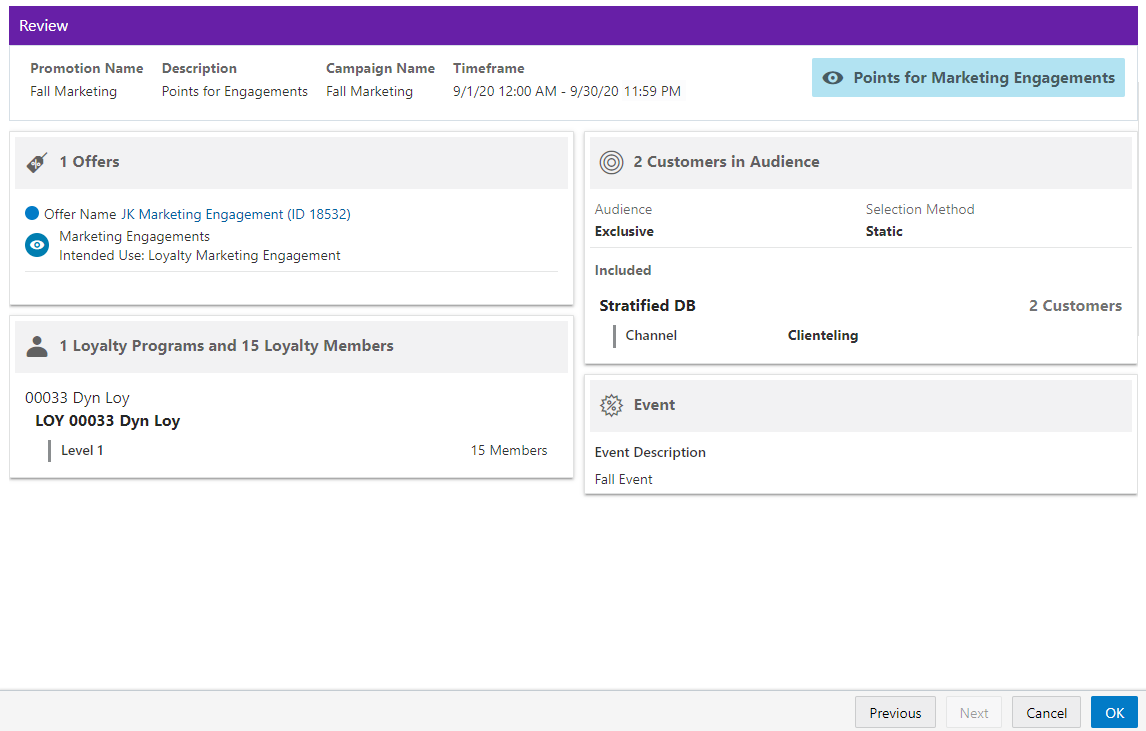
-
Click OK to save the Promotion, or click Cancel to close the promotion without saving. Click Previous or any Tab to return to any point of the Create Promotion process.
Creating a Points Promotion
There are a few choices available to start the process of creating a promotion. The Create Promotion button is available in both the Promotion Home window as well as the Promotion Search window.
Note:
You will need the Promotion Home role to access the Promotion Home window.
-
Click Create Promotion, which opens up the Promotion wizard to the Information tab.
Figure 5-141 Information Tab - Points

-
Select the Promotion Type: Points
Note:
Contact your administrator if you do not see the Promotion Types needed for your promotion
-
Select one of the choices for the Campaign.
-
Auto-create Campaign – The campaign is automatically created and will use the same name and description from the promotion name and description.
-
Associate this promotion with an existing campaign – Uses existing campaigns in the system.
-
Click the list arrow and select an existing campaign.
Note:
The Start Date and End Date display underneath the Existing Campaign list.
-
-
Create a new campaign for this promotion – A new campaign is created with this promotion being the first added.
-
-
Enter the following information:
-
Enter a Campaign Name (for new Campaigns only).
-
Enter a Description (for new Campaigns only).
-
Enter a Name.
-
Enter a POS Name.
-
Enter a Description.
-
Select a Start Date.
-
Select a Start Time.
-
Select an End Date.
-
Select an End Time.
-
-
When finished entering the Campaign and Promotion information, click Next to continue to the Franchisees tab.
Note:
This tab will only display if the
EnableFranchiseSupportconfiguration is enabled, and Franchisees have been created. -
By default, all franchisees are assigned to the promotion. To make changes to those assignments, do the following:
Figure 5-142 Franchisees Tab

Assigning a Franchisee
-
Click the Actions Menu, then, click Assign, or click the Add (+) icon. This opens the Add Franchisee window.
Figure 5-143 Assign Franchisee

-
In the Search for franchisee search box, enter part or all of the Name, ID, or Description, then click Search.
Note:
You can also leave blank and click Search to return all Franchisees.
-
To change the assignment from ALL (which is defaulted) click Assign on just the specific franchisees you wish to assign for this promotion. Only Franchisees associated with the user are displayed in the list.
-
Click OK to accept the changes or Cancel to close the window without saving.
Figure 5-144 Confirmation Notification

Note:
A confirmation notification appears to confirm the franchisee has been assigned.
Deleting a Franchisee
-
In the included Franchisees window, highlight the desired row.
-
Click the Action Menu, and click Delete, or click the X icon.
Note:
A confirmation notification appears to confirm the franchisee has been deleted.
-
-
When finished entering the Franchisees information, click Next to continue to the Attributes tab.
-
Enter the following for the Attributes tab.
Figure 5-145 Select Attributes

Complete values for any Promotion Attributes you want added to the promotion. Fields marked with an asterisk are required.
-
When finished adding Attributes for the Promotion, click Next to continue to the Bonus Points tab.
-
Take the following actions for the Bonus Points tab.
Figure 5-146 Bonus Points Tab
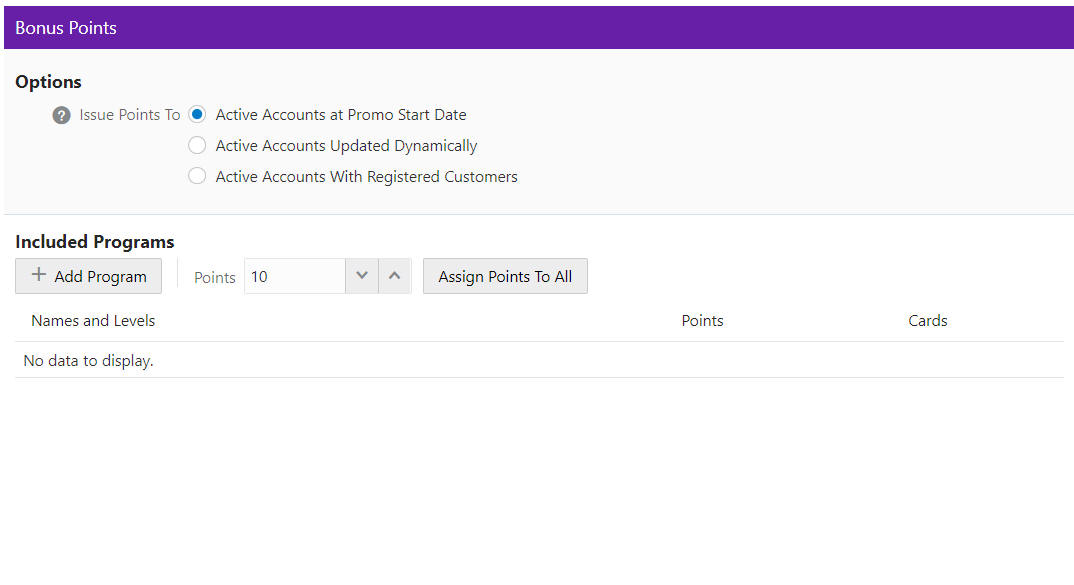
-
Select one of the following options:
-
Active Accounts at Promo Start Date -The bonus points will be applied to all active accounts for the selected Loyalty Programs and Levels. This will apply to all accounts regardless if there is a customer registered to the account.
-
Active Accounts Updated Dynamically - The bonus points will be applied to all active accounts for the selected Loyalty Programs and Levels. Additionally, any accounts added during the promotion period will also receive the bonus points. This will apply to all accounts regardless if there is a customer registered to the account.
-
Active Accounts With Registered Customers - The bonus points will be applied to all active accounts for the selected Loyalty Programs and Levels. This will apply to only accounts that have a customer registered to the account. Additionally, this will enable the Audience tab to display and provide the ability to further define the loyalty members that receive the promotion by selecting appropriate segments.
-
-
Click + Add Programs.
Result: The Add Programs window appears.
Figure 5-147 Add Programs
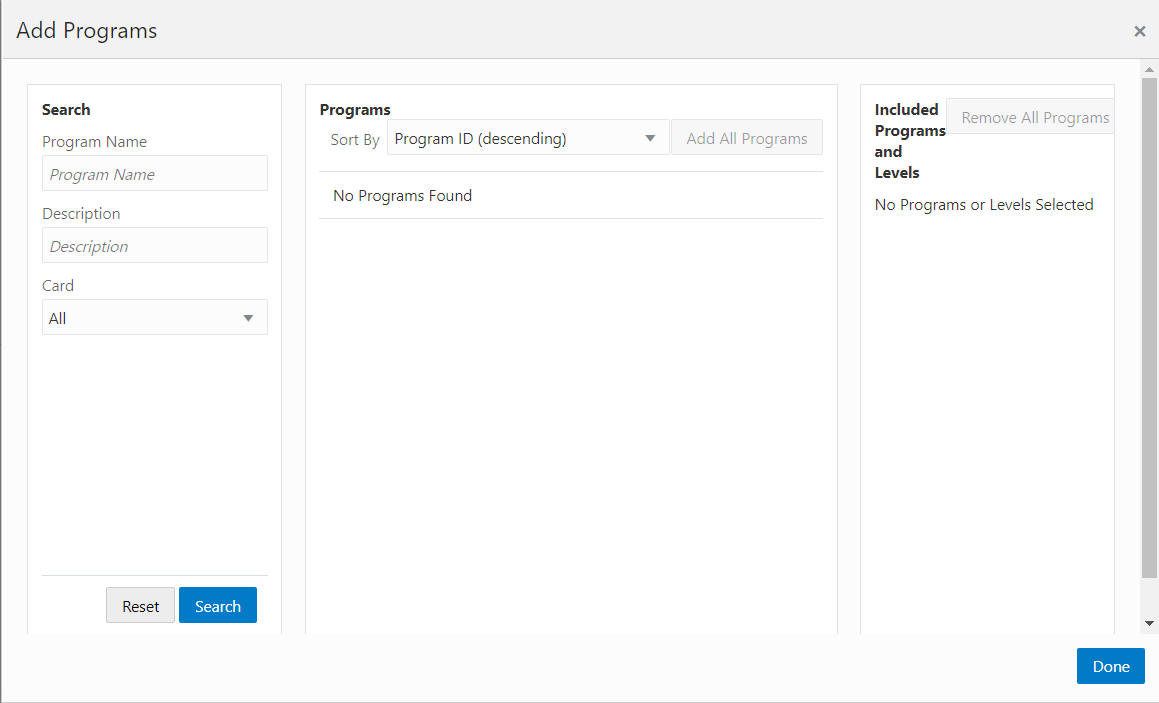
-
In the Search for programs search box, enter part or all of the Program Name, or Description.
-
Click the Card options list
-
Select a Card.
A list of cards display all active cards for the user to select from. If there is only one card to select from, the card appears by default and the list arrow is unavailable for selection. The default card selection is All.
-
-
Click Search to view the results, or click Reset to clear the selections. All programs appear if no criteria is entered.
Figure 5-148 Add Programs Search Results
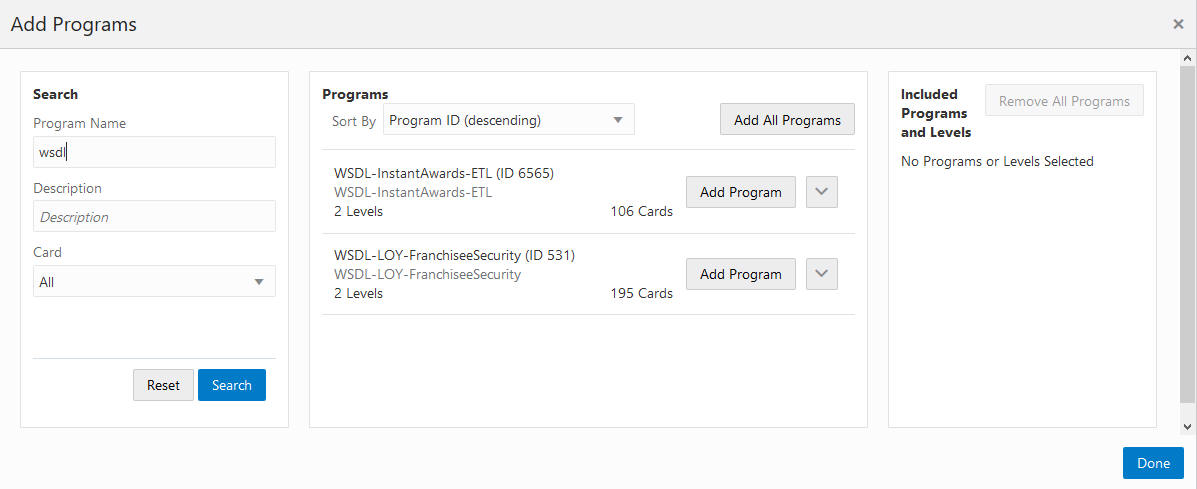
-
Sorting options include:
-
Program ID (ascending)
-
Program ID (descending) - Default
-
Program Name (ascending)
-
Program Name (descending)
-
-
-
To add a program perform one of the following options:
Figure 5-149 Programs Search Results Options

-
Click Add All Programs to include all programs listed in the search results.
-
Click Add Program to include the program and all levels in that program.
-
Click either the up or down arrows located next to Add Program to hide/display the available levels for each program. Click Add to only add a specific loyalty level for each program.
-
-
To remove included programs and levels click the X icon for each entry. You can also click Remove All Programs.
-
Click Done.
Result: The included programs appear and are ready for points value assignments.
Figure 5-150 Included Programs - Assign Points

Note:
The last column header for the Included Programs are based on which Issue Points To option is selected. Active Accounts with Registered Customers are Members. All other options are Cards.
-
There are two options for adding points to the Included Programs:
-
To increase or decrease the number of points for all programs, either:
-
Enter the number of points in the Points field located next to the + Add Program button.
-
Use the up or down arrows to reach the desired number.
-
-
To increase or decrease the number of points for individual programs, either:
-
Enter the number of points in the Points field located in the table for each entry.
-
Use the up or down arrows to reach the desired number.
-
-
-
When finished configuring the Bonus Points for the Promotion, click Next.
-
If the Bonus Points issues points to Active Accounts at Promo Start Date, go to Step 31 to continue to the Budget tab.
-
If the Bonus Points issues points to Active Accounts Updated Dynamically, go to Step 31 to continue to the Budget tab.
-
If the Bonus Points issues points to Active Accounts with Registered Customers, continue to the next step, the Audience tab.
-
-
Take the following actions for the Audience tab.
Figure 5-151 Audience Tab

Audience Rules – Exclusive is the only option available for the Points Promotion to define the audience.
Exclusive Targeting - If you create an exclusive targeted promotion, this means that only the customers you've identified in your target group are eligible to receive the promotion at the point of sale.
-
The Selection methods include:
-
Static – Only customers defined at this time are considered eligible for the promotion.
-
Dynamic – Dynamic can not only add customers but also remove customers that no longer apply. When Dynamic is selected, Update Method is available.
New audience members will be added – When the Dynamic Promotions job runs, any new customers found that meet the criteria, are added to the audience. All customers currently in the audience will remain in the audience.
Audience members can be added and removed – When the Dynamic Promotions job runs, any new customers found that meet the criteria, are added to the audience. Additionally, only the customers that meet the criteria will be included in the audience. If the customer is in the audience before the job runs, but no longer meets the criteria, the customer will be removed from the audience.
-
Define Audience - Included Audience Groups
-
Click + Add Audience Group.
Figure 5-152 Add Audience Group (Include)

-
Select an Available List type
All - Default
Stratified - The Customers within a Stratified list are divided into levels.
Unstratified - Customers maintained by the user.
Personal - Customers maintained by the user.
-
In the Search field, enter some or all of the List Name, ID, or Strata Name.
-
Click Search. The results can be sorted by using the Sort by list menu with the following options:
Last Updated
Name
Customer Count
-
Enter a Group Name.
When lists are added from the Available Lists area, they appear in the Audience Groups section of the window. The Audience Group section Group Name automatically defaults to the name of the first list added. You can change the Group Name to something more meaningful to describe the group of customers, if desired.
Figure 5-153 Add Audience Group (Include)

-
Click Add to add the selection Assigned Audience Lists.
-
Click Add for another list means you are using the condition AND. Both conditions must be met.
-
Click OK and Add Another to keep you in the same window and use the condition OR. One or more of the conditions must be met when you click Add for another Audience Group.
Figure 5-154 Audience Definition
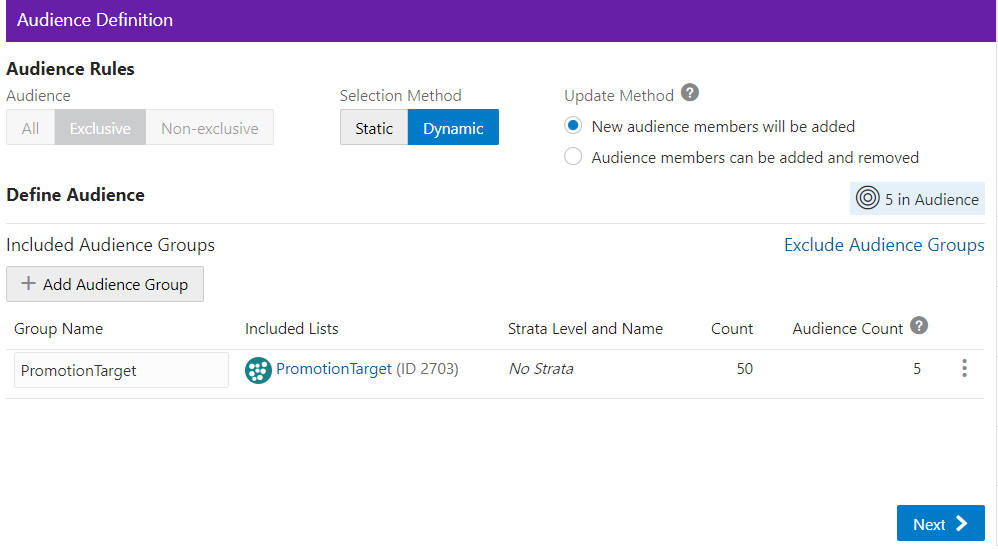
As shown in Figure 5-154 the Count is shown for each audience group. In the Audience Rules section the Audience Count is provided on the right hand side.
Columns include the following details:
-
Group Name
-
Included Lists
-
Strata Name and Level (if applicable)
-
Count
-
Audience Count
Each Group Name has an Overflow Menu Icon where you can Edit or Remove the Audience Group from the list.
The Included Lists column displays a link on that list (also known as a segment) and that link will open to the Audience List Details window.
In this window, the following sections may display, depending on the type of list and which of the options were selected when the list was created:
-
List Options section
-
Criteria section
-
Trend Results section
-
Strata Levels section
-
Attributes section
-
Franchisees section
-
Message section
-
Scheduled Jobs section
Figure 5-155 List Details

The checked List Options vary by the selections made when the list was created, and may include the following fields:
-
Export – Indicates whether the Segment list is automatically exported after the Segment Query is run.
-
Open Access – Indicates whether the Segment has Open Access.
-
Permanent – Indicates whether the Segment is kept in the system, even if it meets the criteria for deletion by the housekeeping job.
-
Public – Indicates whether the Segment is Public.
-
Publish to Batch Exporter – Indicates whether the Segment has been made available for export to a Marketing system.
-
Publish to Clienteling – Indicates whether the Segment has been made available to the Clienteling module.
-
Publish to Task Generator – Indicates whether the Segment has been made available to the Task Generator Job.
-
Save as List – Indicates whether a list of matching Customer IDs is created when the Segment is created.
-
Trend Results – Indicates whether the results of the Segment run are kept to provide trend information about the Segment.
Figure 5-156 displays the Trend Results in a chart. A user can scroll down to see a table as shown in Figure 5-157, which for this segment shows the Strata Levels Against Customer Age and displays the strata that are shown in the graph.
Figure 5-156 List Details Trend Results - Chart

Figure 5-157 Trend Results Graph - Table

Figure 5-158 List Details Trend Results - Table

-
Click Done to close the Audience List Details window.
Figure 5-159 Audience Definition - Exclude Audience Groups

Exclude Audience Groups - If you wish to exclude certain groups of customers that may also be a part of the Included Group, you can do that by selecting the Exclude Audience Groups link, which opens a new section in the Audience Definition window
-
Select the Exclude Audience Groups link.
-
Click + Add Audience Group.
-
Select an Available List type.
-
-
All – Default group listing.
-
Stratified – The Customers within a Stratified list are divided into levels.
-
Unstratified – The Customers within an Unstratified list are not differentiated into separate groups.
-
Personal – User created groups.
-
-
In the Search field, enter some or all of the List Name, ID, or Strata Name.
-
Click Search.
-
The results can be sorted by using the Sort by list menu with the following options:
-
Last Updated
-
Name
-
Customer Count
-
-
Enter a Group Name.
-
Click Add to add the selection Assigned Audience Lists.
-
Click Add for another list means you are using the condition AND. Both conditions must be met.
-
Click OK and Add Another to keep you in the same window and use the condition OR. One or more of the conditions must be met when you click Add for another Audience Group.
-
-
When finished entering all Audience Groups for the Promotion, click Next.
-
Enter the following for the Filtering Audience tab.
Figure 5-160 Filtering Audience Tab

Use the Customer Household Consolidation Selection Menu to indicate whether the Promotion will use household consolidation, and the rule for determining the Customer who is the head of household.
-
None – Do not perform household filtering.
-
LT Sales – Select head of household based on amount purchased over the lifetime of their account.
-
LT Transaction Count – Select head of household based on lifetime number of transactions.
-
Last Transaction Date – Select head of household based on the Customer who performed the most recent transaction.
-
Customer Attributes – Select head of household based on the Customer's numeric attributes.
Select the Filter Type for each Audience:
Figure 5-161 Select Desired Filtering

-
None - [DEFAULT] All Customers in the Audience Group are eligible.
-
Top Sales - Customers from the Audience Group will be chosen for eligibility by the greatest total amount of purchases.
-
Random - Customers from the Audience Group will be chosen randomly for eligibility.
Enter a filter value to indicate the number of customers eligible for the promotion.
-
-
When finished entering any household filtering for the Audience Groups for the Promotion, click Next to continue to the Split Audience tab.
-
In the Split Audience tab, filtered audiences can, optionally, be split into smaller, separate audiences. If desired, create splits for the filtered audiences on the promotion.
-
Click Split.
Figure 5-162 Split Audience Groups

-
The Split Name field is automatically populated from the name of the Audience Group Name. If desired, you can change the name of the splits in this step.
-
Select Split to automatically divide the Audience Group into equal portions and percentages. If you desire different portions or percentages for the splits, enter either a count or a percentage, and the corresponding field will update.
-
-
When finished entering any Audience Group splits for the Promotion, click Next to continue to the Control Groups tab.
-
Enter the following information for the Control Groups tab.
Figure 5-163 Define Control Groups

The control group is a statistically identical group that doesn't receive the offer. Following the promotional period, the results of the two groups are compared and you can determine if the offer generated incremental revenue. Options include:
-
None – No Control Group
-
By Promotion – Enter either a New Count or Percent. The corresponding field will update automatically to determine the size of the control group.
-
By Audience Group – Enter either a Control Group count or percentage for each split created earlier. The corresponding field will update automatically.
-
-
When finished entering any Control Groups for the Promotion, click Next to continue to the Export Channels tab.
-
Enter the following information for the Export Channels tab. The options include:
Figure 5-164 Export Channels Tab

Mail - Determines whether the Customers in the Split/Control Group will be contacted by Mail.
EMail / Batch Exporter - Determines whether the Customers in the Split/Control Group will be contacted by Email.
Note:
The system configuration setting SupportedBatchExporters determines if the Batch Exporter section is displayed.
-
Export Filename – Name of the file.
-
Prefix – Indicates the format of the datetime stamp used as a prefix the filename. Optional. Possible settings are yyyyMMdd_HHmmss, yyyy-MMdd_HHmmss, or none.
-
Static Name – The identifying filename.
-
Suffix – Indicates the format of the datetime stamp used as a suffix the filename. Optional. Possible settings are yyyyMMdd_HHmmss, yyyy-MMdd_HHmmss, or none.
-
Filename – Displays an example of the export file name with the prefix and suffix format, if any.
Phone - Determines whether the Customers are contacted by phone.
Clienteling – When the Clienteling switch is turned on, tasks will be created based on the assigned associates or locations for the defined target audience when the promotion is generated.
Figure 5-165 Clienteling Details

Assign Tasks to:
-
Location Channel – Tasks are assigned to a Location.
-
Associate Channel – Tasks are assigned to an associate in a location.
The following fields are enabled if the Filter option is selected:
-
Max Count Per <type> - Determines the maximum number of target Customers that will be contacted through the channel.
-
Method - Method used to select the Customers contacted. Options include:
-
Random - Select Customers Randomly (Default).
-
Top - Recent Purchase - Filter the Customers based on the most recent purchases.
-
Top - LT Sales - Filter the Customers based on the largest amount purchased over the lifetime of their account.
-
Top - Numeric Attribute - Filter the Customers based on the highest attribute value for a selected numeric attribute. If this option is selected, an additional Channel Filter option, Attribute, displays. Attribute is the numeric attribute used to determine the customers contacted
-
-
-
When finished entering any Export Channels for the Promotion, click Next to continue to the Budget tab.
-
Enter the following information on the Budget tab.
Figure 5-166 Budget Tab

-
Click Add to enter the Promotion Costs. Enter values in any field is optional.
-
Enter a Description of the cost item.
-
Enter the budgeted amount for the Promotion in the Budget Amount field.
-
Enter the actual amount for the Promotion in the Actual Amount field.
-
Click Add if you wish to enter another budget line for the promotion, then follow steps a-d to complete the fields.
If Export Channels were selected for the audience group, the Audience Groups Costs section appears. Entering values in any field is optional.
Figure 5-167 Audience Group Costs

-
In the Budget-Fixed field, enter the fixed cost budgeted for the audience.
-
In the Budget-CPM field, enter the cost budgeted for the Channel for each 1,000 Customers.
-
In the Actual-Fixed field, enter the actual fixed cost of the Channel.
-
In the Actual-CPM field, enter the actual cost of the Channel for each 1,000 Customers.
-
Repeat steps f-i for each Target Channel in the Promotion.
-
-
When finished entering any Budget Costs for the Promotion, click Next to continue to the Save Options tab.
-
Enter the following information in the Save Options tab. You can enter more than one choice.
Figure 5-168 Options After Save Tab

-
Generate – Start a job to generate promotion audience data.
-
Approve – Set this promotion's status to Approved.
-
Export – Start a job to create files for exporting this promotion to an external/POS/batch system. This option automatically approves the Promotion.
-
Dynamic Promotion Options – Select one of the two export options for processing when using the Dynamic selection method on the Audience tab.
Note:
Depending on the type of promotion that you created, different Options After Save are available.
-
-
When finished entering any Save Options for the Promotion, click Next to continue to the Coupon Review tab.
-
The Review tab displays the key elements in the Promotion Setup.
Figure 5-169 Review Tab
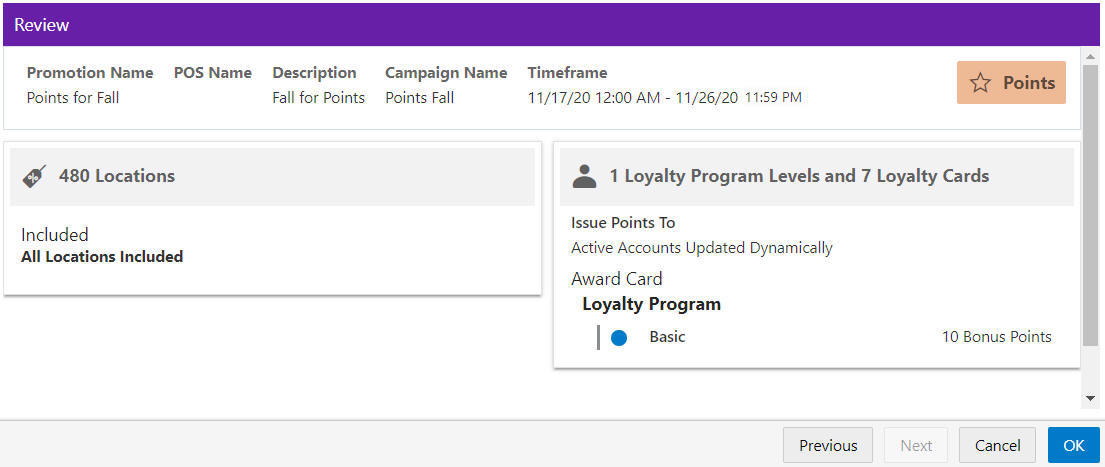
-
Click OK to save the Promotion, or click Cancel to close the promotion without saving. Click Previous or any Tab to return to any point of the Create Promotion process.
Promotion Actions
From within the Promotion Home and Promotion Advanced Search windows, there are different Overflow Menus that enable you to perform some of following actions:
-
Approve – Approves the promotion the user is viewing.
-
Duplicate – Opens a new window enabling the promotion wizard for a copy of the existing promotion.
-
Edit – Opens a new window enabling the promotion for editing.
-
Export Promotion Definition – The definition of the Promotion is exported in a job, and associated export files are then attached to the Export Promotion in the Process Queue page.
Note:
This option is not available for an Award Promotion.
-
Export to Batch – This option exports details about the Promotion, in a job, including the Offers, Attributes, Audience, and Serialized Coupons, if applicable. The files are listed in the Process Queue page under the Promotion Batch Export job for this Promotion.
Note:
This option is available only if one or more types are selected for the Supported Batch Exporter Types property in System Configuration.
-
Generate – Creates generate job that can be accessed via the Job Process Queue.
-
Terminate – This action will terminate the Promotion on the current date as well as disable the associated Offers on the Promotion.
-
View – Opens a new window, displaying the Review tab for the Promotion.
Note:
The options will vary based on the promotion type and the user permissions.
Figure 5-170 Promotion Home Overflow Menu Options: One or More Promotions

From within the Promotion Quick Search window and the Promotion Advance Search window, you can check one or many of the individual promotions using the check box to the left of the Promotion row. Then you can click the Overflow Menu to perform the following actions against the promotions:
-
Approve
-
Export Promotion
-
Export to Batch
-
Terminate
Figure 5-171 Promotion Home Quick Search Overflow Menu Options: Single Promotion

From within the Promotion Quick Search window and the Promotion Advance Search window, you can click the Overflow Menu to the right of the individual promotion, and perform the following actions:
-
Approve
-
Duplicate
-
Edit
-
Export Promotion Definition
-
Export to Batch
-
Generate
-
Terminate
-
View
Editing a Promotion
There are three places that a user can find the Edit option in order to edit a Promotion:
-
Select Edit under the Action Menu (also known as the Overflow Menu) icon for each individual Promotion on the Promotion Advanced Search window.
-
Select Edit in the Overflow Menu on each individual Promotion on the Promotion List window (which displays in the Promotion Home menu).
-
Select Edit in the Overflow Menu for the individual Promotion on the Promotion Scorecard.
Figure 5-172 Edit Promotion

During the editing process an offer can be disabled by clicking the Overflow Menu and selecting Disable. Disabled offers have a Circle rather than a Dot next to the Offer Name.
Figure 5-173 Disable an Offer
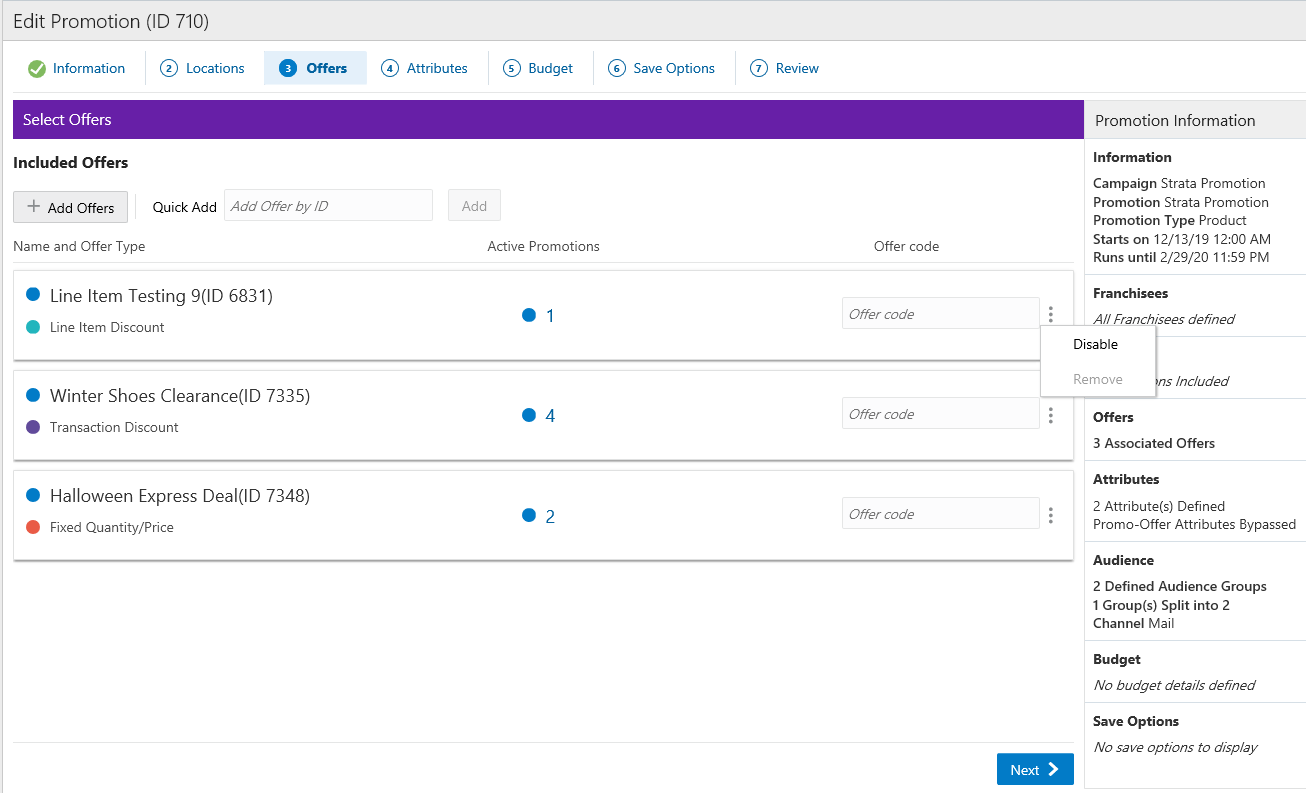
Disabled offers can be enabled by clicking the Overflow Menu and selecting Enable. Enabled offers have a Dot rather than a Circle next to the Offer Name.
Figure 5-174 Enable an Offer

To edit other areas of the promotion, see Creating a Coupon Promotion for detailed information.
Editing a Promotion - Loyalty Bounceback
The Loyalty Bounceback that is available from the Information tab, the Programs tab, and the Offers tab are editable to allow you to modify the programs selected and the bounceback defined after the Coupon/Product promotion is created.
The ability to edit the promotion depends on whether or not the promotion has been generated.
See the following tab options when editing a Coupon/ Product promotion that includes a Loyalty Bounceback:
Information Tab
-
You can change the Bounceback Type if the promotion has not been generated. All other fields can also be edited, with the exception of Campaign.
-
When the Bounceback Type is changed, anything assigned to the offer on the Offers tab, is dropped.
Note:
A warning appears. Click OK to remove all loyalty bounceback details, or click Cancel to close the window without saving.
-
You only have the ability to change the Name, Description and End Date fields after the promotion has been generated.
Programs Tab
-
Existing program selections are set to default and are enabled when editing the promotion if the promotion has not been generated.
-
When the promotion is generated, no changes to the Programs tab will be permitted.
Offers Tab
-
All the fields included on the Offer tab are enabled when editing the promotion, if the promotion has not been generated.
-
Existing offers cannot be removed after the promotion has been generated. However, they can be disabled. Additionally, a previously disabled offer can be re-enabled.
Duplicating a Promotion
To create a new Promotion with the same configurations as the current Promotion:
Note:
Some information will not be copied from the existing
Promotion to the new Promotion:
-
Auto-created Campaigns
-
End Dates in the past
-
Coupon configurations
-
Target information
-
Options after saving
-
There are three places that a user can find the Duplicate option in order to duplicate a Promotion:
-
Select Duplicate under the Action Menu (also known as the Overflow Menu) icon for each individual Promotion on the Promotion Advanced Search window.
-
Select Duplicate in the Overflow Menu on each individual Promotion on the Promotion List window (which displays in the Promotion Home menu).
-
Select Duplicate in the Overflow Menu for the individual Promotion on the Promotion Scorecard.
A copy of Promotion opens in the Promotion Wizard, prompting for the action to perform on the current Promotion.
Figure 5-175 Source Promotion Options

-
-
Select the action to perform on the existing Promotion:
-
Leave it unchanged. – Do nothing to change the existing Promotion.
-
Terminate and export it – Terminate the Promotion and export the termination to the POS systems.
-
Modify its end date and export it – Change the end date for the Promotion and export the Promotion, with its new end date, to the POS systems.
Note:
If you select this option, Customer Engagement prompts for the new End Date and End Time.
-
-
Click Next.
-
Edit the Promotion.
-
Use Wizard Navigation to move through the Wizard.
-
Make any necessary changes.
-
Click Save when you are finished making changes. The Wizard closes, saving the new Promotion and returning to the Promotion List.
-
Click Cancel to exit the Wizard and return to the Promotion List without saving the new Promotion.
-
For more information about the fields and information to be entered, see Creating a Coupon Promotion.
Promotion Scorecard
The Promotion Scorecard displays information about the Customer response to a Promotion.
Viewing the Promotion Scorecard
To access the Promotion Scorecard for summary information on a particular promotion, the user can select the link on the Promotion name on either the Promotion List or the Promotion Search results windows.
To access the Promotion List:
-
From the Main menu, click Tasks.
-
Click Campaign.
-
Click Promotion Home. This should default you to the Promotion List
Note:
You will need the Promotion Home role in order to see this menu option.
Figure 5-176 Promotion Home

To access the Promotion Search results window:
-
From the Main menu, click Tasks.
-
Click Campaign.
-
Click Promotion Search.
-
Enter criteria in the Search panel where you can search for a unique promotion, or click Search to retrieve all promotions.
Figure 5-177 Promotion Search
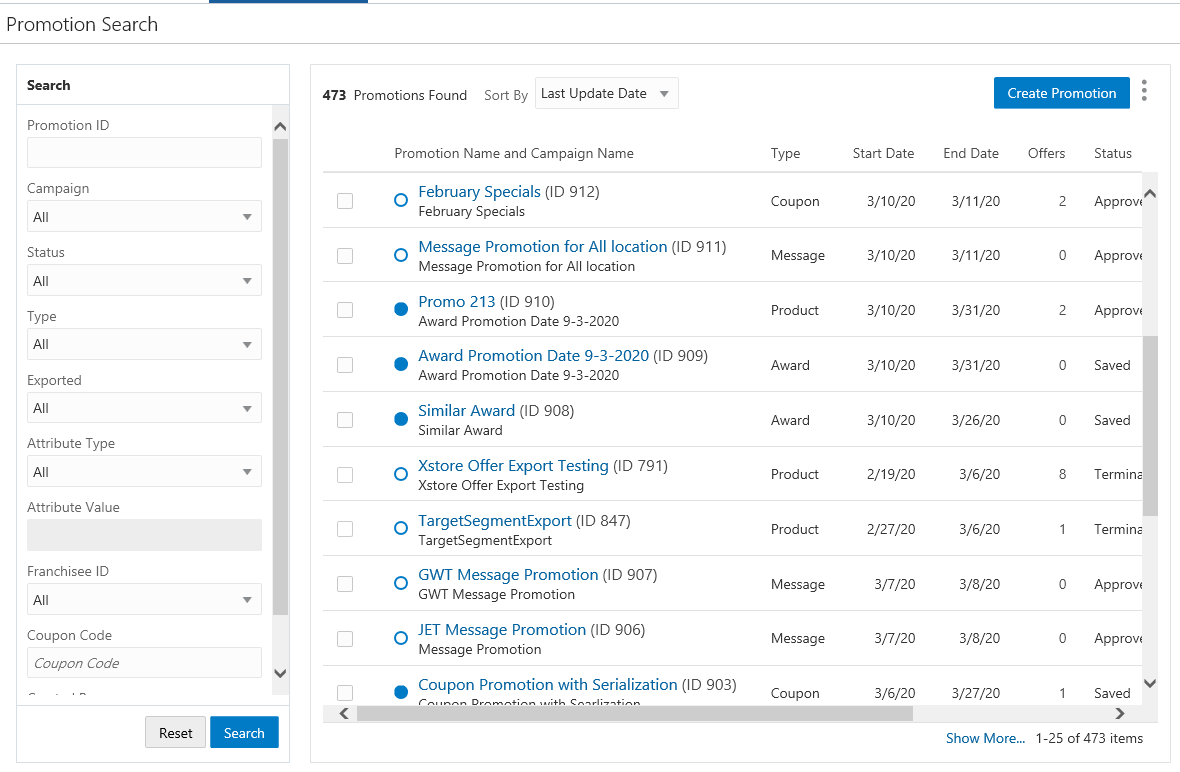
-
Select the link on a Promotion Name, which then opens the Promotion Scorecard for that promotion.
-
Click the Revenue LY Metric Tile to see the following information:
Figure 5-178 Promotion Scorecard - Revenue LY Metric Tile View

The Promotion Scorecard window displays the following sections:
-
Title section (displays on all windows) – this contains the name and ID of the Promotion as well as an indicator of whether the promotion is currently active or inactive (a solid Blue Dot represents an Active Promotion while an Empty Dot represents an Inactive Promotion).
-
Metric Tiles (displays on all windows) – The following metric tiles are included for the Promotion Scorecard:
-
Revenue LY
-
Average Transaction
-
Response Rate
-
Loyalty Points (Loyalty Only)
-
Average Points Per Transaction (Loyalty Only)
-
-
Filter/Sort Options
Filtering and sorting options for the Promotion Performance graph (displays only for the Revenue LY and Loyalty Points Metric tiles) - The following filter choices allow you to change the display in the Promotion Performance graph, and they include:
-
All – Displays total for All offers combined.
-
By Offer – Displays totals by individual offer.
-
Display all Offers – Filter the offers you wish to display in the Promotion Performance graph. This button is only available when By Offer is activated.
-
Figure 5-179 Filter Offers to Display
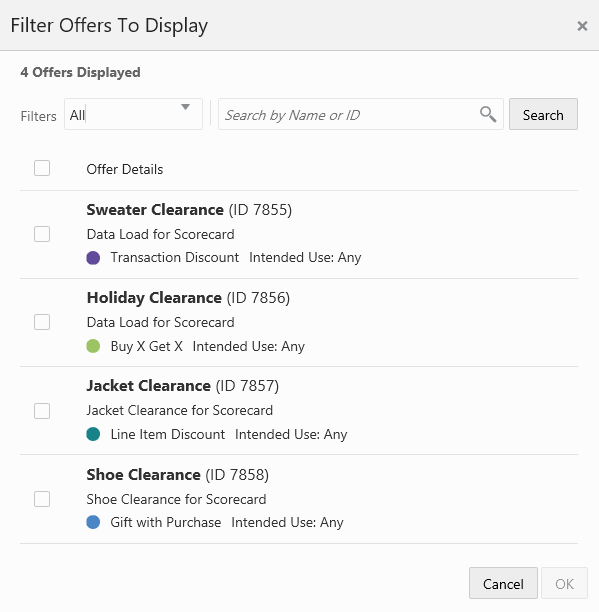
The Filters menu options on the Filter Offers to Display popup window will include the type of Offers that exist on the Promotion you are viewing.
-
In the Filter Offers to Display popup window, you can also search by Name or ID and click Search to retrieve the list of offers on this promotion.
-
From the list of filtered offers, select the check box for each offer you wish to display on the Promotion Performance graph.
-
Click OK to display the offers in the graph, or click Cancel to return to the Scorecard without saving any filters.
Duration
-
Last Week
-
Last Month (Default)
-
Last 6 Months
-
Last Year
-
Lifetime to Date – Offer performance for last five years
The Promotion Performance graph (displays only on the Revenue LY Metric tile) includes the following fields:
-
Revenue
-
Duration
The Promotion Information panel (displays only for the Revenue LY, Loyalty Points, and Average Points Per Transaction Metric tiles) See Promotion Information - Scorecards for more information.
-
-
Click the Average Transaction Metric Tile to see the following information:
Figure 5-180 Promotion Scorecard - Average Transaction Metric Tile Summary for a Product Promotion
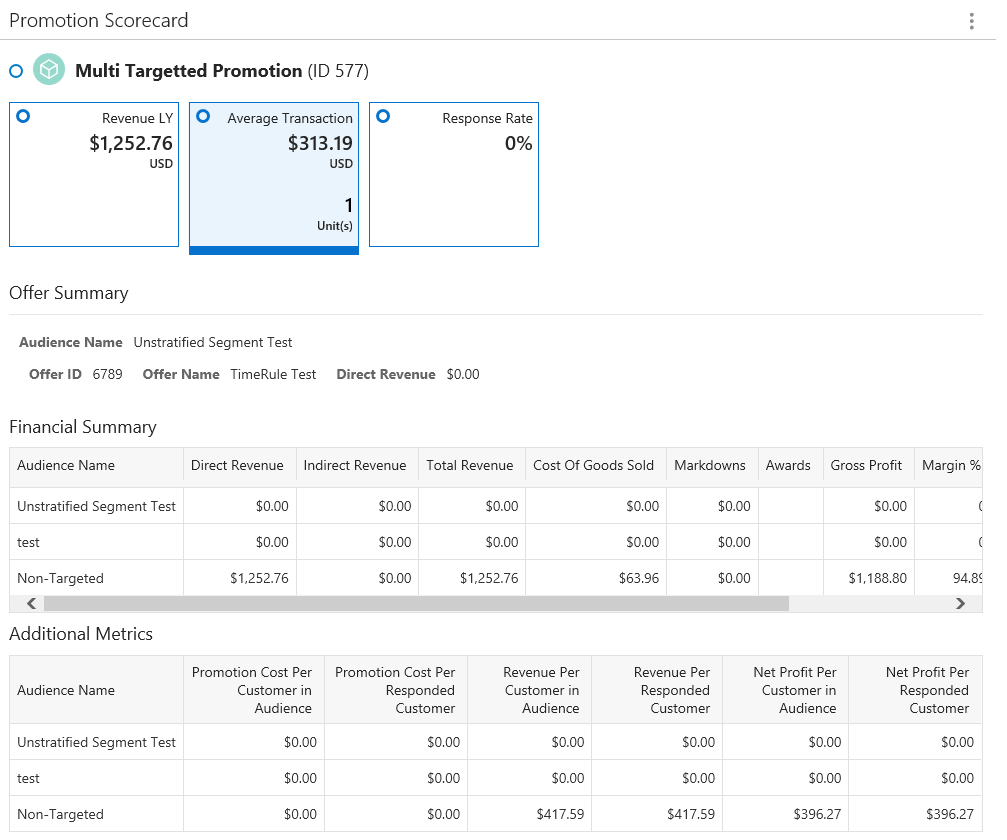
Offer Summary – data displayed will depend on whether the promotion is a Product or Coupon Promotion. Award and Message type Promotions will not display an Offer Summary section.
-
Audience Name
-
Offer ID
-
Offer Name
-
Direct Revenue
Financial Summary
-
Audience Name
-
Direct Revenue (Apply to Coupon Promotions Only)
-
Coupon Code
-
Respondents
-
Transactions
-
Value Of Discount
-
Average Sales By Coupon
-
Coupon Revenue
-
Estimated Distribution
-
Response %
-
-
Indirect Revenue
-
Total Revenue
-
Cost of Goods Sold
-
Markdowns
-
Awards
-
Gross Profit
-
Margin %
-
Promotion Cost
-
Net Profit
Additional Metrics
-
Audience Name – Name of the group of customers targeted for the Promotion.
-
Promotion Cost Per Customer in Audience – Cost of the Promotion per Customer targeted by the Promotion.
-
Promotion Cost Per Responded Customer – Cost of the Promotion per Customer who responded to the Promotion.
-
Revenue Per Customer in Audience – Revenue received from the Customers who were targeted for the Promotion.
-
Revenue Per Responded Customer – Revenue received from the Customers who responded to the Promotion.
-
Net Profit Per Customer in Audience – Net Profit from the Customers who were targeted for the Promotion.
-
Net Profit Per Responded Customer – Net Profit from the Customers who responded to the Promotion.
-
-
Click the Response Rate Metric Tile to see the following information which can be viewed by All Customers, Active, or Inactive:
Figure 5-181 Promotion Scorecard - Response Rate Metric Tile
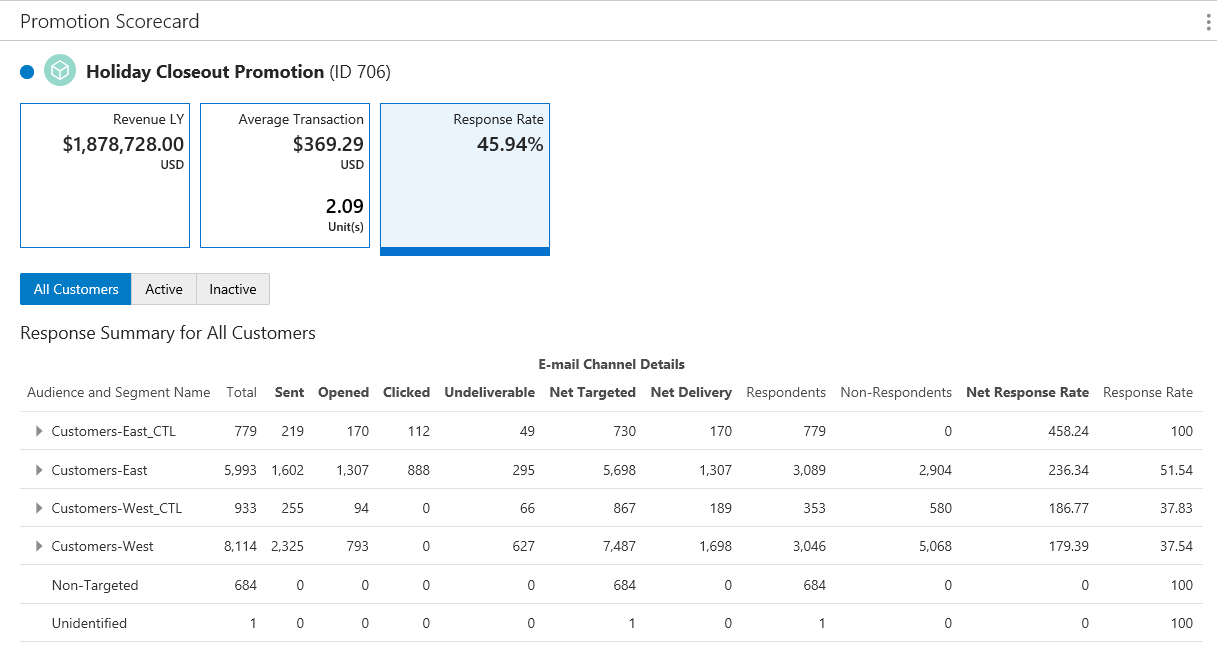
-
Audience and Segment Name - Name of the target. A target name ending in _CTL indicates a control group. Non-Targeted is displayed as the Target Name for customers who responded to the Promotion but were not included in Target Groups.
-
Total - Number of Customers to whom emails were sent because they were in the Target Group. For Non-Targeted totals, this is the number of non-targeted customers who responded.
-
Sent - Number of emails sent. This total is 0 for Non-Targeted customers.
-
Opened - Number of emails opened.
-
Clicked - Number of emails clicked on.
-
Undeliverable - Number of emails that could not be delivered.
-
Net Targeted - Total customers - Undeliverable emails.
-
Net Delivery - Total number of emails Sent - Undeliverable emails.
-
Respondents - Number of Customers in the Target who have responded to the Promotion. This is the same as the Total for Non-Targeted customers.
-
Non-Respondents - Number of Customers in the Target who have not responded to the Promotion. This is 0 for Non-Targeted customers.
-
Net Response Rate - Calculated by dividing the total number of Respondents by the Net Delivery total. Set to 0.00 for Non-Targeted customers.
-
Response Rate - Calculated by dividing the total number of Respondents by the Total number targeted. Set to 100.00 for Non-Targeted customers.
-
Award Value - The total value of Awards issued through the promotion. Included only for an Award Promotion.
-
Redeemed Award Value - The total value of Awards redeemed. Included only for an Award Promotion.
-
-
Click the Loyalty Points Metric Tile to see the following information which can be viewed by All Customers, Active, or Inactive:
Note:
For Points Promotions, the Loyalty Tile displays differently. See Figure 5-183 followed by the description for this type of promotion.
Figure 5-182 Loyalty Points Metric Tile
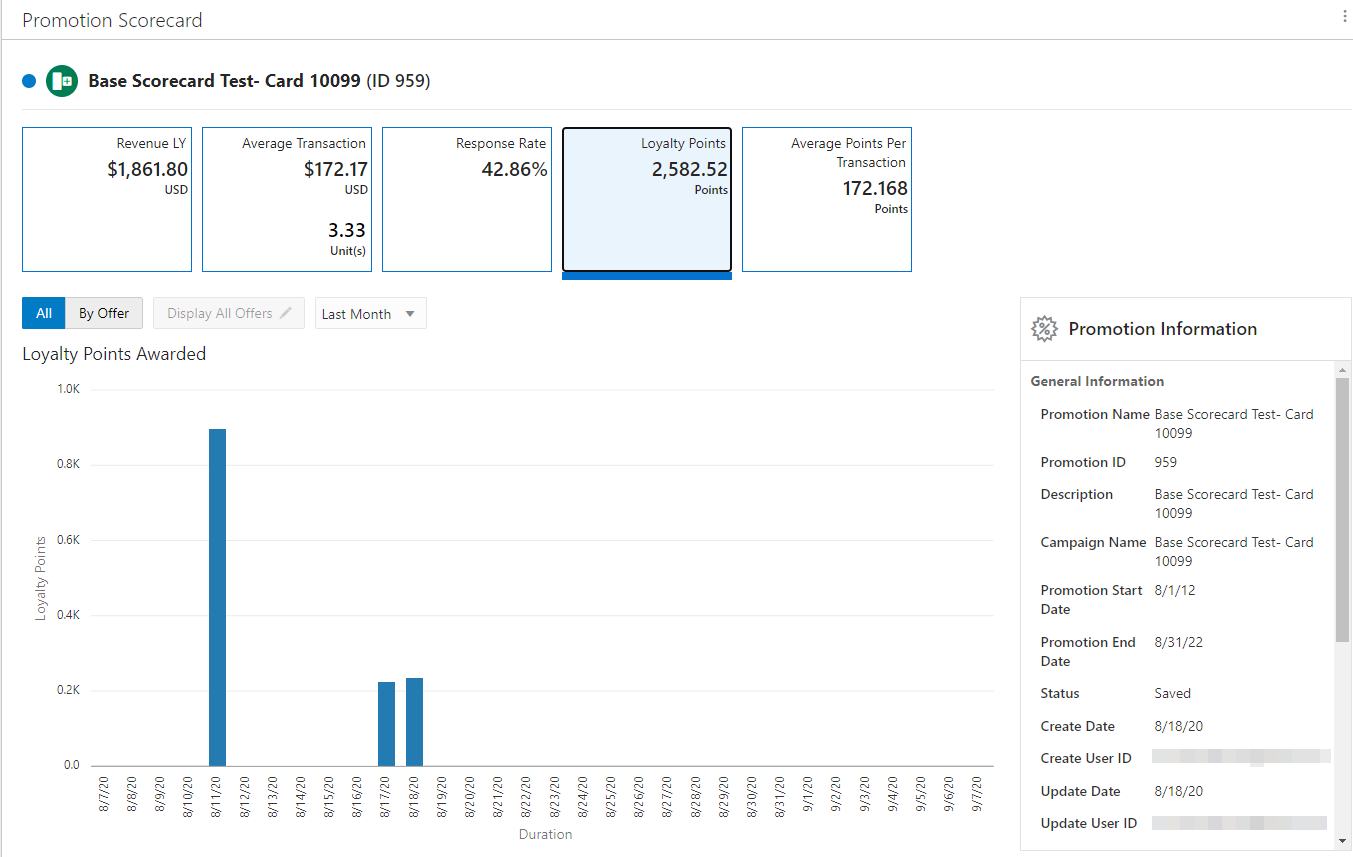
Graph
-
The bar graph will dynamically update the Loyalty Points Awarded based on the Offers selected and Duration.
-
By default the performance graph displays the offer details based on the time period selected for this promotion.
-
The graph represents a plot between the Loyalty Points on Y-axis and Duration on X-axis for each individual Promotion.
Note:
See Filter/Sort Options for sorting and filtering options for the Loyalty Points Awarded graph.
Figure 5-183 Loyalty Points Metric Tile - Points Promotion Scorecard
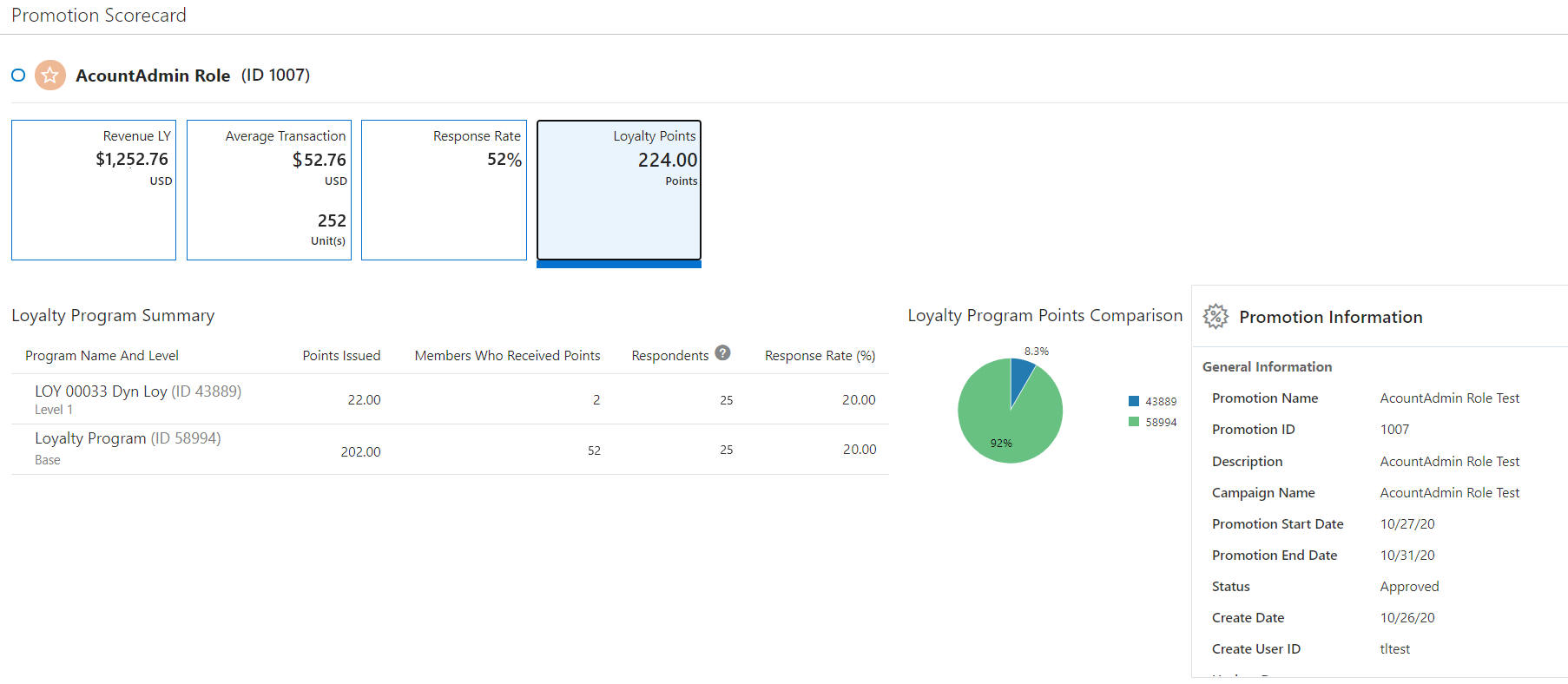
Note:
This is a promotion type specific to the loyalty program and issues loyalty points to specific card loyalty programs. The purchase totals are based on the selected customers/loyalty members receiving the Points promotion. There are no offers (triggering events) that are required to receive the points. The total purchases are based strictly on the customers that are part of the promotion. There are no items to exclude as we would do in the case of a promotion with offers.
Note:
The values displayed in the scorecard will include only indirect revenue. The indirect revenue is based on all purchases made by the customers that received loyalty points. This scorecard is used to analyze the stimulation in revenue based on issuing loyalty points. However, these transactions cannot be tied directly to specific purchases.
-
Loyalty Program Summary
-
Program Name and Level
-
ID
-
Points Issued
-
Members Who Received Points
-
Respondents - Members who received points that also made a purchase during this promotion period.
-
Response Rate {%}
-
-
Pie Chart
-
Calculates and displays the Total Points Issued by program and level.
-
Each sector of the pie chart represents the points awarded to the unique program and level with a different color.
-
The table lists all the levels, but the pie chart will only show the top ten based on points issued.
-
-
Promotion Information
-
General Information
-
Export / Approve Status
-
-
-
Click the Average Points Per Transaction Metric Tile to see the following information which can be viewed by All Customers, Active, or Inactive:
Figure 5-184 Average Points Per Transaction Metric Tile
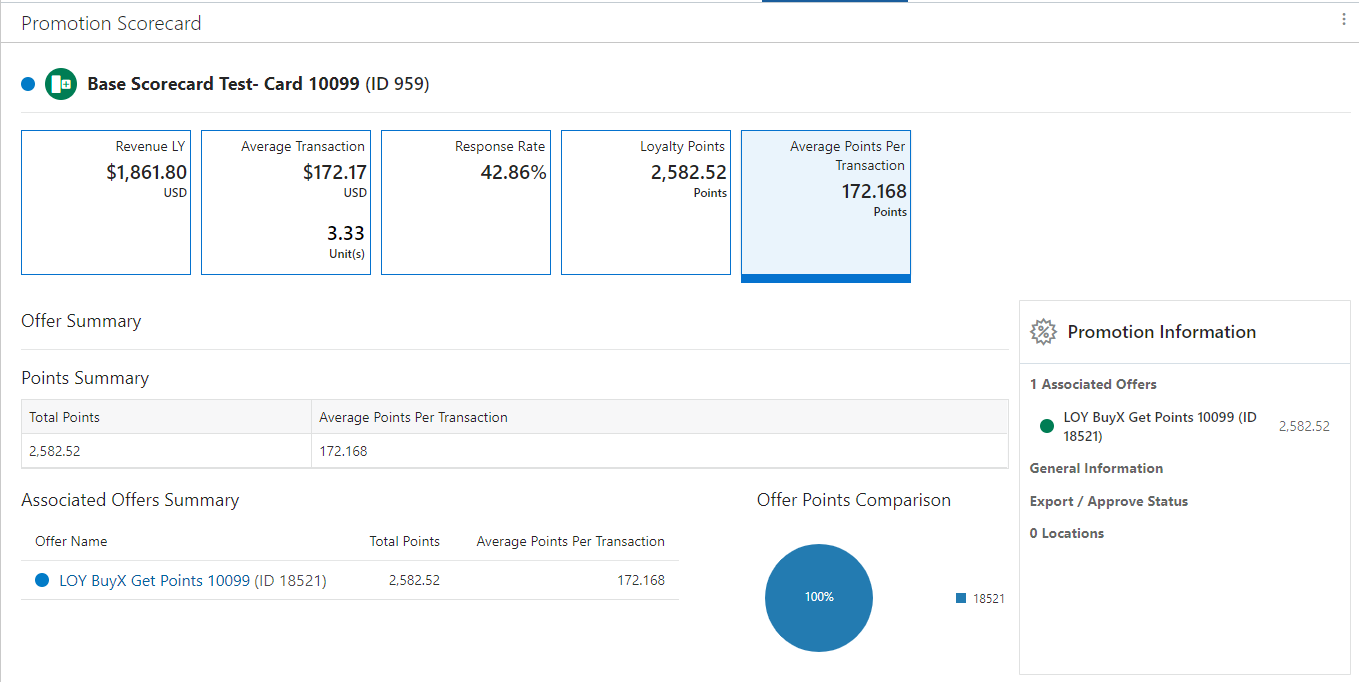
Offer Summary - Points Summary
-
Total Points – Sum Total of the Points generated using the offer.
-
Average Points Issued Per Transaction – Average number of points issued per Transaction during the Promotion period to the members against their purchase activity. The Average Value (Total Points issued/Number of Transaction).
Associated Offers Summary
-
A full circle represents an Active Offer or an empty circle represents an Inactive Offer.
-
Offer Name
-
When a user selects the offer name from the list of offers on the Promotion Scorecard window, the system displays the View Offer window for the selected promotion on the same tab. See Viewing Offers for more information.
-
-
Total Points - Total points distributed for the offer.
-
Average Points Per Transaction - Average number of points issued per Transaction during the Promotion period to the members against their purchase activity. The Average Value (Total Points issued/Number of Transaction).
Offer Points Comparison
-
The pie chart shows the pictorial representation of the points distributed from the respective offers.
-
The title of the pie chart is Offer Points Comparison.
-
The maximum of top ten offers by direct revenue display.
-
Each sector of the pie chart represents the points distributed by an individual offer with a different color.
-
A legend displays to the right of the pie chart and is linked with the information displayed in the pie chart.
Note:
To close the Promotion Scorecard, click the close icon X associated with the Promotion Number in the Open Tasks area at the top of the window.
-
Promotion Information - Scorecards
The Metric Tiles that display Promotion Information include:
-
Revenue LY
-
Loyalty Points
-
Average Points Per Transaction
Figure 5-185 Promotion Information - General Information (All Tiles)
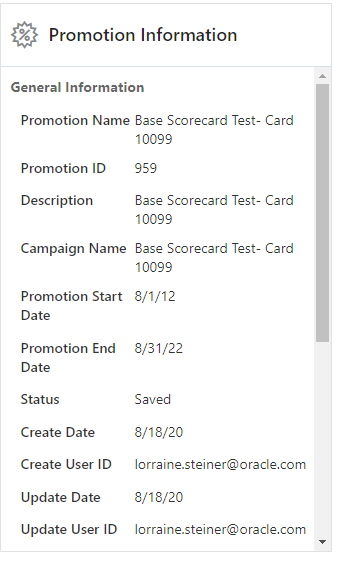
Figure 5-186 Promotion Information - Export/Approve Status (All Tiles)
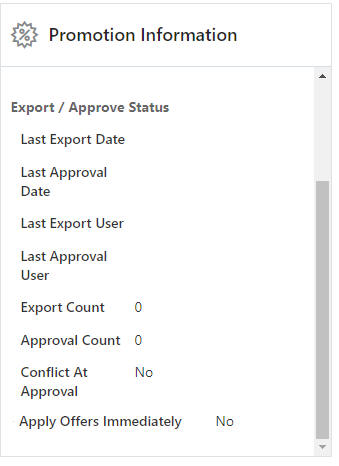
Note:
Depending on the type of promotion that you created, different Export/Approve Status are available.
Figure 5-187 Promotion Information - Associated Offers (Average Points Per Transaction Tile Only)
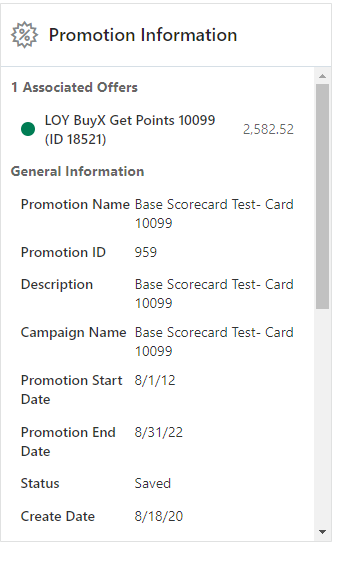
Promotion Information - Tabs
Many of the tabs also include the Promotion Information panel on the right side for each tab. This information summarizes what has previously been configured for the Promotion. The tabs that display Promotion Information include:
-
Information
-
Franchisees
-
Awards
-
Locations
-
Offers
-
Attributes
-
Coupons
-
Audience
-
Event Definition
-
Budget
-
Save Options
Figure 5-188 Promotion Information Panel
